Kedarnath Temple Blog
Kedarnath Temple Opening Date, Booking, Distance, Weather, Char Dham Yatra 2024 in Uttarakhand.
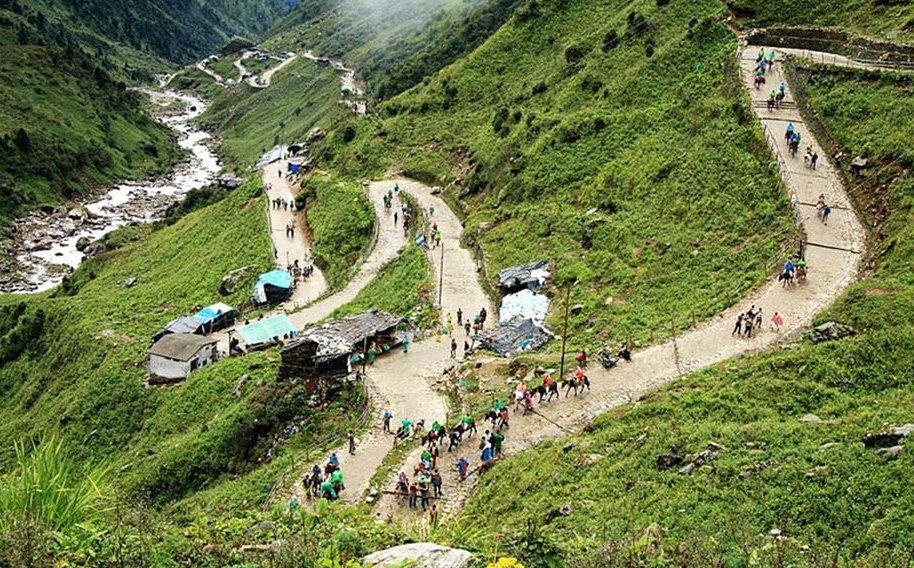

Kedarnath Trek – 16 Km (Travel Guide)
The Kedarnath trek is one of the most challenging and difficult treks in India. But it got easier when pilgrims chant the name of Kedar Baba (Lord Shiva). Here in this article, we have shared a complete travel guide for the trekking tour at Kedarnath Temple.
About Kedarnath Trek
Kedarnath Trek is a popular pilgrimage and trekking destination in the Indian state of Uttarakhand. The trek leads to the Kedarnath temple, one of the four major shrines in Hinduism, located at an altitude of 3,583 meters (11,755 feet) above sea level.
The trek to Kedarnath starts from a place called Gaurikund, which is located at a distance of 16 km from Kedar Nath Temple. The trek takes you through some beautiful and scenic landscapes, including lush green forests, waterfalls, and streams.
The route is steep and challenging in some places, but the stunning views of the Himalayan peaks make it all worth it.
Best Time To Visit Kedarnath Trek
The best time to undertake the Kedarnath trek is from May to June and from September to November, as the weather during these months is mild and pleasant.
During the monsoon season, which is from July to August, the trek can be risky due to the possibility of landslides and flooding.
The Kedarnath trek is considered a holy pilgrimage by Hindus, and thousands of devotees undertake this trek every year to seek the blessings of Lord Shiva.
However, it is also a popular trekking destination for adventure enthusiasts and nature lovers who want to experience the beauty of the Himalayas up close.
Best Time for Char Dham Visit
- Best Time To Visit Kedarnath
- Best Time To Visit Badrinath
- Best Time To Visit Gangotri
- Best Time To Visit Yamunotri
Kedarnath Trek Distance and Time
- The distance of the Kedarnath Trek is around 16 km (one way) from Gaurikund to Kedarnath Temple.
- The trek can be completed in a minimum of 2 days, with a one-night halt at Kedarnath, or it can be completed in a single day by experienced trekkers.
- The trek from Gaurikund to Kedarnath takes around 6-7 hours to complete, depending on the fitness level of the trekker.
On the first day, trekkers usually cover a distance of around 7-8 km from Gaurikund to Kedarnath. The trek route passes through scenic locations like Jangal Chatti, Bheembali, Rambara, Lincholi, and Chhani Camp which are popular camping sites, and there is a hot water spring also.
On the second day, trekkers can explore the Kedarnath temple and surrounding areas and start the return journey to Gaurikund. The return journey takes around 5-6 hours to complete and covers a distance of around 9 km.
Can I Complete Kedarnath Trekking Non-stop?
Yes, Most of the young people complete the Kedarnath trek in one go. and Stay at Kedarnath Temple at the night and then return the next day.
- A young person with a good fitness level can complete this 16km trek in 6-7 hours (non-stop) while going upside to the temple. (Upward direction)
- Returning time for the same distance will be around 5 hours . (Down direction)
Up-Down Daily Timings by the Temple Authority
- Last Timing for Upcoming Visitors – 5 Pm (Evening)
- Last Timing for Downgoing Visitors – 6:30 PM (Evening)
It is important to note that the duration of the trek may vary depending on the fitness level of the trekker and the weather conditions.
It is always advisable to undertake the trek under the guidance of an experienced trekking guide and to carry essential gear and supplies for the trek.
Don’t forget to check out this Best-selling TREKKING Bag on Amazon

Kedarnath Trek Route Map (New)
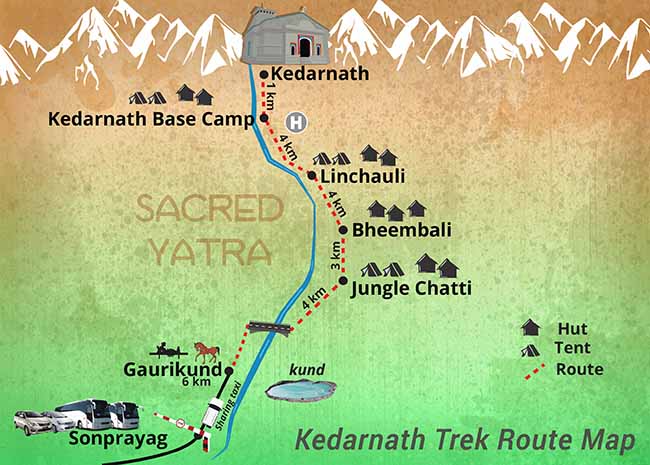
There are mainly 10 Checkpoints in the route of the Kedarnath Trek. These checkpoints are shown below in the order they come during the 16km trekking.
- Gaurikund (गौरीकुंड)
- Jangal Chatti (जंगल चट्टी)
- Bheembali (भीमबली)
- Rambara (रामबाड़ा)
- Chhota Lincholi (छोटी लिंचोली)
- Lincholi (लिंचोली)
- Chhani Camp (छानी कैंप)
- Rudra Point (रूद्र पॉइंट)
- Base Camp (बेस कैंप)
- Kedarnath Temple (केदारनाथ मंदिर)
Kedarnath Trek Route Length
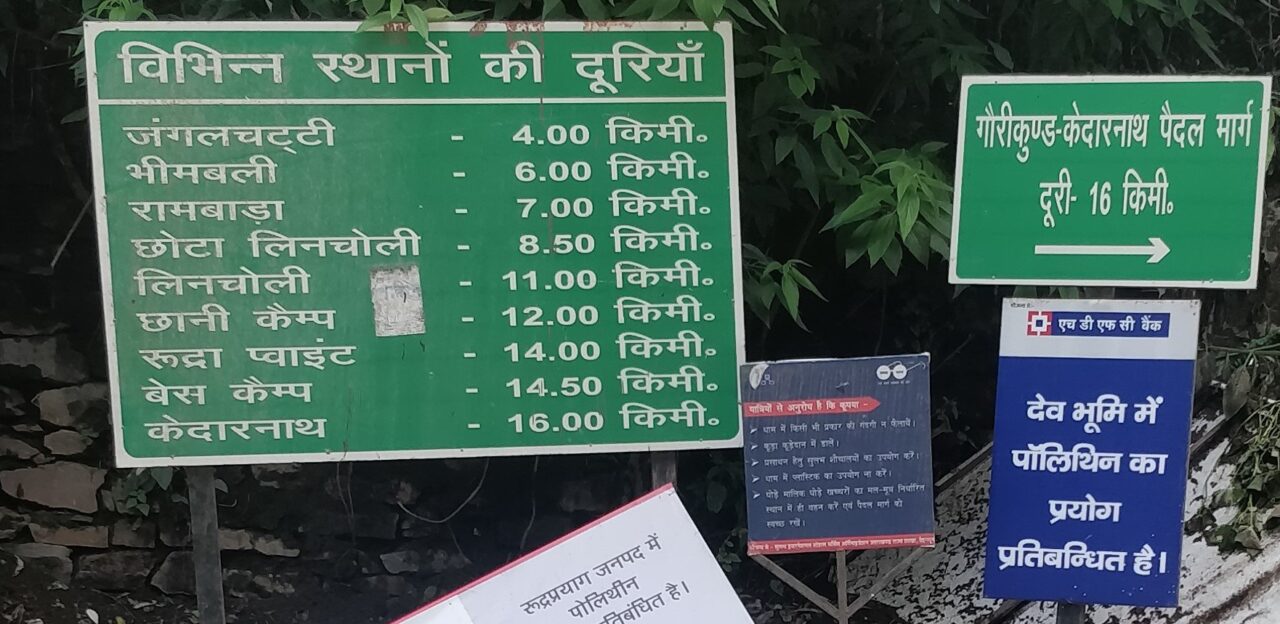
- Gaurikund To Jangle Chatti/Bhairon Chatti distance is 4 km.
- Jangle/Bhairon Chatti To Bheembali distance is 3 km.
- Bheembali To Linchauli distance is 4 km.
- Linchauli To K. Base Camp distance is 4 km.
- K. Base Camp To Kedarnath Temple distance is 1 km.
Char Dham Distance from Delhi
- Delhi to Kedarnath (466 km)
- Delhi to Badrinath (555 km)
- Delhi to Gangotri (530 km)
- Delhi to Yamunotri (485 km)
Gaurikund to Kedarnath Trek
Gaurikund is a Hindu pilgrimage site and base camp for trek to Kedarnath Temple. It is situated at an altitude of 6502 feet above mean sea level in the Garhwal Himalayas in the Rudraprayag district of Uttarakhand.
There are various options available at the starting point (Gaurikund) of the Kedarnath Trek. To complete the trek route, you have three options there.
- by Walking (Trekking)
Read More: Gaurikund to Kedarnath Guide
Explore Kedarnath
- History of Kedarnath
- Weather i n Kedarnath
- Hotels i n Kedarnath
- Meditation Cave i n Kedarnath
- 21 Facts About Kedarnath
- Kedarnath Yatra 2023 Guide
Here are the most Frequently Asked Questions about Kedarnath Trek.
How long is Kedarnath Trek?
The length of the Kedarnath Trekking route is around 16-18 kilometers from Gaurikund to Kedarnath temple.
How much time does it take for Kedarnath Trek?
The Kedarnath Trekking usually takes 2 days to complete (If stops midway for rest). And for a young fit person, it takes 6-7 hours to reach the Kedarnath temple. (nonstop)
From Where Does Kedarnath Trek Start?
The Kedarnath Trekking route starts from Gaurikund.
How difficult is Kedarnath Trek?
The Kedarnath Trekking is considered a moderate to difficult level.
How many km is Trek to Kedarnath?
The trekking route to Kedarnath is around 16 kilometers one way.
How to prepare for Kedarnath Trek?
To prepare for the Trek, one should focus on physical fitness, pack appropriate clothing and gear, carry essential items like water and food, and acclimatize to the high altitude.
What to wear in Kedarnath Trek?
For Trekking at Kedarnath, it is recommended to wear comfortable trekking shoes, quick-drying pants and t-shirts, a warm jacket, a hat, sunglasses, and sunscreen. It is also important to carry rain gear and warm clothes for the night as the temperature can drop significantly.
Which trek is more difficult Kedarnath or Amarnath?
Kedarnath and Amarnath’s treks are both considered challenging, but the Kedarnath trekking is comparatively easier than the Amarnath. (due to the difference in the distance)
How steep is Kedarnath Trek?
The Kedarnath Trek is considered a moderate to difficult level, with several steep ascents and descents along the route.
The trekking route involves walking uphill for a significant portion of the journey, with an altitude gain of around 3,550 feet (1,082 meters) from Gaurikund to Kedarnath.
The terrain can be rocky and uneven at times, and there are several sections of the trail that require careful footing and a good level of fitness. The steepness of the trek can vary depending on the specific route taken and the individual’s level of physical fitness.
Overall, the Kedar Trek is a challenging but rewarding experience, with stunning views of the Himalayan mountain range and opportunities to explore the region’s natural beauty and cultural heritage. It is important to prepare properly and take necessary precautions to ensure a safe and enjoyable trekking experience.
Things to carry for Kedarnath Trek?
Some of the essential things to carry for the Kedarnath Trekking are comfortable trekking shoes, warm clothes, rain gear, sunscreen, sunglasses, a hat, a first aid kit, sufficient water and snacks, and a backpack to carry all the gear. It is also recommended to carry a trekking pole and a camera to capture the beautiful views.
Here is a list of things to carry for the Kedarnath Trekking:
- Clothing: Carry warm clothing such as thermals, fleece jackets, and windcheaters. It can get chilly at night, so bring a warm hat and gloves as well. Wear quick-dry, breathable clothes that are comfortable to trek in. Also, carry an extra set of clothes for emergencies.
- Footwear: As discussed earlier, wear comfortable and sturdy hiking boots or shoes with good grip and ankle support.
- Backpack: A good quality backpack with a capacity of around 40-50 liters is recommended to carry your essentials. It should have padded straps and a waist belt for better support.
- Sleeping Bag: Carry a good quality sleeping bag that is rated for the appropriate temperature range.
- Trekking Poles: Trekking poles help provide extra support and balance on uneven terrain. They are particularly useful when ascending or descending steep slopes.
- Water Bottles : Carry at least 2-3 liters of water, and ensure drink enough water throughout the trek.
- First Aid Kit : Carry a well-equipped first aid kit with essential medicines, band-aids, antiseptics, pain relievers, and any prescription medication you may require.
- Sunscreen, Sunglasses, and Hat : Protect yourself from the harsh sun by carrying sunscreen with SPF 50+, sunglasses with UV protection, and a hat.
- Personal Toiletries : Carry a small towel, hand sanitizer, wet wipes, toilet paper, and any personal toiletries you may require.
- Power bank and Extra Batteries : Carry a good quality flashlight or headlamp with extra batteries for use during early morning starts, late evening walks, or in case of power outages.
Remember to pack light and carry only essentials for the trek. Avoid carrying unnecessary items that add weight to your backpack.
Kedarnath Trek Itinerary?
Here’s a brief itinerary for the Kedarnath Trek:
- Day 1: Reach Gaurikund and hike to Kedarnath (16-18 km)
- Day 2: Explore Kedarnath and acclimatize to the high altitude
- Day 3: Trek back to Gaurikund (16-18 km)
Note : The duration of the trek can be extended depending on the fitness level of the trekker and weather conditions.
Best shoes for Kedarnath Trek?
The best shoes for Kedarnath Trekking are comfortable and sturdy trekking shoes with good grip, ankle support, and waterproofing to tackle the steep and rocky terrain.
Some good options for shoes for the Kedarnath Trek include hiking boots or shoes from well-known brands such as Salomon, Merrell, or The North Face. It is important to break in your shoes before the trek and wear them around for a few weeks to ensure that they are comfortable and fit well.
Trekking to Kedarnath at the night is generally not recommended as it can be quite risky and dangerous. The trek is quite challenging, and even during the day, it requires a good level of fitness and stamina.
Trekking at night can be more challenging due to low visibility and increased chances of slipping, tripping, or losing the trail.
Moreover, the trail to Kedarnath is located in a remote mountainous region with steep inclines, rocky terrain, and unpredictable weather conditions. It can be risky to trek in the dark without proper lighting, equipment, and a guide. There have been cases of trekkers getting lost or injured during night treks to Kedarnath.
Therefore, it is advisable to trek to Kedarnath during the daytime when the weather and visibility are better, and there is more help available in case of emergencies.
If you do plan to trek at night, it is essential to prepare adequately, carry appropriate gear, and seek the advice of experienced guides or local authorities.
1 thought on “Kedarnath Trek – 16 Km (Travel Guide)”
- Pingback: How To Reach Kedarnath From Delhi: Route Distance (466 km)
Leave a Comment Cancel reply
Save my name, email, and website in this browser for the next time I comment.
Kedarnath Trek Timings
Nestled amidst the majestic Himalayan peaks, the sacred pilgrimage to Kedarnath Temple stands as a testament to devotion and endurance. However, amidst the awe-inspiring beauty lies the unpredictable nature of the mountainous terrain, necessitating strict adherence to trek timings for the safety and well-being of pilgrims.
- Starting before from Gaurikund – 1.50 PM
- Starting before from Kedarnath – 5.00 PM
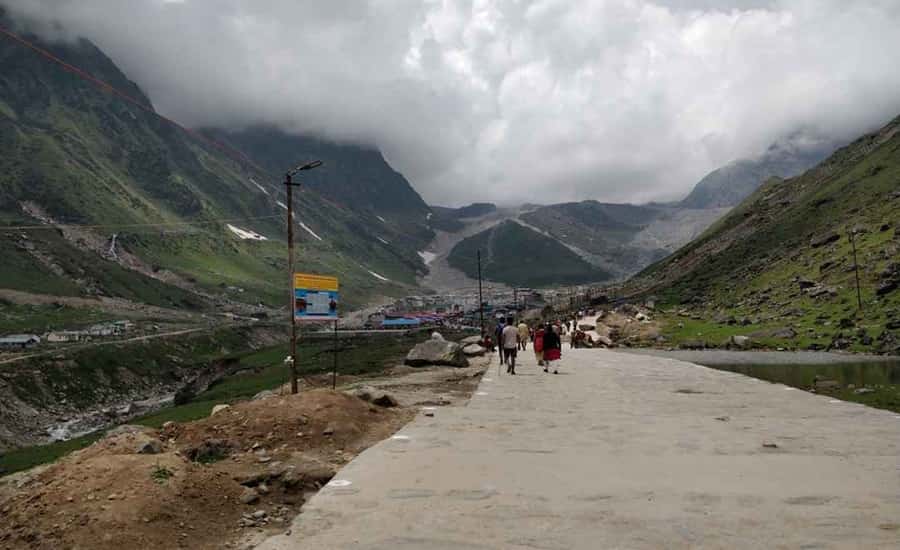
Table of Contents
Adapting to Nature’s Whims
The trek to Kedarnath is a journey of faith and resilience, but it is also one that demands respect for the elements. The District Magistrate of Rudraprayag, recognizing the imperative of safeguarding pilgrims, has mandated revised trek timings, acknowledging the influence of adverse weather on the pilgrimage route.
Morning Departures, Afternoon Cutoffs
Pilgrims embarking on the sacred journey must heed the call of dawn, commencing their trek from Gaurikund to Kedarnath before the clock strikes 1:30 pm. This time window ensures ample daylight for progress while mitigating the risks associated with traversing mountainous paths after dusk. Beyond this deadline, the gates of departure close, emphasizing the significance of timely commencement.
A Haven Amidst the Clouds
Sonprayag, the gateway to the revered pilgrimage, serves as the initial checkpoint for pilgrims venturing towards Kedarnath. However, owing to the capricious nature of weather patterns, pilgrims are advised against setting forth from Sonprayag after 10:30 am. This precautionary measure aims to prevent pilgrims from encountering treacherous conditions en route, prioritizing their safety above all else.
- Also Read : Kedarnath Yatra Route Map
Honoring the Return Journey
As pilgrims bow before the divine presence of Lord Shiva at Kedarnath, their descent from the sacred abode is equally pivotal. Departing from Kedarnath before 5:00 pm is not merely a logistical necessity but a testament to prudence and foresight. The descent, though downward in trajectory, demands as much vigilance as the ascent, underscoring the cyclical nature of pilgrimage and the symbiotic relationship between reverence and responsibility.
A Symphony of Safety
The orchestration of trek timings for Kedarnath is a harmonious blend of tradition and pragmatism. The administration’s unwavering commitment to pilgrim welfare is palpable in every decree, every directive aimed at fostering a sanctuary amidst the rugged expanse of the Himalayas.
Navigating the New Norm
In adherence to the directive issued by the District Magistrate of Rudraprayag, the pilgrimage to Kedarnath now unfolds within the confines of prescribed timings. Pilgrims are implored to depart from Sonprayag no later than 1:00 pm and from Gaurikund by 1:30 pm, embracing the rhythm of the mountains and surrendering to the wisdom of moderation.
An Ode to Vigilance
Bhimbali and Lincholi, though enigmatic in their allure, mark the thresholds of prudence. Pilgrims must halt their journey by 5:00 pm and 6:00 pm, respectively, paying homage to the sanctity of dusk and the imperative of retreat. In these twilight hours, safety eclipses aspiration, and the mountain whispers its cautionary tales.
The pilgrimage to Kedarnath is not merely a physical odyssey but a spiritual communion with the divine. In navigating the treacherous terrain, pilgrims tread not only upon the earth but upon the legacy of reverence and resilience that defines their journey. And amidst the towering peaks and swirling mists, the sanctity of time stands as a beacon of guidance, guiding pilgrims through the labyrinthine paths of faith and fortitude.
Suggested Tour
- Kedarnath Tour Packages
- Kedarnath Yatra from Delhi
Leave a Reply Cancel reply
Your email address will not be published. Required fields are marked *
Save my name, email, and website in this browser for the next time I comment.
This site uses Akismet to reduce spam. Learn how your comment data is processed .
Plan Your Trip Our expert will get in touch with you shortly
Mobile No *
We never share your Information.

Recent Posts
How to reach kedarnath from mumbai.
- Top 5 Things To Do With Your Family On A Chardham Yatra By Helicopter Trip
- Lakshman Temple, Rishikesh
- Dehradun Tourist Attraction
- Chardham Yatra Helicopter Route Map
Nestled amidst the majestic Himalayas, Kedarnath is a revered pilgrimage site and a haven for spiritual seekers. If you're planning a journey to this sacred destination from Mumbai, fret not, for there are multiple routes and modes of transportation available to make your pilgrimage smooth and memorable. Here's a comprehensive guide on how to reach Kedarnath from Mumbai: By Flights Mumbai, b...
May 3, 2024
Booking Helicopter Tickets for Kedarnath
Nestled amidst the majestic Himalayas, Kedarnath is one of the holiest pilgrimage sites for Hindus, drawing millions of devotees every year. Located in the Indian state of Uttarakhand, reaching Kedarnath involves navigating challenging terrain. While trekking remai...
April 18, 2024
How to Reach Kedarnath from Delhi
The pilgrimage to Kedarnath, nestled amidst the Himalayas, is not merely a journey but a spiritual odyssey for countless devotees. Each year, from various corners of the nation, pilgrims embark on this sacred expedition seeking solace and divine blessings. For thos...
April 5, 2024
Haridwar to Kedarnath Guide
The journey from Haridwar to Kedarnath transcends mere physical travel; it's a pilgrimage deeply rooted in spirituality, adventure, and the awe-inspiring grandeur of the Himalayas. Let's delve into the intricacies of this sacred odyssey, from the distance covered t...
April 3, 2024
Kedarnath Trek | Complete Guide, Cost, Itinerary
Region: Uttarakhand
Base Camp: Gaurikund
Grade: Moderate
Distance: 32 Km
Min Age: 8 Years+
Best Season: Summer and Autumn
Trek Description
The Kedarnath trek is a transformative journey deep into the heart of the Himalayas, where nature’s grandeur intertwines with deep spiritual significance. Nestled in the Garhwal Himalayas of Uttarakhand, India, this trek leads to the sacred Kedarnath Temple, a place of profound devotion dedicated to Lord Shiva.
This pilgrimage holds historical importance dating back over a thousand years. The temple is believed to have been constructed by Jagad Guru Adi Shankaracharya. Kedarnath is part of the Panch-Kedar, a group of five temples associated with the Pandavas from the Mahabharata.
It was at this sacred site that the Pandavas sought Lord Shiva’s forgiveness for their actions in the epic, and the temple represents the “back side” of Lord Shiva, set amidst the awe-inspiring Himalayan landscape.
The best time to undertake your journey to the sacred Kedarnath Temple is typically from May to October, aligning with the temple’s opening date on April. This window offers favorable weather conditions and clear pathways, allowing pilgrims to access the main temple of Kedarnath without hindrance.
It’s important to keep in mind that from early November to mid-April, the Kedarnath Temple experiences temporary closure due to heavy snowfall and challenging weather conditions, making the temple inaccessible during this period.
The trek to Kedarnath is known for its accessibility to trekkers of various fitness levels. It is generally considered suitable for all levels during most of the year, making it an inclusive and spiritual journey.
The flora and fauna encountered on this journey add to its charm. The route takes you through lush forests and introduces you to rare wildflowers. At higher altitudes, juniper and Brahma Kamal thrive, enhancing the region’s biodiversity.
The trek also offers glimpses of Himalayan Musk Deer, the colorful Himalayan Monal (Uttarakhand’s official bird), Himalayan Tahr, the elusive Snow Leopard, Himalayan Black Bear, and majestic Himalayan Griffon Vultures soaring in the skies.
It’s believed that the temple was miraculously saved by a massive rock at its rear, revered as “Bheem Shila.” The trek provides opportunities for spiritual reflection as it leads through lush meadows, serene landscapes, and pristine wilderness. Kedarnath is also part of the Char Dham Yatras, the four sacred pilgrimage sites in Uttarakhand.
The Kedarnath trek is a harmonious blend of natural splendor, deep spiritual devotion, historical significance, and profound experiences. It connects trekkers with the divine essence nestled in the heart of the Himalayas.
Drive Distance : 183 km
Drive Time : 7-8 hours
Altitude : 4,500 ft
Your spiritual journey commences as our team picks you up from Rishikesh, a vibrant city that sets the stage for this remarkable adventure. Enjoy a scenic drive covering approximately 180 kilometers, immersing yourself in the breathtaking beauty of the Himalayan landscapes.
As you embark on this soul-enriching expedition, you’ll be treated to awe-inspiring mountain vistas, with the majestic Ganga River accompanying you on your journey. Your path will lead you through several significant checkpoints, each holding its unique charm and significance.
Devprayag: Your first stop, Devprayag, is a place of profound spiritual importance. Here, the holy Alaknanda and Bhagirathi rivers merge to form the sacred Ganga River, marking the inception of your Panch-Kedar pilgrimage. The divine confluence of these sacred waters sets the tone for your spiritual odyssey.
Rudraprayag: Your journey continues to Rudraprayag, where the confluence of the Alaknanda and Mandakini rivers offers another spiritually charged experience. Here, nature’s beauty combines with spiritual significance, providing another opportunity to connect with the divine through the merging of these holy waters.
Agastyamuni: Further along your route, you’ll reach Agastyamuni, a place resonating with the spiritual energy of Rishi Agastya’s meditation. It’s a site where the ancient sage delved deep into his spiritual practice, adding another layer of sacredness to your expedition.
Ukhimath: Your path then leads you to Ukhimath, a town known for its spiritual ambiance and serene surroundings. It’s a place where you can immerse yourself in introspection and soak in the tranquil beauty of the Himalayas.
Guptakashi: Finally, you will arrive at Guptakashi, where you will rest for the night. Guptakashi holds its own significance in the Panch-Kedar pilgrimage. It’s the place where Lord Shiva concealed himself from the Pandavas, prompting Yudhishthira to give it the name “Guptakashi,” signifying the “Hidden Kashi.”
Trek Distance : N/A
Altitude Gain : N/A
The next morning, your journey continues as you depart from Guptakashi and embark on a 27-kilometer drive to Sonprayag, a pivotal starting point for your trek to Kedarnath. The drive itself offers captivating views of the Himalayan landscapes and sets the stage for the beauty that awaits.
The trek from Sonprayag to Kedarnath covers a total distance of 19 kilometers and is a breathtaking adventure. As you ascend through lush meadows, pristine wilderness, and serene beauty, you’ll be captivated by the spiritual energy of the Himalayas. This path not only tests your physical endurance but also provides ample opportunities for introspection and connection with nature.
Altitude : N/A
On this day, you’ll retrace your steps, trekking back from the sacred destination of Kedarnath to Sonprayag. The 19-kilometer trek offers a different perspective of the Himalayan terrain, allowing you to soak in the majestic vistas and the spiritual serenity surrounding you.
Upon reaching Sonprayag, you’ll continue your journey back to Guptakashi, where you can reflect on the profound experiences of the past days.
Drive Time : N/A
As your sacred pilgrimage comes to a close, you’ll embark on the final leg of your journey. The drive from Guptakashi to the vibrant towns of Haridwar or Rishikesh covers a distance of 220 kilometers, taking approximately 8-9 hours.
Along the way, you can reminisce about the transformative experiences, spiritual connections, and breathtaking landscapes that have enriched your soul on this extraordinary adventure.
What’s Included?
Price inclusion.
- Transportation : Transportation from Rishikesh and back to Rishikesh is included in the package.
- Accommodation : Enjoy comfortable stays during your trek with accommodation in hotels, guesthouses, or dormitories, offered on a twin, triple, or dormitory sharing basis. When camping, rest in spacious tents on a double or triple sharing basis.
- Meals : We provide nourishing and delicious vegetarian meals. Our meals are designed to keep you energized throughout the trek.
- Camping Fees/Permits : All necessary trekking permits and woodland camping fees are included in the package, ensuring a hassle-free experience.
- Trek Equipment : We provide essential trekking equipment, including dining tents, kitchen tents, sleeping tents with mattresses, and sleeping bags. Utensils, ropes, micro-spikes, and gaiters (if required) are also part of our equipment offerings.
- Qualified Team : Our team comprises experienced and qualified guides, helpers, and porters who are dedicated to making your trek safe and enjoyable.
- First Aid : A first aid kit with an oxygen cylinder and a helmet (if required) is available to address any potential health concerns during the trek.
- Expert Assistance : You can always reach out to our experts for any queries or assistance during your trekking journey. Simply contact us at +91-8089693825
Price Exclusion
- Mules or Porters for Personal Bags : The service of mules or porters to carry personal bags is not included and can be arranged at an extra cost.
- Emergency Costs : Any expenses arising from emergencies during the trek are not included in the package.
- Tips : Tips for the trekking team are optional and not included in the package.
- Items Not Mentioned : Any expenses or items not mentioned in the inclusion section are not covered.
- Stay at Dehradun : Accommodation and meals in Dehradun on the last day of the trek are not included.
- Meals During Transportation: Meals during transportation are not included.
- GST : A 5% Goods and Services Tax (GST) is applicable and not included in the package.
Things to Carry
- 45-60 Ltr Bag Pack With Rain Cover & Comfortable Straps
- Hot & Cold Water Bottle Like Borosil & Milton
- Energy Bar, Dry Fruits & ORS
- Personal Medical Kit
- 2/3 Full Sleeves (Non-Cotton)
- 1 Full Fleece T-Shirt
- 1 Fleece Jacket (Woollen Or Sweater)
- 1 Down Feather/Hollofil Jacket
- 1 Waterproof Jacket/Poncho
- 1 Pair Thermal Inners (Upper And Lower)
- 2 Trek Pants (Avoid Shorts & Denim Pants)
- 1 Pair of Waterproof Gloves
- 1 Pair of Woollen Gloves
- Woollen Cap
- 4 Pairs Of Cotton Socks
- 1 Pair Of Woollen Socks
- 1 Pairs Of Sunglasses (U/V Protected)
- 1 Neck Gaiters (Buff)
- 1 Waterproof & High Ankle Trekking Shoes
- 1 Pair Of Floaters
- Hand Sanitizer & Sunscreen Lotion
- Toothbrush And Toothpaste
- Toilet Paper And Wet Wipes
- Quick Dry Towel
- Lip Balm & Antibacterial Powder
- Moisturizer
How To Reach Kedarnath
Rishikesh is easily accessible by road and is connected to major cities in northern India. You can hire a taxi or take a bus from cities like Delhi, Haridwar, or Dehradun. Rishikesh has a well-maintained bus station, and you can find both government and private bus services that connect it to nearby towns and cities. Bus journeys offer an economical and convenient way to reach Rishikesh.
The nearest railway station to Rishikesh is Yog Nagri Rishikesh Railway Station, which is well-connected to major Indian cities. From there you have to go to Rishikesh Bus Stand or Natraj.
Raithal is the point where we start our Dayara Bugyal Trek in Uttarakhand. It is approximately 183 kilometers away from Dehradun, which takes around 6 to 7 hours by public transportation. To reach Raithal you have to reach Uttarkashi first.
The bus to Uttarkashi leaves early in the morning around 5:30 am from Dehradun Hill station. You can also book your ticket online via the UTC portal. The average cost of the ticket is around 350 to 400 INR. Shared taxi option is also available.
If you are traveling via taxi, you will be charged around 400 to 500. You can hire a taxi from Rispana Pul and Parade Ground to Uttarkashi. Upon reaching Uttarkashi, you can rent another taxi to Raithal from Uttarkashi Taxi Stand. You must pay 100 to 150 INR to hire the taxi.
Difficulty Level of Kedarnath
The Kedarnath trek is renowned for its accessibility and moderate difficulty level, making it a pilgrimage destination that welcomes travelers of various fitness levels. This inclusivity allows individuals with differing physical capabilities to undertake this sacred journey with relative ease.
The trek typically falls within the moderate category, striking a balance that accommodates both experienced trekkers and those new to such adventures.
Adding to its appeal, Kedarnath is accessible during the summer months from May to October, aligning with the temple’s opening on April. This window offers favorable weather conditions and clear pathways, making it an ideal time for pilgrims to access the Kedarnath temple without hindrance.
The combination of a moderately challenging trek and the temple’s accessibility during the summer months underscores Kedarnath’s reputation as a sacred destination that caters to pilgrims and visitors from all walks of life.
Best Time to do Kedarnath
The best time to undertake your journey to the sacred Kedarnath Temple is typically from May to October, aligning with the temple’s opening date around April. This window offers favorable weather conditions and clear pathways, allowing pilgrims to access the main temple of Kedarnath without hindrance.
It’s important to keep in mind that from early November to mid-April, the Kedarnath Temple experiences temporary closure due to heavy snowfall, making the temple inaccessible during this period.
More Info Regarding Kedarnath
After the tumultuous events of the Mahabharata, the virtuous Pandavas were burdened by deep remorse. Their participation in the great war had led to the deaths of their kin, revered teachers, and countless others, and they understood that these sins could hinder their path to ultimate soul liberation, known as “Moksha.”
The Pandavas’ actions during the Mahabharata, including the use of deceitful tactics on the battlefield of Kurukshetra, did not find favor with Lord Shiva, the divine protector of righteousness. In their sincere pursuit of redemption, they sought Lord Shiva’s heavenly vision, believing that his blessings held the key to absolving their grave sins.
As the Pandavas journeyed towards the majestic Himalayas, they reached Lord Shiva’s sacred presence, where they encountered an enigmatic turn of events. In his infinite wisdom, Lord Shiva chose to hide his true form and test the sincerity of the Pandavas’ penance.
Lord Shiva, the cosmic dancer, transformed into a sacred bull, Nandi, and found refuge amidst the serene Himalayan landscapes. The Pandavas unknowingly witnessed this divine bull from afar, standing before their beloved deity. Recognizing that their sins were not fully atoned for, Yudhishthira, the wise leader among the Pandavas, proclaimed that the place where Lord Shiva had concealed himself would be named Guptakashi, signifying the “Hidden Kashi.”
Nakul and Sahadev, the observant brothers, were the first to notice the unique bull and shared their discovery with Bhima, the strongest Pandavas. Driven by unwavering devotion, Bhima embarked on a quest to capture the divine being.
As Bhima approached, Lord Shiva chose to merge with the earth itself, disappearing. Bhima’s steadfast faith enabled him to perceive the divine presence that had merged with the earth. Legend has it that as Bhima sought to catch Lord Shiva, the earth yielded to his devotion, and numerous divine Lingas (representations of Lord Shiva) emerged from the ground. These Lingas became sacred pilgrimage sites, each enshrining a fragment of the divine essence.
This journey of the Pandavas, seeking Lord Shiva’s forgiveness and redemption, became a profound spiritual odyssey, leaving a trail of sacred sites known for their significance and spiritual potency. This tale of divine concealment, discovery, and revelation continues to inspire countless pilgrims and seekers on their spiritual quests.
The Kedarnath trek offers a mesmerizing encounter with the flora and fauna of the Himalayas, enhancing the spiritual journey with its rich biodiversity. The region’s vibrant flora includes a variety of species that come to life in different seasons. In spring, the landscape is adorned with brilliant red, pink, and white wildflowers, creating a stunning natural tapestry.
The evergreen forests provide not only a breathtaking backdrop but also shade and lush greenery along the hiking pathways. Of special note is the Brahmakamal , Uttarakhand’s state flower, which reaches its peak of uniqueness and beauty during the monsoon season. Higher altitudes bring the graceful presence of juniper and wildflowers, further enriching the area’s botanical diversity.
Himalayan Balsam is renowned for its exploding seed pods that scatter seeds extensively, contributing to the region’s regeneration. Cyananthus Lobatus , with its bell-shaped blooms in shades of blue or purple, graces the upper Himalayan areas. Himalayan geraniums produce exquisite pink to purple blooms, making them a favorite decorative plant in gardens.
Anaphalis Margaritacea , known as pearly everlastings, retains its color even after drying, often used in dried flower arrangements. The Himalayan Bistort , known as Bistorta affinis, is another noteworthy species that thrives in the Himalayas, adding to the region’s botanical charm.
The fauna of the Kedarnath region is equally captivating. The Himalayan Musk Deer , though secretive, occasionally graces the deep woodlands with its presence. Known for its special scent glands that produce musk, these creatures are unique and fascinating.
The Himalayan Monal , Uttarakhand’s official bird, captures attention with its stunningly colorful plumage and enchanting vocalizations, making it a delightful sight for birdwatchers. The Himalayan Tahr , a robust herbivorous mammal, can be spotted in the alpine meadows of the Himalayan region.
The Himalayan Black Bear , an omnivore, resides in the woods near the Himalayas and plays an essential role in the local ecosystem. Finally, the Himalayan Griffon Vulture soars gracefully on thermals, contributing to the ecological balance by effectively scavenging carrion and preserving the health of the alpine environment.
This diverse array of flora and fauna adds depth and wonder to the spiritual journey through the Kedarnath trek, connecting pilgrims with the natural beauty and biodiversity of the Himalayas.
- Har Ki Dun Valley: It’s like stepping into a postcard with its stunning beauty. The valley is known for its dense forests, green meadows, and spectacular views of snow-capped mountains. You might even encounter some exciting flora and fauna along the way.
- Kedarkantha: This place is like a winter wonderland! It’s a popular trekking spot, especially during the winter months when the snow-capped peaks make for a magical experience. The views of the Himalayas from here are breathtaking.
- Osla Village: Osla is a quaint and traditional Himalayan village. It’s a hidden gem situated in the Tons Valley and provides a peek into the local culture and way of life in the region. It’s often a stop or part of a treks to Har Ki Dun and nearby areas.
- Bali Pass: This trek is not for the faint of heart! Bali Pass is a challenging high-altitude trek that connects the Tons Valley to the Yamunotri Valley. It offers breathtaking vistas of the surrounding peaks but requires an excellent trekking experience due to its difficulty.
- Ruinsara Lake: This lake is like a hidden treasure located at a high altitude. It’s a serene glacial lake with crystal-clear blue waters. The surrounding landscapes are breathtaking, making it a perfect spot to unwind and enjoy nature’s beauty.
- Dumdhar Kandi: A lesser-known but equally captivating trekking spot, Dumdhar Kandi offers a trail less frequented by tourists. It’s known for its scenic beauty and tranquility, allowing trekkers to experience nature in its raw form.
Map of Trail
Kedarnath temple was built by Jagad Guru Adi Shankaracharya.
Kedarnath temple is said to be more than 1,200 years old.
The two peaks visible from the Kedarnath valley are Kedar Peak and Kedar Dome.
The sacred river that flows through Kedarnath is Mandakini.
/ Per Person
5% GST & + 1,500 INR Transportation Cost
Cancellation Policy
Available Dates
Similar Treks
Kuari pass trek, gidara bugyal trek, dayara bugyal trek, kedartal trek, leave a comment cancel reply.
Save my name, email, and website in this browser for the next time I comment.
Terms & Conditions
Call us at 8089693825
Subscribe to our newsletter
Get news and discounts straight to your inbox
We are Associated With
Himalayan Dream Treks
We believe in making the Himalayas more than just a destination; we see them as a life changing experience. Whether you seek spiritual enlightenment, have a passion for trekking, or simply crave adventure, we're here to accompany you on your journey.
Important Links
Why Choose Us?
Advance Payment
Cancellation Policy & Refund
Privacy Policy
Terms & Condition
Career At HDT
Contact Details
+91-80896 93825
+91-94565 46051
[email protected]
Office Address
Dehradun Office :
10 B, Mothorowala Rd, Dharampur, Ajabpur Kalan, Dehradun, India, Uttarakhand, 248001
© All rights reserved 2024 Himalayan Dream Treks
(To the Himalayas and Beyond)
🎲 Selamat Datang Di Situs Bandar Togel dan Toto Slot Gacor Terpercaya 2024 🎲

Item added to your cart

Bakautoto : Situs Bandar Togel Online dan Situs Toto Slot Resmi Terpercaya
Couldn't load pickup availability
Seiring perkembangan jaman, bakautoto telah menempatkan dirinya sebagai bandar togel resmi dan Situs toto slot terpercaya dengan menawarkan keseruan bermain hingga bonus togel dan slot yang di berikan sangatlah banyak. Bergabunglah bersama bakautoto slot dan rasakan sensasi kemenangan besarnya.

- Choosing a selection results in a full page refresh.
- Opens in a new window.
Join Our Newsletter
Join our subscribers list to get the latest news, updates and special offers directly in your inbox
The Ultimate Guide to Kedarnath Trek Time
Planning a visit to kedarnath discover the best time to trek to this divine destination. explore kedarnath trek time, faqs, and expert insights in this comprehensive guide..
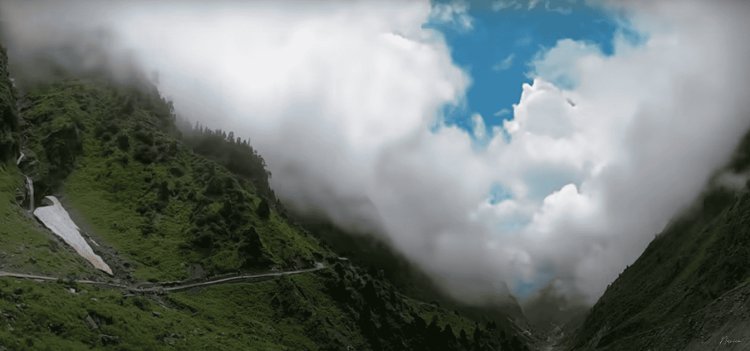
Introduction
When to embark on the kedarnath trek, spring (april to june), monsoon (july to september), autumn (october to november), winter (december to march), kedarnath trek time: a day-to-day breakdown, day 1: arrival in rishikesh, day 2: rishikesh to gaurikund, day 3: gaurikund to kedarnath, day 4: darshan and return.
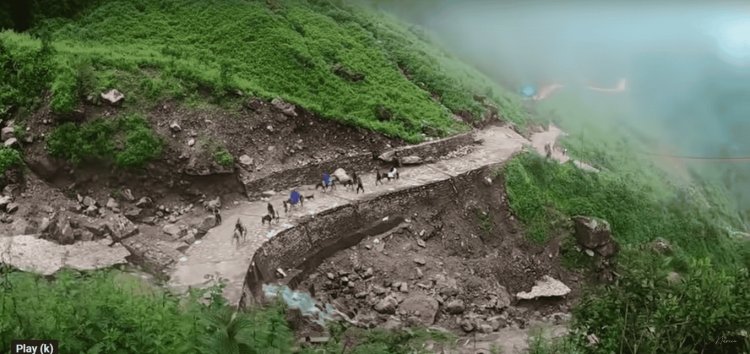
Kedarnath Trek Best Time
Kedarnath trek seasons - , 1. summer season (may to june), 2. monsoon season (july to september), 3. post-monsoon season (october to november), 4. winter season (december to april), best time for kedarnath trek, preparing for the trek, faqs about kedarnath trek time, how difficult is the kedarnath trek, can i trek to kedarnath during the monsoon season, is it possible to visit kedarnath in the winter, what should i pack for the kedarnath trek, are there accommodations available along the trek route, is there mobile network coverage during the trek, what's your reaction.

ankitksisodia
Related Posts
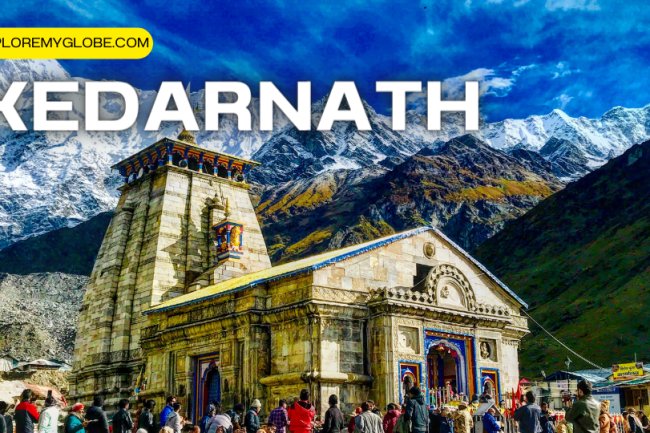
Kedarnath Opening Date 2023: A Spiritual Awakening Awaits!

Kedarnath Temple Opening Date 2023: Your Spiritual Odyssey Begins
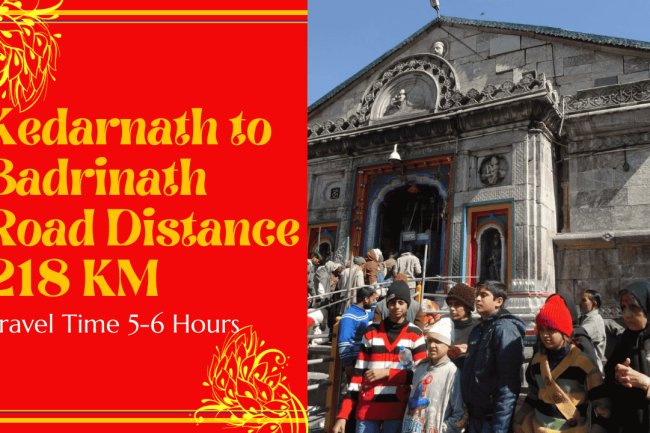
Pilgrimage of a Lifetime: Kedarnath to Badrinath Distance and Journey
Popular posts.

Mumbai to Kedarnath Distance, Flight and Train Ticket P...
ankitksisodia Sep 18, 2023 0 1040

Planning Your Journey: Haldwani to Kedarnath Distance G...
ankitksisodia Oct 7, 2023 0 918

Ahmedabad to Kedarnath Train Ticket Price 2023: Afforda...
ankitksisodia Sep 19, 2023 0 510

Gaurikund to Kedarnath Journey – Tips, Routes, and More...
ankitksisodia Oct 9, 2023 0 505

हरिद्वार से बद्रीनाथ की दूरी: यात्रा गाइड, रूट और अनुभव...
ankitksisodia Oct 10, 2023 0 479
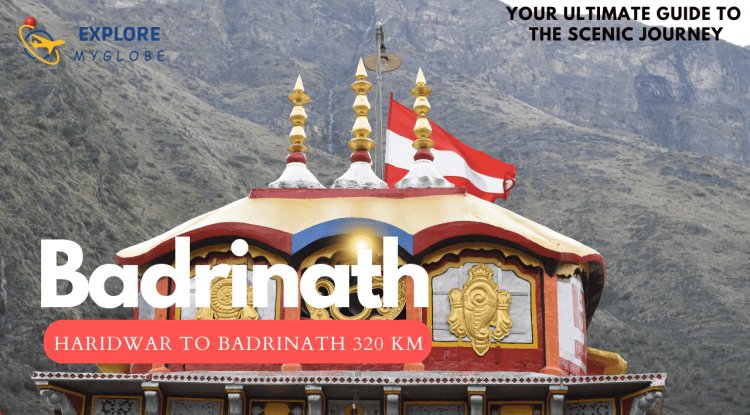
Haridwar to Badrinath Distance: Your Ultimate Guide to ...
ankitksisodia Oct 10, 2023 0 174

Emergency alert : Extreme
ankitksisodia Oct 10, 2023 0 195

Discover the Enchanting Beauty of Haridwar District, Ut...
ankitksisodia Oct 8, 2023 0 223
- Spiritual (4)
- Tourism (40)
- Kedarnath (3)
- Destinations (9)
Random Posts

Jaipur to Kedarnath Distance: Your Guide to the Spiritual Trek

Kedarnath 2023 Opening Date: A Beacon of Hope and Devotion

Breathtaking Journey: Haridwar to Badrinath - Route, Attractions, and ...

Nainital to Kedarnath Distance: Exploring the Sacred Himalayan Journey

Delhi to Kedarnath Distance
- Vipassana meditation
- chamoli uttarakhand
- Weather Resilience
- kedarnath tour package by helicopter
- arrow aircraft kedarnath
- Uttarakhand Pilgrimage
- Convenience in Pilgrimage
- Helicopter Yatra
- Ahmedabad to kedarnath
- haridwar to badrinath distance
- Inner peace
- S.N. Goenka
- haldwani to kedarnath bus
- haldwani to kedarnath bus fare
This site uses cookies. By continuing to browse the site you are agreeing to our use of cookies Find out more here

Aug 6, 2021
Fly for free
A Complete Guide for Kedarnath Trek
Are you planning a Kedarnath trek? In that case, you must be on cloud nine! Known for its celestial aura, legendary temple walls, snow-peaked mountains and a divine Jyotirlinga, this place is a true divine to witness! And what's a better way to witness Kedarnath than trekking!.
We know trekking satisfies the adrenal rush in us, but trekking in Kedarnath does more than that. It creates a sense of pure bliss as well. And let’s not forget, the touch of spirituality! The adventure, the devotion and the stunning beauty, sounds simply perfect!
To book a hotel of your choice visit our hotels platform and earn InterMiles on your booking! Choose from Luxury hotels, Homestays, BnBs, Budget stays and more.

Kedarnath Trek Itinerary
Before we get into the details, let’s discuss the duration of the trek. You can complete the trek in one day or you can stretch the trek for a few days. If you decide to stretch the trek, you will not regret it, because each day spent there will be filled with stunning views!
Once you have decided on the duration, here’s how you can plan your Kedarnath trek!
Reach Gaurikund

Your dream Kedarnath trek will begin at Gaurikund. You can hire a cab or a shared taxi to reach this place. Once you are here, pull up socks and start trekking!
First stoppage: Jungle Chatti
Trek through the Rambara Bridge to reach Jungle Chatti from Gaurikund. The distance from Gaurikund to Jungle Chatti is 4 km. In case you are wondering, the view is stunning from here! If you feel tired, take a break, have some water and then continue.
Second stoppage: Bheembali
After a 3 km trek from Jungle Chatti comes Bheembali. On the way, you will be surrounded by snow-peaked mountains and temple walls that will tempt your senses. Yes, there are accommodations available and you can opt to spend a night here.
Third stoppage: Linchauli
Trek for another 4 km from your last stoppage and you will be at Linchauli. Accommodations are available in Linchauli. That means you can stay the night here and start fresh in the morning. If not, you can take a rest for a few moments and then carry on! A;though, the view of the mountains from Linchauli will take away all the tiredness!
Fourth stoppage: Kedarnath base camp

You will see several camps on both sides of the pathway amidst the beautiful mountains on your way to Kedarnath base camp from Linchauli. Take our suggestion, stop by to take a glance at the panoramic view of the breathtaking mountains and your eyes will thank you. And before we forget, the distance from Linchauli to the base camp is 4 km (in the north).
The final destination: Kedarnath temple

The last (and maybe the most exciting) 1 km of the trek! Here you have to trek on snow, so be careful. Once you reach the temple, be prepared to get completely speechless by the unbelievable sight!
All good things come to an end, and so will the trek near Kedarnath! We know it will be hard to leave. The spiritual aura and the divine mysticism will allure you to stay for some more time. But you will have a bucket full of memories to bring back with you. And if that doesn’t seem enough, stay overnight before finally bidding goodbye to the beautiful creation of God!
When to go for Kedarnath Trek?
Kedarnath trek best time is during the summer months, from April to June. The comparatively warm temperature makes it ideal for trekking. In case you are wondering, winter is not convenient because heavy snowfall can cause hindrances during the journey. As far as the monsoon is concerned, the heavy rains, landslides and floods can make your trip very risky.
A reminder, start trekking Kedarnath early in the morning as you can trek between 4:00 am to 1:30 pm and not after that. It is because Kedarnath Dham is situated inside the wildlife sanctuary and pilgrims are not allowed to trek outside this time frame.
Looking for the best flight tickets? Head over to InterMiles! Book flights for yourself and your loved ones and earn miles on every flight booked.

Things to remember before going for the Kedarnath Trek
There are several things to keep in mind before planning a Kedarnath trekking trip. We have listed them down for you!
•Get your medical checkup done before the trek. You are advised not to trek if you have blood pressure problems and respiratory disorders.
•Try to complete the trek between the stipulated time frame of 4 am to 1.30 pm according to the government rules. If you feel like you cannot, opt for a night stay and resume the trek the next day.
•If you feel you cannot complete the trek, don’t worry! Take the help of the palki or pony services to reach the destination.
•If you are trekking for the first time, practice Anulom Vilom daily to improve your breathing.
•Carry some light snacks like dry fruits or packaged food items to keep you energised and full throughout! Don’t worry, there are food stalls and eateries on the way (just in case you were wondering). But if you have some food handy, you can munch along the way if the stalls are closed.
•If you are a female trekker, avoid wearing sarees as they will make your trek uncomfortable. Salwar kameez with a good pair of sneakers will be good to go!
•And yes, while trekking in Kedarnath, don’t forget to carry warm clothes even during summers as evenings can get really cold.
What are the things to carry for the Trek?
Let’s get the packing for the trek of Kedarnath done. You cannot stuff your bag with unnecessary items and make it heavy. Remember, you need to trek along with it! Take the right approach and pack only what you need. And to make the job a little easy for you, here’s a list of essentials that you must put in your luggage!
•Warm Clothes
•Medicines
•Hiking Boots
•Packaged Food
•Water Bottle
•Umbrella
•Lip care and sunscreen
All that needed to be said, has been said. Now, get going. The doorway to heaven is waiting for you! And remember, the nearest airport to Kedarnath is in Dehradun. So, book your flights to Dehradun and from there reach Kedarnath via road.
If not an InterMiles member, Sign Up
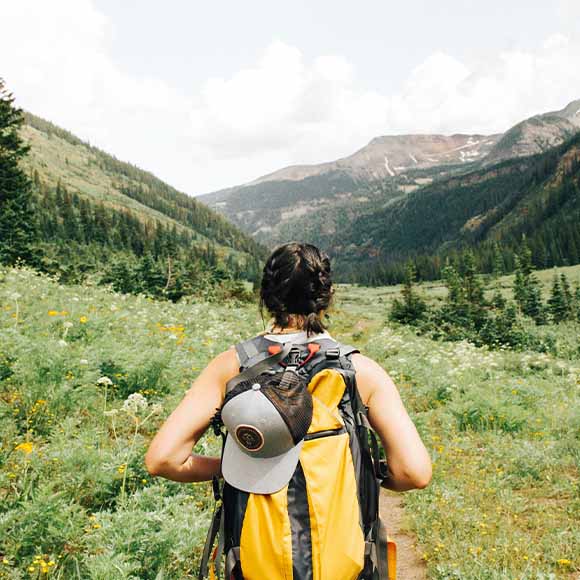
You Might Also Like

6 safe destinations for solo travel

6 Off-Beat Travel Destinations for Your Summer Travels

5 best IPL home grounds and other things you can do in these cities
Don’t miss out on interesting reads from our side!
Sign Up if not a InterMiles member!
Explore interesting reads through our Blog to make your travel, lifestyle and rewards dreams come true.

Please Rotate the Device to Portrait View
Wildcraft App
Easy Checkout & Free Shipping in App

- BULK ENQUIRY
Use code APP10 during checkout for additional 10% OFF (Applicable only for app transaction). Use code SAVE10 for additional 10% OFF on min cart of 1500 (Applicable only for mobile site and desktop transactions + Not applicable on Backpacks)

TOP SEARCHES
- RAIN CHEATER
- HIKING SHOES
- TRAVELCASES
- Jackets & Cheaters
- Sweatshirts & Pullovers
- Joggers & Trackpants
- Pants & Cargos
- Shorts & Cargo Shorts
- Shirts & Tshirts
- Rain Jackets
- Rain Suits & Ponchos
- Thermal Tops
- Thermal Bottoms
- Caps & Hats
- Mufflers & Gaiters
- Travel Cases
- Soft Trolleys
- Hard Trolleys
- Hybrid Trolleys
- Travel Gear
- Duffle Bags
- Duffle Trolleys
- Belts & Wallets
- Travel Accessories
- Technical Gear
- Sleeping Bags & Tents
- Laptop Backpacks
- Messengers & Portfolios
- Trousers & Trackpants
- Capris & Leggings
- WiKi Essentials
- WiKi Rainwear
- Campus Backpacks
- WiKi Boy Backpacks
- WiKi Girl Backpacks
- WiKi Junior Backpacks
- WiKi Slings & Messengers
- Wiki Disney Collection
- WiKi Accessories
- WiKi Lunch Bags
- WiKi Pencil Pouches
- WiKi String Bags
- Wiki Disney Accessories
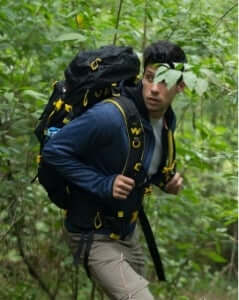
- Luggage Sizes
- Check-in Bags
- Teen's Packs
- Teen's Accessories
- Men's Clothing
- Men's Jackets & Cheaters
- Men's Sweatshirts & Pullovers
- Men's Tracksuits
- Men's Joggers & Trackpants
- Men's Pants & Cargos
- Men's Shorts & Cargo Shorts
- Men's Shirts & Tshirts
- Men's Rain Jackets
- Men's Raincoats
- Men's Rain Pants
- Men's Rain Suits & Ponchos
- Men's Essentials
- Men's Briefs
- Men's Trunks
- Men's Vests
- Men's Socks
- Men's Caps & Hats
- Men's Mufflers & Gaiters
- Men's Gloves
- Men's Thermal Tops
- Men's Thermal Bottoms
- Men's Supermasks
- Women's Clothing
- Women's Jackets & Cheaters
- Women's Sweatshirts & Pullover
- Women's Shirts & Tshirts
- Women's Trousers & Trackpants
- Women's Capris & Leggings
- Women's Rain Jackets
- Women's Raincoats
- Women's Rain Pants
- Women's Rain suits & Ponchos
- Women's Essentials
- Women's Socks
- Women's Caps & Hats
- Women's Mufflers & Gaiters
- Women's Gloves
- Women's Supermasks
- Teen's Clothing
- Teen's Essentials
- Men's Shoes
- Hiking & Trekking
- Even Terrain Running
- Travel Sandals
- Women's Shoes
Kedarnath Trek - A Complete Travel Guide & Tips

Introduction
The best time to visit, the trek itinerary, highlights of the journey, things to keep in mind, things to carry, frequently asked questions (faqs), what is required for kedarnath trekking.
The Kedarnath trek is of moderate difficulty and would require you to carry: A 20-30L capacity rucksack, warm clothes ( jackets , windcheater, and thermal wear), accessories like head gear, gloves, and muffler, personal medical kit and rain cover.
How difficult is the Kedarnath trek?
It is quite easy to cover the Kedarnath Trek, especially since there are multiple transport options available there to make it smoother.
How long is Kedarnath trek?
The Kedarnath Trek covers a distance of 16km and takes almost 6 hours to complete.
Which month is best for Kedarnath?
April-June is the best month to undertake the Kedarnath Trek as the days are quite pleasant, with temperatures ranging between 15 and 25°C with cool breezes.

Kedarnath Trek – A Complete Guide

Table of Contents
Where is Kedarnath?
Kedarnath (3,553 metres, approximately) is a Hindu temple dedicated to Lord Shiva located in the Rudraprayag district of Uttarakhand. It lies just below the base of the mighty Kedarnath peak (6,940 metres), and is the First Kedar to be visited in case you are staying true to the sequence of the Panch Kedar circuit. The other four being Madhmaheshwar , Tungnath , Rudranath, and Kalpeshwar .

I want to drive there myself. What is the motorable route?
Haridwar – Rishikesh – Devprayag – Srinagar – Rudraprayag – Augustmuni – Kund – Guptkashi – Sonprayag – Gaurikund
Distance from Haridwar to Gaurikund: 237 km
The motorable road ends at Gaurikund, but you’ll need to park your vehicle at Sonprayag. No private vehicles or even taxis from outside are allowed to go beyond Sonprayag . The only option is to board one of the shared taxis that specifically run from Sonprayag to Gaurikund. This more than sorts it out in case you are driving here yourself.
The road is more or less well-maintained except for a few patches that fall under the landslide zone. Road from Guptkashi to Sonprayag is patchy at best.

I want to opt for public transport.
- Take a bus or shared taxi (Max) from Haridwar/Rishikesh to Sonprayag
- Take a shared taxi (Max) from Sonprayag to Gaurikund
Buses, both local and of Uttarakhand State Transport, and shared taxis start plying from Haridwar/Rishikesh to Sonprayag as early as 4 am.
That being said, you should know that all the local buses take their own sweet time and multiple halts. All the buses and taxis will drop you at Sonprayag. After this, there is no other choice but to board another shared taxi to Gaurikund.
It should cost one person 1000-1200 bucks, Haridwar to Haridwar.

How long is the trek? How is the trek route like? Do I need a guide? Is there any Medical Aid available?
Gaurikund – Rambara Bridge – Jungle Chatti – Lancholi – Base Camp – Kedarnath (16 km)
It is a well laid out trek all the way through, paved and pretty straight forward.
From Gaurikund to Rambara Bridge (about 7 km) it is gradual yet easy ascent.
It is a steep, gradual ascent after crossing the bridge at Rambara, all the way to the base camp, where it flattens. The last 1 km or so is an easy walk to the temple.
You do not need a guide. Horses, Mules, Palanquins, and Porters are available at Gaurikund. It’s better to book them at Gaurikund itself; you will find many at several points on trek too but they will ask for a price higher than the altitude you will be standing at.
Medical and First Aid facilities are available at several places including Lancholi and Base Camp. There even is a small government hospital just 200 metres from the temple. And police check posts on several points.

Where to stay, eat, and how much will it cost?
There are many Lodges, Ashrams, Guest Houses, and Camps running from Gaurikund to Base Camp that provide cheap accommodation, both private and government run, including GMVN Lodges at Lancholi and Base Camp . The prices can vary from INR 500 per room to INR 2000 , depending on the rush of pilgrims. While the rates shoot up in May-June (peak season), they also go drastically low in the months of September-October (the best time to do this trek).
However, don’t expect anything in terms of luxury; expect basic rooms, warm quilts, simple but good food. There are plenty of tea/coffee shops on the way that also offer food. Expect to pay around INR 100 for a hearty meal for one person .

Is it possible to do Gaurikund-Kedarnath-Gaurikund in one day?
Yes. It depends on your fitness. We had set out at around 2 am and were back by 5 pm the same day, from Gaurikund to Kedarnath and back. Approximately 35 kilometres in 15 hours, which includes 4 hours of wait in the queue outside the temple (it was May). I’ve been told time and again this is a small feat. I am not proud of it. We were behind schedule and had to make up for it. I don’t like to test my speed against distance. Time to me is mostly irrelevant. I like to walk easy. Sit in silence. Maybe lie down. Take a gander at the grandeur. Look into the soul of these mountains. Feel a beat or two. Click a few pictures. Start again. Repeat again. Must we tie self-made accomplishments to places such as these?
This is the gist of it. If you have any further queries, feel free to leave a comment below or contact me through Facebook or Instagram . I’ll get back to you as soon as I can. Stay safe, travel responsibly!

Type your email…
Photographer by day. Travel Writer by night. And a Copywriter in between.
The Pahadi Organic – A True-blue Pahadi Experience
How people shape our journey, you may also like, kalpeshwar trek – a complete guide, tungnath trek – a complete guide, char dham yatra – finding devotion in destruction, pindari glacier trek – ringing in the new..., deoria tal – of epics, myths and himalaya, deoria tal trek – a complete guide, chandrashila – why this should be your first..., binsar – romancing old-world wilderness and the himalaya, madhmaheshwar trek – a complete guide, 20 comments.
Very crisp and adequately informative.
Thanks, Papia. 🙂
Hey Bro, Thanks for this description..!!
Thanks for reading, bro.
Hi Mohit..Beautifully written! To the point! I was planning this trek in September this year..Had a couple of doubts…If I start at say 5 in morning from Sonprayag..Take a shared taxi to Gaurikund. how long does the shared taxi take from Sonprayag to Gaurikund? If I start at 5 from Sonprayag, what time can I expect to start the trek from Gaurikund? I plan to reach the temple by say afternoon and stay overnight..Is there any place I can book on the spot to stay overnight and begin my descent the next day? I’ll be traveling solo! Thanks!
Hi Jatin. Thank you for reading! 🙂
- The distance from Sonprayag to Gaurikund is approximately 4 km. It shouldn’t take you more than 10 minutes to reach Gaurikund. However, this will be a shared taxi and it will not start until it can accommodate all the passengers it has the capacity to. So, I’d say add another few minutes. That being said, September is not the peak season; there shouldn’t be any hassles.
You can start the trek from Gaurikund the moment you reach there.
There are plenty of Lodges, Dharamshalas, and Guest Houses around the temple. Finding a room, on the spot, will be no trouble at all.
All the best! 🙂
Hi Mohit. This is an apt description for anyone who wants to go to Kedarnath. I’m planning to go in early October. Just had a couple of queries. Is it better to take a shared taxi from Rishikesh to Sonprayag? Rather than a bus which might halt at every place and as you said will take own sweet time to reach. Don’t mind paying a little extra for taxis if required. Also, apart from the registration for the yatra which can be done online is there any other registration or fitness certificate required before starting the trek? Thanks!
Hi, Rakesh. Thank you for reading. Shared taxis are relatively faster but almost always cramped. Buses are more breathable. Personally, I prefer buses. No fitness certificate is required.
A very detailed guide to Kedarnath trek, Mohit! I read your blog very carefully to understand your experience and other important things about Kedarnath like how will it cost. Thank you for sharing this article I will visit this place with my friends and family.
Thank you for reading, Manoj. 🙂
Very succinct and a treat to read. I loved the combination of pictures clubbed with crisp text for an amazing experience. Great work brother. Can I have a few of these pictures for one of my videos.
Thank you for appreciating. 🙂
The colour tone is just just just awesome.
Thank you for appreciating.
Hi mohit We r planning to go in d month of may .. I ve one clarification.. 1.Can we start trek around 12 pm? Bec we ll reach gowrikunda @11am. 2. Can we stay middle of d trek. Is any accommodation on d middle?
- You can start anytime.
- Please refer to ‘Where to Stay, Eat, and how much will it cost’ section on the post. All the best.
Hello Mohit , For an ordinary people is easy trek or very diffcult?
Hi. The trek itself is not difficult. It might seem a little long and tiring. But should be manageable as long as you take it easy. All the best.
Dear Mohit – All guides are so well written – Every thing at one place – I have saved all these for my preparations when I go
Thank you! Glad I could be of help. All the best.
Leave a Reply Cancel reply

A Guide for Kedarnath Trek

Kedarnath Route Map
Planning to go for the Kedarnath Yatra ? If yes then make sure you have a complete guide for the 18 km long Kedarnath Trek and thus enable yourself to have a journey that is satisfying and fulfilling both in terms of divinity and comfort. If you are looking for a travel guide for the Kedarnath Trek then look no more as we have prepared for you a complete catalogue of the Kedarnath Trek that will make your journey to Kedarnath easy and joyous.
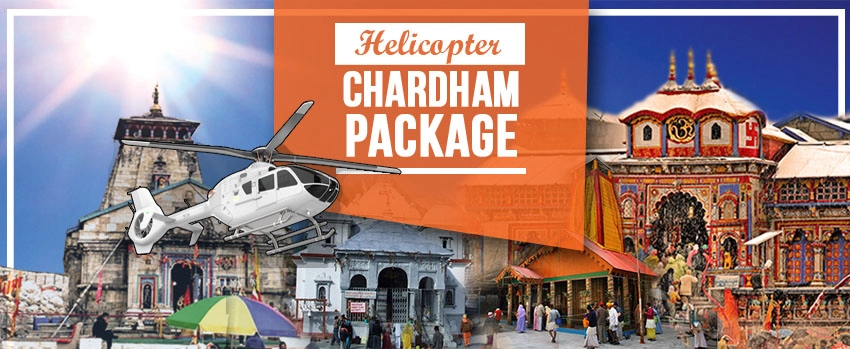
Visit Kedarnath by Road (Till Sonprayag)
To reach at Kedarnath by road you need to book a taxi or bus service which can be privately run or by the GMOU ltd. To reach at Kedarnath from Delhi you need to travel till Dehradun for which you can choose any medium be it road, rail or airways. From Dehradun travel till Haridwar and from Haridwar the following route will be your Guide to the Kedarnath Trek.
New Delhi to Haridwar 206km >> Haridwar to Rishikesh 24km >> Rishikesh to Devprayag 74km >> Devprayag to Srinagar 34km >> Srinagar to Rudraprayag 33km >> Rudraprayag to Gaurikund (via Tilwara-Agastmuni-Chandrapuri >> Kund >> Guptkashi >> Phata >> Sitapur >> Sonprayag) 74km >> Gaurikund to Kedarnath (by trek) 18km.
You can also visit Kedarnath from Delhi by boarding a direct bus from Delhi Bus Stand Kashmiri Gate to Gaurikund which is run by the Uttarakhand Transport Corporation. From Gaurikund further continue your trek to Kedarnath.
Visit Kedarnath by Air
To reach Kedarnath by air you can book a seat for yourself in a helicopter. If travelling by a helicopter till Kedarnath you can from Dehradun as well as Haridwar and Rishikesh .
From Dehradun- travel till the Shastradhara Helipad in Dehradun. The Helicopter will drop yoiu at your destination within a time period of 40 minutes.
From Haridwar/Rishikesh- If you are planning to travel to Kedarnath from Rishikesh/Haridwar via Helicopter then travel from Haridwar/Rishikesh till Phata via taxi which is at an approx distance of 200km and 195km respectively.
Kedarnath Trek Guide – How to Reach Kedarnath by Trek
After you reach till Sonprayag you will have to travel in a shared cab which charges Rs 20 per person this cab will take you till Gaurikund, Further from Gaurikund the trek to Kedarnath begins the directions of which are listed below as your Guide to Kedarnath Trek.
Kedarnath Trek Distance
The trek to Kedarnath is a 18 km trek which starts from Gaurikund till Kedarnath. The trek has changed since the 2013 flood disaster in Uttrakhand and since then the 14 km trek to Kedarnath has increased to a 16km trek.
Route Map of the Kedarnath Trek
The Kedarnath trek is a 18 km trek which starts from Gaurikund. Earlier the route followed was from Rambara, it was a well developed, well fenced and a facilitated trek route. However the Gov has now changed the trek Route of Kedarnath after the 2013 disaster as the old trek route to Kedarnath was completely erased. The New Trek Route to Kedarnath is given below which will be your Travel Guide to Kedarnath Trek .
- Reach at Gaurikund (6km approx) through shared taxi from Sonprayag
- Gaurikund to Jungle Chatti(6km) through the Rambara Bridge.
- Jungle Chatti to Bheembali (4km)
- Bheembali to Linchauli (3km)
- Linchauli to Kedarnath Base Camp (4km)
- Kedarnath Base Camp to Kedarnath Temple (1km)
Features of the Kedarnath Trek
The Kedarnath Trek is a 18km medium to steep trek which requires a good level of physical fitness. Before going for the trek every pilgrim has to get themselves checked that whether they are capable of trekking or not. Timings of Kedarnath Trek from Gaurikund commences from 04:00AM in the morning till 01:30PM. This timing is fixed because Kedarnath is located in the Kedarnath Wildlife Sanctuary and therefore the pilgrims are not allowed to trek anytime. No pilgrim is allowed to leave after this specific time. These are high altitudes trek so it is advisory for the ones with respiratory problems to first consult with a doctor before trekking.
Facilities at the Kedarnath Trek
The Kedarnath Trek facilities include the services of Palki/Dandi, Kandi & Mule/Ponies. Anyone can book these services from the booking counter at Gaurikund/Sonprayag. Different distances have different rates such as the Gaurikund to Kedarnath Dandi will cost Rs 4450, Kandi will cost Rs 3350 and the Poni will cost Rs 4100. In the midst of the trek there are proper facilities of tented accommodation, drinking water and small shops/ restaurants are also there in the trek route. There is also Helicopter services from the Kedarnath helipad to Phata and other helipads.
Things to Remember Before Going on the Kedarnath Trek
- Do get a check up before going on the trek to Kedarnath.
- People with Respiratory disorders and High Blood Pressure should not trek to Kedarnath.
- If you want to travel through Kandi, Ponies and Palki make sure that the prior booking is done at Gaurikund/Sonprayag booking counter.
- Trek between 04:00AM to 01:30PM as this is the only time when pilgrims are allowed to trek to Kedarnath.
- In case you won’t be able to cover the trek till late evening you can take Palki or Ponies to reach to your destination. You can also stay in the camps which are set up in between the trek at Jungle Chatti, Bheem Bali and Lincholi for a night and start journey next morning.
So here is a Complete Guide to Kedarnath Trek for you which will help you to analyze and go for your Kedarnath Yatra, making it more divine and comfortable.
Get Tour Details
Add comments and suggestions or ask questions about "a guide for kedarnath trek".
We would be glad if you can comment below and provide your valuable suggestions and feedback on A Guide for Kedarnath Trek. If this A Guide for Kedarnath Trek page have any wrong information/list or out of context content, then you can report us as well.
If you have any questions, you can also ask as in the following comments section. Our team will try to provide you answers/solutions.
Why the prices are not as per the MRP? And why the prices of room is too high no fixed price, no proper facilities, they are cheating the pilgrims, shared taxi in which 12 people has to sit otherwise they will wait there. The trek is full of donkey sit all the way
What is the height at base camp and pick at kedarnath
Can we visit Kedarnath, Badrinath, gangotri and yamunotri
I am Heart patient should i go kedarnath after check up
Yes you can go if you are fit, The trek is too steep if you are planning then take proper medicine along with you
Is the Kedarnath trek open a day before temple opening? I want to go there on 8th May and stay overnight to offer prayers next day. The temple opens on 9th May. Can I trek on 8th May?
Yes, trek will be open by then.
Thanks for the question even i am trekking on 8th will see you

Destinations
Char dham yatra tour packages.
- Char Dham Packages
- Badrinath Packages
- Kedarnath Packages
- Gangotri Packages
- Yamunotri Packages
- Teen Dham Tours
- Do Dham Packages
- Chardham Helicopter Packages
- Chardham Leisure Hotels
- Fixed Departure Tours
- GMVN Tour Packages
- Hemkund Tours
- Winter Chardham Packages
- Chardham Packages 2024
Char Dham Hotels
- Chardham Hotels
- Hotels in Badrinath
- Hotels in Kedarnath
- Hotels in Gangotri
- Hotels in Yamunotri
- Hotels in Barkot
- Hotels in Joshimath
- Hotels in Auli
- Hotels in Srinagar
- Hotels in Devprayag
- Hotels in Guptkashi
- Hotels in Harsil
- Hotels in Ukhimath
- Hotels in Uttarkashi
- Hanumanchatti
- Rudraprayag
- Sayanachatti
- Srinagar Garhwal
- Karanprayag
- Jankichatti
Packages
tours, book now.

Kedarnath Trek Guide
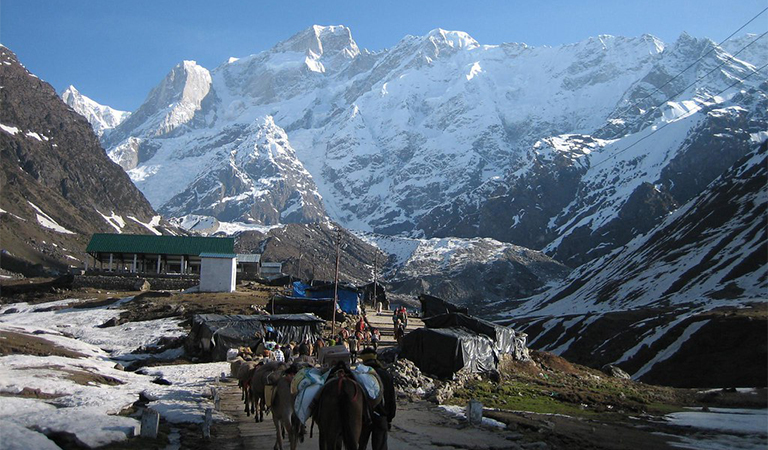
Kedarnath, holding at an altitude of 3,553 meters from the sea level, is located in the Rudraprayag district of Uttarakhand. Of all the Chardham Yatra , Kedarnath Yatra holds greater importance because of its religious significance and also because of the level of difficulty it involves to reach the shrine of Lord Shiva. The journey to this holy shrine includes a trek from Gaurikund . Though Kedarnath trek is known to be very difficult, however, with a well-planned Kedarnath Travel Guide , you can complete it at ease. Shrine Yatra offers you the opportunity to avail a specially curated trek guide to Kedarnath only for you.
Route to Reach Kedarnath by Trek
The devotees need to reach Gaurikund first because the 16 kilometres Trek to Kedarnath begins from there. You can reach Sonprayag from Haridwar, Rishikesh by Taxi or Bus via Guptkashi. You may also avail air route to Guptakashi/Phata/Sitapur via Dehradun or can also do Kedarnath helicopter yatra . You may also reach Kedarnath by Road from Delhi by buses or Taxi. Follow the Route- Delhi >> Haridwar >> Rishikesh >> Devprayag >> Rudraprayag >> Guptakashi >> Sonprayag >> Gaurikund >> Kedarnath . According to the New Trek Route to Kedarnath after the flood, follow the trek route given below:
- Reach Gaurikund from Sonprayag approx 6 Kms by sharing taxi.
- Trek again to Jungle Chatti approx 4 Kms via Rambara Bridge.
- Bheembali Linchauli, approx 4 Kms.
- Reach Kedarnath Base Camp from Linchauli, Approx 4 Kms.
- Visit Kedarnath Temple from Kedarnath Base Camp, 1 km.
Kedarnath Trekking Time
The trek to Kedarnath begins from 4 AM, early in the morning and continues till 1:30 PM in the afternoon. No treks can be commenced after that because Kedarnath is located in the Kedarnath Wildlife Sanctuary so a specific time shall be maintained. Those pilgrims who want to return same day, leave before 5 PM from Kedarnath.
Facilities to Avail During Trekking to Kedarnath
While doing the Kedarnath trek, you can go on foot or you can also avail Palki Dandi, Kandi, Mule or Ponies. Helicopter services to Phata Helipad and others are also available from Kedarnath Helipad. En-route, there are many lodges, guest houses, ashramas and camps where you can find cheap accommodations and good food. There are plenty of refreshment options available throughout the trek route. Tented accommodations, drinking water facilities and some shops and restaurants are available in the route. You can also find several medical and first aid facilities near Lancholi and Base Camp. There are several police check posts and also a government hospital located only 200 metres from the Kedarnath Temple for some medical emergencies.
Things to Remember Before Going for Kedarnath Trek
- Make sure you have medical fitness and you are physically fit to climb the steep slopes. Especially, individuals with respiratory problems and high blood pressure should avoid the trek.
- If you want to avail Palki or Pony services for the trek, then bookings are required either from Gaurikund or Sonprayag.
- Remember not to carry heavy baggage during the trek because it may slow down your trekking pace.
Follow the complete trek guide to Kedarnath to avail a smooth and flexible Kedarnath trek with Shrine Yatra.
Yes discuss pls call me..
Letest information about the situation
04 Nights / 05 Days Yamunotri and Gangotri Yatra from Haridwar

The Yamunotri Gangotri tour package 2019 offers a 4 nights/5 days tour which will start from Haridwar and lead... read more
06 Nights / 07 Days Yamunotri Gangotri Yatra from Delhi

The complete Yamunotri Gangotri Yatra from Delhi will be accustomed with the food and stay arrangements follow... read more
Yamunotri Yatra From Haridwar

Yamunotri Temple is situated in the western region of Garhwal Himalayas at an altitude of 3,291 metres in Utta... read more
Yamunotri Yatra From Delhi
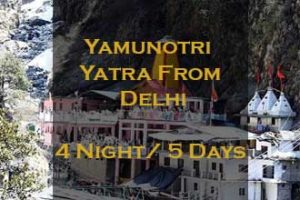
Get Free Quotes from Our Tour Expert!
Arrival Date
Adults Select 1 2 3 4 5 6 7 8 9 10 11 12 12+
Children Select 1 2 3 4 5 6 7 8 9 10 10+
Message Message

Kedarnath Trek
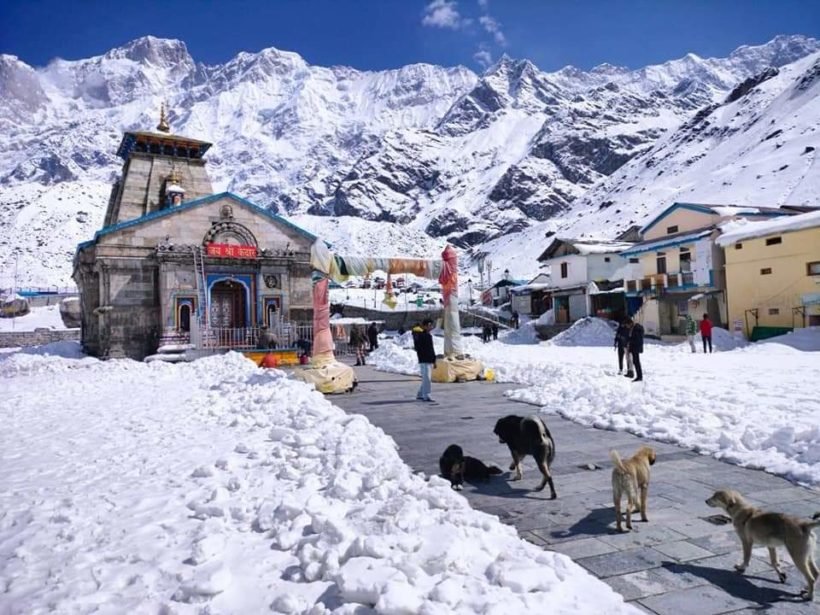
Description
Reviews (3), things to take, available dates, include / exclude, kedarnath temple trek the india’s most popular destination in uttarakhand himalayas, complete information 2024 yatra trek .
Kedarnath Trek is a remote but highly celebrated pilgrimage site of the famous ‘Char Dham’ in the Rudraprayag district of Uttarakhand. At an astounding location of 3583m Kedarnath lies near Chorabari Glacier, the birthplace of Mandakini River and is surrounded by various snow-capped peaks. The famous Kedarnath Mountain also lies in the vicinity to the site of Kedarnath. The Hindu pilgrimage site is visited every year by thousands of devotees from all around India.
Many Peoples thinks the Kedarnath Trek and Kedarkantha Trek are the same but these both are different Treks and also located in different location. Kedarnath Trek located in Rudraprayag district and Kedarkantha Trek located in Uttarakashi district in Uttarkhand.
In local dialect ‘Kedarnath’ means ‘lord of fields’; according to a local legend it is believed that Lord shiva hid in an assumption of a bull trying to avoid the Pandavas. Bhima, one of the brothers from Pandavas, recognized lord Shiva and tried to capture the bull through its tail and hind legs. Just before Bhima could fully grasp the bull, it disappeared into the ground only to later appear in many forms across the region. The hump of this bull appeared in Kedarnath where it is believed that Pandavas built the temple and later worshipped it.
Kedarnath should not be mistaken as any easy trek, hikers not accustomed to long journeys and altitudes might face some problems, hence it is generally advisable that trekkers practice a reasonable amount of physical fitness.
Kedarnath Temple is a revered Hindu shrine located in the Rudraprayag district of Uttarakhand, India. Here are some of the highlights of the temple:
- Ancient Temple: Kedarnath Temple is one of the oldest temples in India, believed to have been built by the Pandavas during the Mahabharata era.
- Dedicated to Lord Shiva: The temple is dedicated to Lord Shiva, one of the most important deities in Hinduism.
- High Altitude: The temple is located at an altitude of 3,583 meters (11,755 feet) above sea level, making it one of the highest temples in India.
- Magnificent Architecture: The temple’s architecture is a beautiful blend of ancient and modern styles, featuring intricate carvings and a unique design.
- Unique Rituals: The temple has several unique rituals, including the Abhishekam ceremony, in which the idol of Lord Shiva is bathed with water, milk, and other offerings.
- Char Dham Yatra: Kedarnath Temple is one of the four shrines that make up the Char Dham Yatra, a pilgrimage tour that is considered one of the most sacred in Hinduism.
- Importance in Hindu Mythology: According to Hindu mythology, Kedarnath is one of the twelve Jyotirlingas, which are considered to be the most sacred abodes of Lord Shiva. It is also believed to be the place where Lord Shiva absolved Pandavas of the sin of killing their own brothers during the Mahabharata war.
Overall, Kedarnath Temple is a significant pilgrimage destination for devotees of Lord Shiva and Hinduism, and a beautiful site for tourists to visit and admire the ancient architecture and natural beauty of the surrounding region.
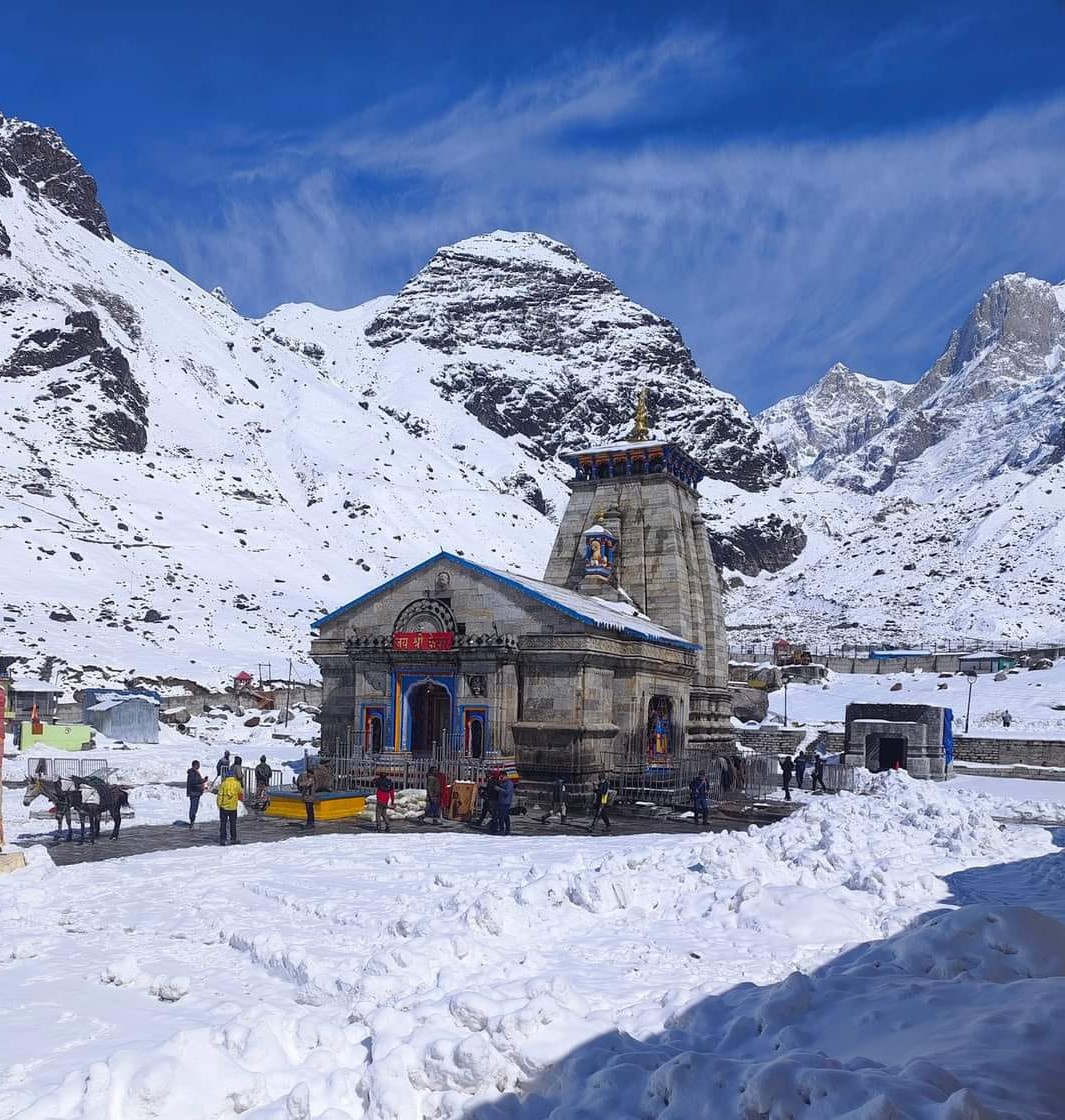
A special place of Lord Shiva in Himalayas of Uttarakhand
Kedarnath is a place where a special form of Lord Shiva is seen. Kedarnath Temple is one of the holy pilgrimage sites in the state of Uttarakhand, northern India, located on the banks of the Mandakini river and is a beautiful place in the lap of Himalayas, which is known as Kedarnath. The name of the historical heritage of this area is “Kedar Khand”. Kedarnath temple is a special part of Char Dham Yatra and Panch Kedar in Uttarakhand state and it is known among the 12 Jyotirlingas of Lord Shiva in India.
Kedarnath This is the most remote place among all the Char Dham sites where Shiva is the Taposthali, and is surrounded by snow-capped mountains that attract thieves and people to itself. Known for its ancient Shiva temple, a visit to Kedarnath Dham is a beautiful and mind-blowing exhilarating experience. Like other places, Kedarnath temple closes on the first day of Hindu month Kartik October-November and every year Baba Kedarnath ji’s door opens again for his devotees in Vaishakh April-May
Where do worship Lord Kedarnath in Uttarakhand ?
When Lord Shiva is shifted from Kedarnath to Ukhimath Dham, this Shiva temple remains submerged in snow for almost half a year 6 months. Where sages dedicate themselves to the feet of Baba Kedar even in the winter season, they worship him and do meditation yoga. According to a legend, it is said that Lord Shiva is seen in various forms such as arms in Tungnath temple, face in Rudranath temple, stomach in Madmaheshwar temple and head in Kalpeshwar temple with his hair. give. Kedarnath and the above four temples are considered as Panch Kedar. Where Lord Shiva is worshiped in all the Dhams.
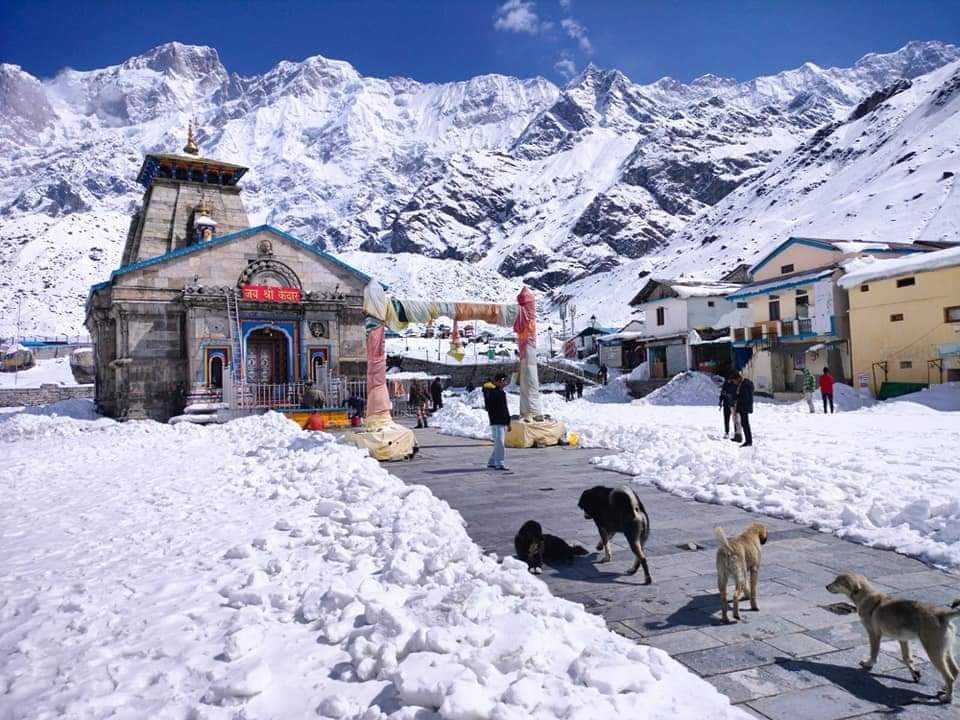
Key Points of Kedarnath Trek
Some of the trek highlights of kedarnath trek.
Even before the trek starts trekkers are introduced to many lavishing vistas of Rishikesh, Devprayag and Rudrapryag. The magical confluence of Alaknanda & Bhagirathi at Devprayag and Alaknanda with Mandakini at Rudraprayag is an inner outer experience. Beautiful temples at every few kilometers clearly stamps that yes trekkers are indeed at the Land of Gods ‘Uttarakhand”.
The trek officially commences from Gaurikund covering many campsites along the way. Jungle Chatti, Bheembali, and Linchauli are some of the camps we pass during the trek. The entirety of journey trekkers would find devotees chanting and celebrating the trail. Echo of “Har Har Mahadev” fills you with an exceptional spiritual embodiment.
The final reach of Kedarnath is enough to overwhelm devotees with the chants of “Mahadev”. Temple covered in long ribbons of marigold garlands, long happy queues of devotees and the calmness of the Kedarnath. Everything about this place will capture you in its essence.
The trek to Kedarnath Temple offers several beautiful and scenic locations that you can visit along the way. Here are some of the most popular places to visit during the Kedarnath trek:
- Gaurikund: Gaurikund is the base camp for the Kedarnath trek and is located at an altitude of 1,982 meters (6,503 feet) above sea level. It is believed to be the place where Goddess Parvati meditated to win Lord Shiva’s heart.
- Rambara: Rambara is a picturesque location located around 7 kilometers from Gaurikund, and is an ideal place to take a break during the trek. It is situated at an altitude of 2,835 meters (9,301 feet) above sea level and is surrounded by beautiful valleys and waterfalls.
- Kedarnath Temple: Kedarnath Temple is the main attraction of the trek and is located at an altitude of 3,583 meters (11,755 feet) above sea level. It is one of the twelve Jyotirlingas in Hindu mythology and is considered to be one of the most sacred sites in India.
- Vasuki Tal: Vasuki Tal is a serene lake located around 6 kilometers from Kedarnath, and is surrounded by beautiful mountain peaks. It is situated at an altitude of 4,150 meters (13,615 feet) above sea level and is a popular spot for camping and trekking.
- Gandhi Sarovar: Gandhi Sarovar is a glacial lake located around 2 kilometers from Kedarnath, and is named after Mahatma Gandhi. It is situated at an altitude of 3,900 meters (12,795 feet) above sea level and offers stunning views of the surrounding mountain ranges.
Things to Look out for-
- Souvenirs from Rishikesh are great for memories.
- There are countless photogenic vistas, so we recommend that you prepare yourself for any aesthetic shoots. The best pictures are those taken under a blue sky with snow-covered peaks in the background.
- Explore the tranquility of this holy site and submerge yourself in “Baba Kedar’s” blessings.
The altitude covered in Kedarnath Trek
- Rishikesh-340 m
- Sonprayag-1829 m
- Gaurikund-1982 m
- Kedarnath-3583 m
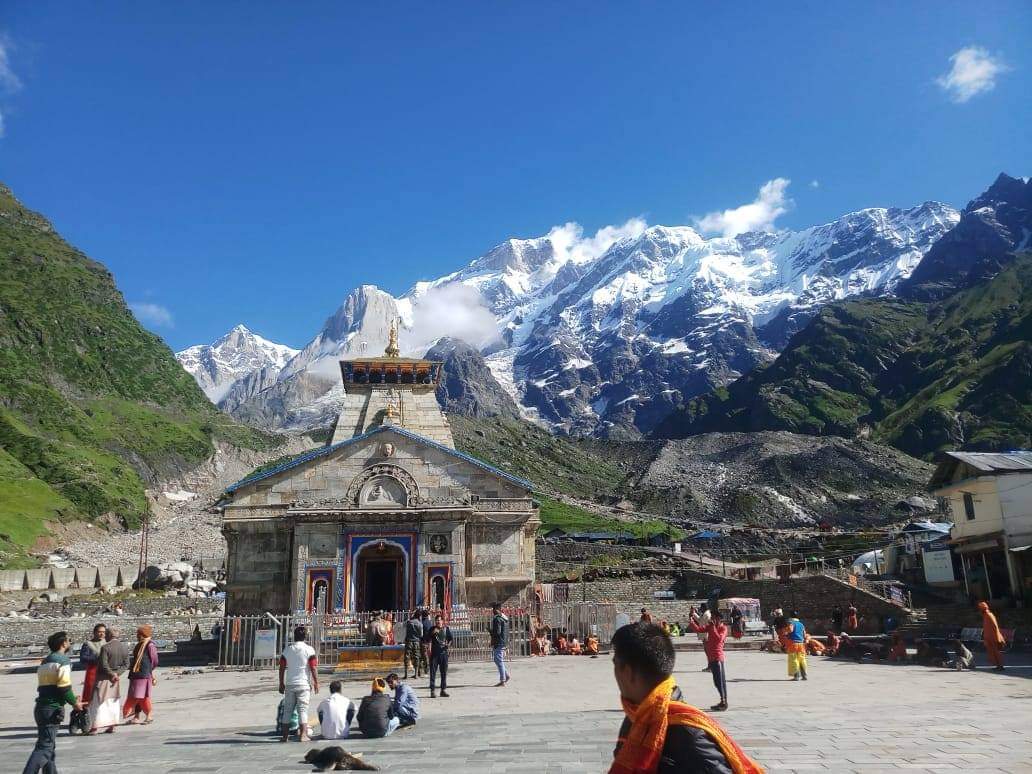
Best Time to Visit Kedarnath Trek & Opening or closing time every year
Kedarnath Temple, located in the Indian state of Uttarakhand, usually opens for visitors in late April or early May each year, and closes in the first week of November before winter sets in. The exact dates of opening and closing of the temple are determined by the Char Dham Devasthanam Board, which oversees the management of the temple. However, it’s important to note that the dates may vary slightly from year to year, depending on various factors such as weather conditions and other local considerations. If you are planning to visit the temple, it’s a good idea to check with the official website of the Char Dham Devasthanam Board or local authorities for the exact dates of opening and closing before making travel arrangements.
Kedarnath temple is best visited during the summer months of April to June. and September to Last October. Families and friends can enjoy the mild temperatures of these months. The unfavorable temperatures and precipitation make this trek a per and post monsoon season trek. Temperatures typically range from 15 to 20 degrees Celsius during the day, with substantially colder nights.
The most popular time to visit Kedarnath Temple is during the Char Dham Yatra season, which typically runs from April/May to October/November, depending on the weather conditions. During this time, the roads leading to Kedarnath are open, and the temple is easily accessible.
To reach Kedarnath from Haridwar, you can take a shared taxi or bus to Gaurikund, which is the base camp for the trek to Kedarnath. The trek is approximately 14 kilometers long and takes around 6-8 hours to complete, depending on your pace and physical fitness level. Along the way, you will pass through several scenic locations, including waterfalls, lush forests, and picturesque valleys.
During the Char Dham Yatra season, there are several facilities available for pilgrims, including accommodation options, medical facilities, and food stalls. It is advisable to carry warm clothing, sturdy trekking shoes, and basic first aid supplies when trekking to Kedarnath, as the weather can be unpredictable and the terrain can be challenging.
Overall, visiting Kedarnath during the Char Dham Yatra season can be a memorable and spiritually uplifting experience, as you will be part of a large community of devotees who are all journeying towards a common goal.
1) Is it safe?
2) Difficulty level
3) Weather conditions
4) Things to carry
5) Connectivity and transaction
6) How to reach
7) Short Itinerary
Is Kedarnath Trek is safe?
Set amidst the high altitude ranges, concerns regarding Kedarnath Trek safety are undeniably very valid questions. Yes the trek to Kedarnath is indeed very safe and reliable, new trails and much clearer safety protocols are sure to easy anyone’s concern.
Difficulty level in Kedarnath Trek
Because the top is relatively high in elevation for any beginner level trekkers we strongly recommend a reasonable level of physical fitness. We advise trekkers to physically and mentally prepare themselves prior to this trek.
Any medical assistance that is required will be provided at any point of the journey; however, trekkers must consult their professional care before beginning any trek. We also strongly advise trekkers to learn about altitude sickness and to notify our teams as soon as any symptoms appear.
Weather conditions
Weather conditions depend on the time of the year trekkers are travelling. In the months leading up to and following the monsoon season, the daytime temperatures are moderate, but the nighttime temperatures are significantly lower. Monsoons receive moderate to heavy rainfall.
Short itinerary of Kedarnath Trek
Day 1 Drive from Haridwar via Rishikesh to Sonprayag 202 km by taxi (1982 m overnight stay hotel
Day 2 Aftre breakfast Sonprayag to Gaurikund same day trek to Kedarnath temple 15 km (6/7 hours) (3553 m) overnight stay Hotel
Day 3 After Arti Darshan trek from Kedarnath to Gaurikund same day drive to Sonprayag over night stay Hotel
Day 4 Drive from Sonprayag to Haridwar via Rishikesh 202 km
Note: – Our service will remain from Rishikesh to Rishikesh – for more details please check includes or excludes
Things to carry in Kedarnath Trek
1) Because nights at elevations tend to be considerably colder, we suggest having well-graded, warm and comfortable clothing along with good quality shoes.
2) Despite the fact that we handle medical crises, we urge individuals to keep their emergency kits at hand in any case of personal underlying illnesses.
3) Since the journey provides you with a picturesque view of many peaks, don’t forget to bring your camera along with extra batteries.
4) Our staff will consult with fellow trekkers about their luggage and, if lacking, will assist trekkers in obtaining any necessary equipment. Only the relevant luggage should be brought, as a result.
Other trekking Essentials-
Connectivity and Transactions
1) Because connectivity along the route is unpredictable, we urge people to do all of their work ahead of time.
2) Last ATM transactions available will be at Gaurikund but we recommend travelers to collect cash beforehand or while in Rishikesh as ATMs available at other places might not dispense cash at times.
How to Reach Kedarnath Trek
If you are travelling from any metropolitan city in India or from outside India, getting to the capital city of Delhi may be the first and most important step. All major modes of transportation, such as air, road, and rail, can take you to Delhi.
Rishikesh is connected to most major cities in India via all chief modes of transportation. Trekkers could perhaps conduct extensive research for their direct mode of transportation to ensure a much smoother arrival.
By air – Jolly Grant Airport is the nearest airport to Rishikesh. It is well connected to Delhi and many chief cities with daily flights. How to reach Rishikesh from Delhi
By road -Delhi has direct road routes to Rishikesh. Trekkers will have to book either a bus or private cabs. Prior booking for cabs and buses are easily available at various sites.
Delhi> Rishikesh >Sonprayag>Gaurikund
By railway – Nearest Railway station to Rishikesh will be Rishikesh Railway station . Since Rishikesh is connected to all major railway routes, trekkers can opt for a direct route or via Delhi. They can also opt for direct trains to Dehradun or Haridwar and the take cab or bus to Rishikesh.
.Some important points to note-
- Please note that we don’t provide timings schedules for transportation before Rishikesh. Subjected to various conditions the scheduled timings and availability of particular rides may differ. We recommend trekkers to reach out to our teams for any queries. You can drop an email or call us for an initial guided session.
- Our teams will be collecting trekkers at fixed points of airports, railway stations and bus stands.
- It is recommended that unless any delay arrives, trekkers are advised to reach the destinations at least 2 hours prior.
Things Himalayan Hikers Recommend
As previously stated, a camera, as well as spare batteries and memory cards, are recommended. We can assure and guarantee that you will be stopping frequently along the trail to observe the grandeur of the trekking experience.
We strongly recommend trekkers to prepare beforehand for the journey ahead. Regular practicing physical fitness and mental endurance will surely assist trekkers in great time.
After the trek, we strongly encourage trekkers to tag us on social media when they post any memories from the trip; this will not only prove invaluable to us with our work, but will also serve as a motivational example for all of our experts.
Why you should choose us
We’re here to give you the greatest experience possible through the eyes of highly skilled and qualified specialists who have a passion for adventure sports. We are community members attempting to promote our favorite adventure sports while also supporting local businesses. We, at Himalayan hikers, dedicate ourselves to providing you with an unforgettable experience.
What we do during an emergency breakout in the Kedarnath Trek?
First of all, the safety of trekkers is much more for us, if you see in the trek, then there are all the risks, which I do not think about.
Himalayan Hikers worry more about you that no one should ever have any problem in the trek.
What should we and you keep more safety in the trek
- Whenever you are going for kedarnath trek, it is very important that you go completely fit and ready.
- Kedarnath trek is Moderate, if you make your feet and your mind calm and strong, you will find the trek very easy.
- While trekking, keep in mind that you are walking on the right route or not always with your guide.
- Most people look somewhere and where they are walking, this can cause twitching in your legs, which can ruin your entire trek.
- It is important to ask your doctor if you have any medical problems
- I should always keep my medical kit with me, it is very important.
- Himalayan Hikers always keep a medical kit with you, such as oxygen cylinders, medicine to be given in emergency on the kedarnath trek
- If any trekkers have any more problems, then they are brought back to the base camp by laying them in the stretcher.
- Our Hotels in Kedarnath trek is around the 6000 feet to 11,000 feet where you can not have any problem of oxygen, this is tree line area
- In case of any medical problem, the help of your guide or a well-informed trekkers should be taken
- If there is major health problems in Kedarnath trek , then Nearest Hospital is in Rudarparyag / Gaurikund / Karanparyag which is about 69 Kms away from Kedarnath trek last option in dehradun and Rishikesh the distance is 257 kms
- Along with the trek we keep getting acclimatization
Self-Certificate of Emergency Breakout
Trekking in the Himalayas is not a cup of tea but it is a rewarding experience. However, it’s important to keep things in mind when it comes to Safety. One must know about the weather conditions, the altitude gain, fitness and other factors that can wreck your experience. In such adverse conditions, you are solely responsible for your well being and act maturely.
Also Read About – Safety Tips For Safe Trekking.
Preparations before the Trek
You’ve to understand that treks are away from cities and medical help is not always easily available. So, if you are heading for an adventurous trekking trip, stick to certain trekking guidelines and tips. Following these simple tips will help make the trek more fun and experiential for you as well as your fellow trekkers.
These tips and guidelines cater to useful and requisite information about your fitness training, packing and health precautions to be taken before and during the trek.
- Firstly, when you start, target 5 km in 40 minutes
- Then gradually increase your pace by running at least 4 times a week. Then try to bring it down to 5 km in less than 37 minutes
- If you are a person who prefers cycling over running then your target must be 22 km means you should be able to cover 22 km in 60 minutes.
- Walking is a great exercise that gives great shape to your legs and your body. It helps in burning calories and cut down excess weight and strengthens the heart.
- Jogging is effective in increasing the human lifespan and makes your lungs stronger. It is an aerobic activity that requires a lot of oxygen. This is a great exercise for fighting obesity and staying healthy.
- Squats are the best form of functional exercises to improve stability. They also strengthen your legs, thighs, hips, and hamstring.
- Another great cardiovascular exercise is pushing your body upstairs after stairs. This is regarded as the best exercise for increasing strength and power
What to pack for Kedarnath Trek
Warm clothes, sleeves, wind shelter, comfortable clothing, and extra warm clothes so that you can enjoy trekking. A raincoat is the necessary
Footwear: A well-fitted trekking footwear shoes are highly recommended. If you wear an uncomfortable pair of shoes, your feet will be hurt.
Day 1: Drive from Rishikesh to Sonprayag
Our teams will pick up trekkers at Rishikesh and then they will be taken to Sonprayag. The entire journey of the holy river Ganga will accompany us. Trekkers can relish in the beauty of the journey. Buses will be stopping at Devprayag and if lucky trekkers might get a chance to witness the great confluence of rivers Alaknanda and Bhagirathi. After crossing another confluence of Alaknanda and Mandakini at Rudraprayag, trekkers will finally reach Sonprayag. Check in to respective hotels and rest for the night
Day 2 : Gaurikund to Kedarnath
Next day after breakfast teams will be dispatching for Kedarnath temple trail via Gaurikund. Jungle Chatti, Bheembali, and Linchauli are some of the camps we pass during the trek.As the teams reach Kedarnath temple after covering a long distance of new trail, trekkers will be stopping to visit the temple and receive Lord Kedarnath’s blessings. Since teams will be staying overnight at camps, hikers will be getting a great opportunity to explore the surroundings. The tranquill grim of this place will leave trekkers yearning for more.
Day 3 : Kedarnath to Gaurikund same day Drive sonparyag
After attending the morning ‘Aarti’ teams will prepare for their return. Trek from Kedarnath to Gaurikund and same day drive to Sonprayag/ rudraprayag on the same day.
Day 4: Sonprayag to Rishikesh
Trekkers will be dispatching for Rishikesh from Sonprayag early in the morning. Come across the beautiful vistas of the journey. Interacting with our teams and other locals in the entirety of our journey can provide an opportunity to learn more about the local culture.
Note- reaching Rishikesh on the date decided is trekkers’ sole responsibility. We can only offer assistance after their arrival in Rishikesh.
Mandatory Documents
Please carry the documents given below.
Original and photocopy of government photo identity card- (Aadhar Card, Driving License, Voters ID, etc, Passport and Visa important to foreigners Medical Certificate (First part should be filled by the Doctor and Second part by the Trekker) Declaration Certificates
Note: – Many trekkers commit the same mistake of carrying unnecessary items on a trek which only makes the backpack heavy. It is important to know the right items to carry. It differs from season to season if you are trekking in summers then carry less layers of warm clothing and if you are trekking in winters carry enough layers to protect yourself against chilly cold.
Necessary Items for trekkers

Backpack (50 to 60 liters) A strongly built backpack with good support is compulsory for a trek. (Rain cover is important)
Sturdy Trekking Shoes The shoes should be strong enough with good support. The people ask if sports shoes would be comfortable but it is good to bring the right trekking shoes.
The Clothes You Should Bring On a Trek Avoid keeping extra clothes because it only makes you backpack heavy.
Trek Pants – The jeans are never suitable for a trek so you need at least 2-3 trek pants for treks carry more for longer treks.
Jacket – Jackets are very important to carry on a trek it protects you against the chilly weather. So carry 2 jackets on a week long trek.
Layers of warm Clothing Carry warm woolen layers or fleece. Carry more layers during winter season (at least 2 to 3) and less during summer.
Thermals – The Temperature decreases at night so you might be need thermals for Night.
T- Shirts – Bring those t shirts which dry fast.
Poncho –They are needed if you are trekking on a Rainy day to keep you dry.
Hiking Pole
Water Bottle 2
Cap or Balaclava
Woolen and Waterproof Gloves
Socks (Woolen and Regular)
Torch head light
Personal Toiletry Items – (toothpaste, toothbrush, toilet paper, sanitizer etc.)
Carry Personal Medical Kit
Personal Medical Kit (Carry minimum 5 tablets and maximum 10)

Diamox – (Prevents altitude sickness)
Digene – (It cures discomfort in stomach, acidity)
Crocin Advance – (Cures fever and headache)
Aspirin/Combiflam – (Pain reliever)
Disprin – (Cures headache)
Avomine – (Prevents motion sickness)
Avil – (It treat allergies)
Norflox TZ & Lomofen – (Prevents Diarrhoea)
Ranitidine – (Reduces the amount of acid in stomach)
Volini/Moov spray – (For sprains)
Betadine/Savlon – (Antiseptic cream)
Stretchable/Elastic bandage
Note:- Use medicines only when prescribed by the doctor. In case you face any problem during your trek, discuss and take advice from the Professional guide.
09 May to 12 May 2024 (open)
12 May to 15 May 2024 (Open)
17 May to 20 May 2024 (Open)
18 May to 21 May 2024 (Open)
19 May to 22 May 2024 (Open)
24 May to 27 May 2024 (Open)
25 May to 28 May 2024 (Open)
26 May to 29 May 2024 (Open)
01 June to 04 June 2024 (Open)
02 June to 05 June 2024 (Open)
03 June to 06 June 2024 (Open)
07 June to 10 June 2024 (Open)
08 June to 11 June 2024 (Open)
09 June to 12 June 2024 (Open)
14 June to 17 June 2024 (Open)
15 June to 18 June 2024 (Open)
16 June to 19 June 2024 (Open)
21 June to 24 June 2024 (Open)
22 June to 25 June 2024 (Open)
23 June to 26 June 2024 (Open)
28 June to 01 July 2024 (Open)
29 June to 02 July 2024 (Open)
September-2024
What is included in this trek.
Transport Facility from Rishikesh to Rishikesh
Forest Permit and entrance fee
Accommodation in Hotel on twin share basis
All meals: breakfast, packed lunch, tea, coffee, snacks, soup and Dinner
Radio Walkie Talkie for Communication
Good Experience Local Trek Leader guide and Technical guide
Medical Kit
Oxygen Cylinders
What is Not Include In This Trek?
Personal Insurance
Medical Certificate
Personal toiletry Items and Personal Medicine kit
3 reviews for Kedarnath Trek
Arijeet Das – June 14, 2023
I want to visit kedarnath temple & tungnath temple in one trip, can I get a customised package for that?
Himalayan Hikers – June 15, 2023
Please contact or WhatsApp us at +91-9756197558
dilip varadharajan – May 11, 2023
HI i planned for kedarnath during 29 to 2nd june 2023 im travelling fron uae and will i be able to complete and travel back on 02nd june 2023
Himalayan Hikers – May 13, 2023
Please Email us at [email protected] and call or Whatsapp us at +91-9756197558.
Nishant prajapati – December 3, 2022
I want to go Kedarnath
Himalayan Hikers – December 4, 2022
Hi Namaste please feel free call us 9756197558
Your email address will not be published. Required fields are marked *
Name *
Email *
Save my name, email, and website in this browser for the next time I comment.
Related Tours
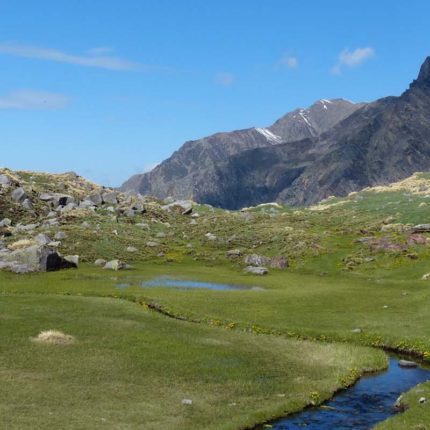
Obra Gad Trek
Obra Gad is amidst two idyllic valleys; Rupin and Supin
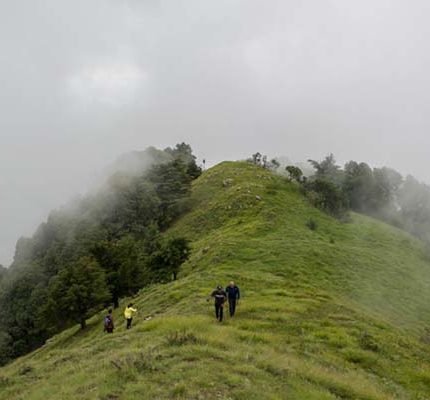
Devalsari Trek
This Virgin is nestled in the Aglar valley of Tehri Garhwal.
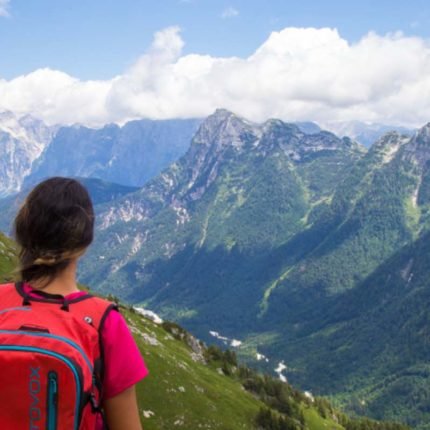
Chaainsheel Bugyal Trek
Chaainsheel Bugyal trek the most beautiful ridge trek
Price: ₹ 11,000.00
Book the tour
Send a quick enquiry.
- Overview Itinerary Dates Include/Exclude
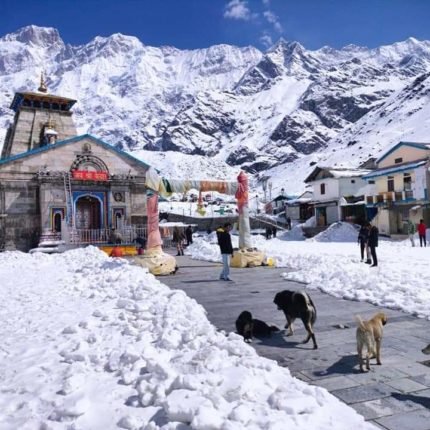
Shikhar Blog
Travel Experiences – Sharing Travel Memories Around the World

Kedarnath Yatra Trek Guide
The Kedarnath Yatra is a pilgrimage trek located in the Himalayas, in the state of Uttarakhand, India. The trek takes you to the Kedarnath temple, one of the four sacred shrines in Hinduism, known as the Char Dham Yatra . The traditional trekking route starts from Gaurikund and is about 16 km long, passing through beautiful Himalayan landscapes and villages. You need to obtain a permit from the Uttarakhand Forest Department to trek to the temple. Accommodation is available in guesthouses, lodges, campsites, and basic accommodation facilities in the temple premises. The best time to visit is from May to June and September to October. Ensure to carry essential items, follow guidelines, and respect local culture and traditions to have a safe and enjoyable trekking experience.
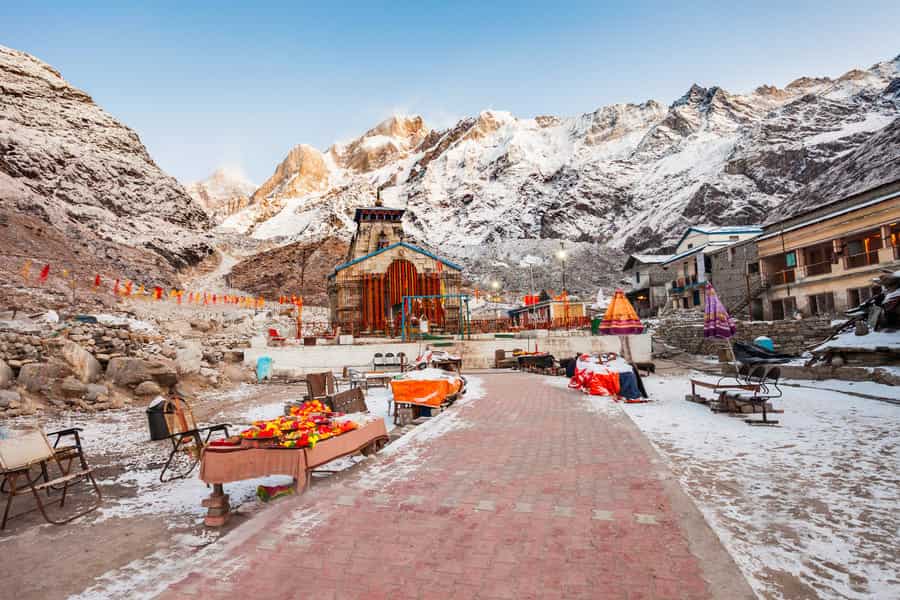
How to Reach Kedarnath by Road
Kedarnath is a remote pilgrimage site located in the state of Uttarakhand in India. It is not directly connected by road, and the last motorable point is at Gaurikund, which is about 16 km away from the temple. Here’s how you can reach Kedarnath by road:
You can take a bus from major cities in Uttarakhand like Haridwar, Rishikesh, and Dehradun to Gaurikund. There are also private bus operators that run buses from Delhi to Gaurikund. From Gaurikund, you need to trek for about 16 km to reach the temple.
You can hire a taxi from major cities in Uttarakhand like Haridwar, Rishikesh, and Dehradun to Gaurikund. It’s a long drive, and the road conditions can be challenging, especially during the monsoon season. From Gaurikund, you need to trek for about 16 km to reach the temple.
By Helicopter
If you want to avoid the long and arduous trek, you can take a helicopter from Guptkashi ,Phata and Sirsi to Kedarnath. Helicopter services are available from May to October, and you need to book your tickets in advance.
You can also drive to Gaurikund from major cities in Uttarakhand like Haridwar, Rishikesh, and Dehradun. The road conditions can be challenging, and you need to be an experienced driver to navigate the steep and narrow roads.
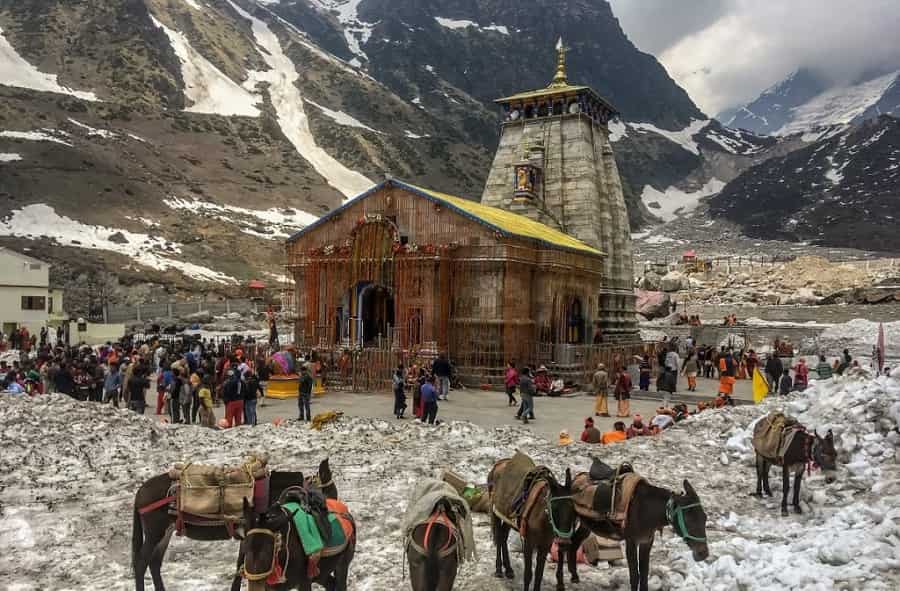
Kedarnath Route from Delhi
Here’s how you can reach Kedarnath from Delhi:
The nearest airport to Kedarnath is the Jolly Grant Airport in Dehradun, which is about 238 km away from the temple. You can take a flight from Delhi to Dehradun and then hire a taxi to reach Gaurikund. From Gaurikund, you need to trek for about 16 km to reach the temple.
The nearest railway station to Kedarnath is in Rishikesh, which is about 216 km away from the temple. You can take a train from Delhi to Rishikesh and then hire a taxi to reach Gaurikund. From Gaurikund, you need to trek for about 16 km to reach the temple.
You can take a bus from Delhi to Rishikesh, Haridwar, or Dehradun and then take another bus to Gaurikund. From Gaurikund, you need to trek for about 16 km to reach the temple.
By Self-Drive
You can also drive to Gaurikund from Delhi. The distance is about 443 km, and the route goes through Haridwar, Rishikesh, and Rudraprayag. The road conditions can be challenging, especially during the monsoon season, so make sure to check the weather conditions and plan your journey accordingly.
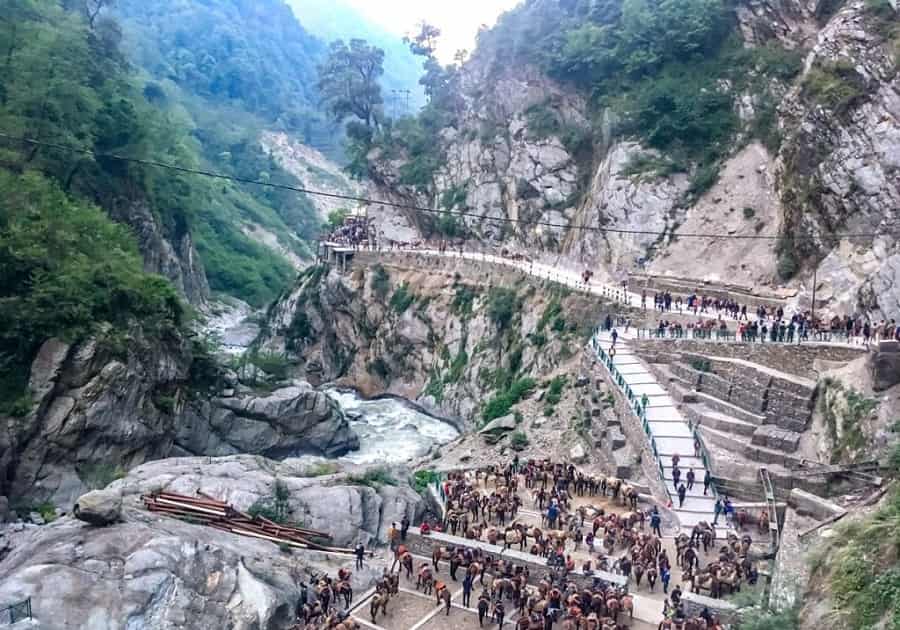
Kedarnath Trekking Distance
The trekking distance for Kedarnath temple depends on the route you choose. Traditionally, the trekking route starts from Gaurikund and is about 16 km long. The route goes through beautiful Himalayan landscapes, including forests, waterfalls, and rivers. The trek takes about 6-8 hours to complete, and the difficulty level is moderate.
It’s important to note that the altitude of Kedarnath temple is over 3500 meters, so you need to be physically fit and acclimatize properly to avoid altitude sickness.
Overall, trekking to Kedarnath temple is a beautiful and rewarding experience. Make sure to carry essential items, follow guidelines, and respect local culture and traditions to have a safe and enjoyable trekking experience.
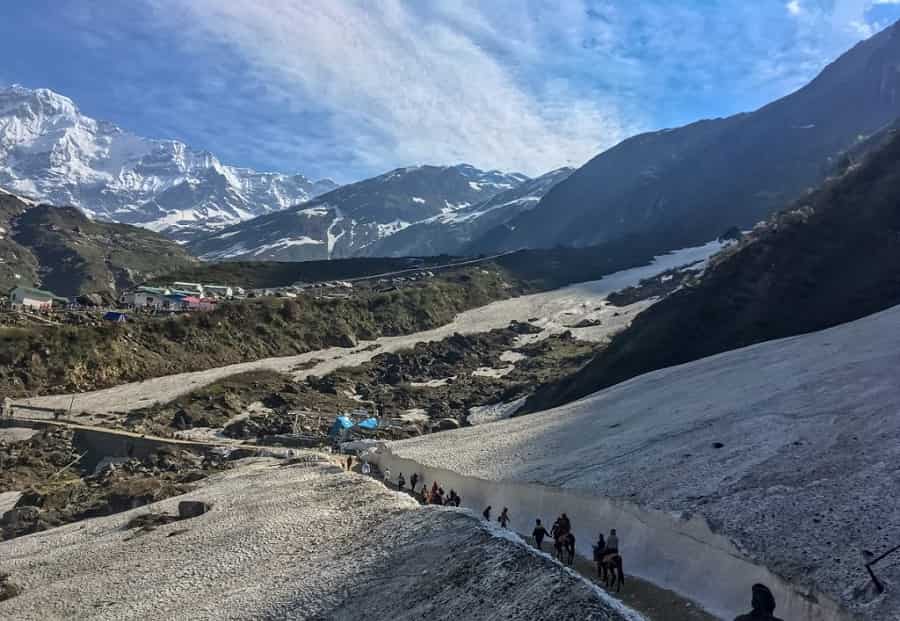
Facilities at Kedarnath Trek
The trek to Kedarnath is about 16 km long and takes about 6-8 hours to complete. Along the trekking route, there are several facilities available for the convenience of pilgrims. Here are some of the facilities available at Kedarnath trek:
Accommodation
There are several guesthouses and lodges available in Gaurikund as well as in Kedarnath. These accommodations are basic but provide a comfortable stay for pilgrims.
Food and Water
There are several shops and restaurants available along the trekking route that serve local food and refreshments. These shops also sell bottled water, which is essential for staying hydrated during the trek.
Medical Facilities
There are medical facilities available in Gaurikund and Kedarnath for pilgrims who need medical attention. There are also several medical aid posts along the trekking route.
Mule and Pony Services
For those who are unable to trek, mule and pony services are available to reach Kedarnath. These services can be hired from Gaurikund and are a convenient option for elderly pilgrims or those with physical disabilities.
Mobile Network Coverage
Mobile network coverage is available in Gaurikund and along the trekking route to Kedarnath. However, the network signal may be weak or non-existent in some areas.
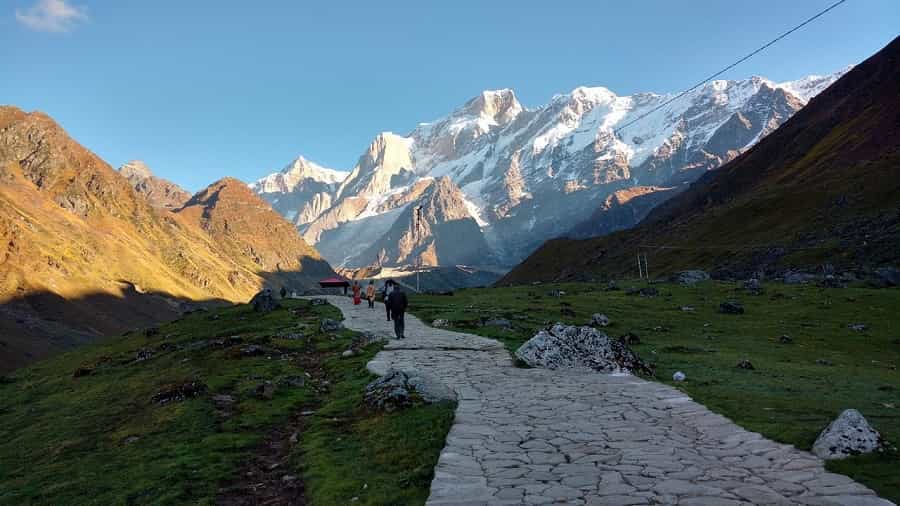
Kedarnath Distance Chart from Major Cities
Here are the distances from major cities in India to Kedarnath:
- Delhi to Kedarnath: The distance between Delhi and Kedarnath is about 445 km by road.
- Mumbai to Kedarnath: The distance between Mumbai and Kedarnath is about 1725 km by road.
- Kolkata to Kedarnath: The distance between Kolkata and Kedarnath is about 1500 km by road.
- Bengaluru to Kedarnath: The distance between Bengaluru and Kedarnath is about 2150 km by road.
- Chennai to Kedarnath: The distance between Chennai and Kedarnath is about 2300 km by road.
Kedarnath Trek Itinerary
Here is a sample itinerary for the Gaurikund to Kedarnath trek:
Day 1: Gaurikund to Kedarnath (16 km trek)
- Start early in the morning from Gaurikund (elevation 1,982 m) to Kedarnath (elevation 3,583 m)
- The trek passes through beautiful Himalayan landscapes, including forests, waterfalls, and rivers
- There are several rest points and shops selling refreshments along the way
- Reach Kedarnath in the evening and check into a guesthouse or lodge
- Visit the Kedarnath temple for darshan and participate in the evening aarti
Day 2: Explore Kedarnath
- Spend the day exploring Kedarnath and its surroundings
- Visit the Kedarnath temple for darshan and participate in the morning aarti
- You can also visit the Bhairavnath temple, which is a short trek away from Kedarnath
- Enjoy the scenic views and take part in some relaxation activities such as meditation or yoga
- Overnight stay at the guesthouse or lodge in Kedarnath
Day 3: Kedarnath to Gaurikund (16 km trek)
- Start early in the morning from Kedarnath to Gaurikund
- The trek downhill can take 4-6 hours, depending on your pace
- Reach Gaurikund and take a dip in the hot water springs to relax your tired muscles
- Take a taxi or bus from Gaurikund to your onward destination
Note : This itinerary can be customized based on your preferences and fitness level. It’s important to carry essential items, follow guidelines, and respect local culture and traditions to have a safe and enjoyable trekking experience. It’s also important to acclimatize properly to avoid altitude sickness.
New Trekking Route for Kedarnath Dham
Recently, a new trekking route has been opened for Kedarnath Dham, which is known as the “Kedarnath Musk Deer Conservation Trek.” This trekking route is a part of the Kedarnath Wildlife Sanctuary and offers a unique opportunity to trek through the dense forests of the sanctuary while enjoying the scenic beauty of the Himalayan range.
The trek takes around 3-4 days to complete, and it’s important to carry proper gear and clothing, including trekking shoes, warm clothes, rain gear, and a first aid kit. It’s also important to obtain the necessary permits and bookings in advance.
The Kedarnath Musk Deer Conservation Trek is a great opportunity for nature lovers and adventure enthusiasts to explore the pristine beauty of the Himalayas while also learning about the importance of wildlife conservation.
Trekking Tips & Things to Carry
Before going for the Kedarnath trek, here are some things to remember:
- Physical fitness : Kedarnath trek involves long hours of trekking and climbing steep slopes. It’s important to prepare yourself physically and mentally for the trek. Regular exercise, yoga, and stretching can help improve your fitness levels.
- Acclimatization: Kedarnath is located at a high altitude of 3,583 meters above sea level, and altitude sickness is a common problem. It’s important to take a day or two for acclimatization before starting the trek.
- Weather: Kedarnath is located in the Himalayan region and experiences unpredictable weather. It’s important to carry warm clothes, rain gear, and protective gear like hats and gloves.
- Essentials: Carry essential items like a first aid kit, sunscreen, insect repellent, water bottle, and snacks. It’s also advisable to carry a trekking pole to provide support and balance during the trek.
- Respect local culture: Kedarnath is a holy place, and it’s important to respect local culture and traditions. Avoid carrying non-vegetarian food and alcohol.
- Permits and bookings: Make sure to obtain the necessary permits and bookings in advance to avoid any last-minute hassle.
- Environment: It’s important to keep the trekking trail clean and avoid littering. Avoid using plastic and dispose of waste properly.
Remembering these things will help ensure a safe and enjoyable trekking experience in Kedarnath.
Best Time for Kedarnath Yatra Trek
The best time for the Kedarnath trek is from May to June and September to Oct/Nov (till Diwali).
During May and June, the weather is pleasant, and the snow starts to melt, making the trekking trail more accessible. The temperature during this period ranges from 10°C to 20°C, and the days are sunny, making it a good time to trek.
September to Oct/Nov (till Diwali) is also a good time to trek as the monsoon season ends, and the weather starts to cool down. The temperature during this period ranges from 5°C to 15°C, and the skies are clear, making it a good time to enjoy the views.
The monsoon season from July to August should be avoided as heavy rainfall can make the trekking trail muddy and slippery. During winter, the trekking trail is covered with snow, and the temperature drops to sub-zero levels, making it inaccessible for trekking.
It’s important to note that the weather in the Himalayas can be unpredictable, and it’s advisable to check the weather forecast before planning the trek. Also, it’s important to carry proper gear and clothing as the temperature can drop significantly at night, even during the best trekking season.
16 Comments
Kedarnath Trek from tomorrow
Nice information
Nice and useful blog author. thank you. keep it up.
thanks for writing such an informative piece
So beautiful this places
Good info. Thanks for sharing
senior citizens (75 yr,/68yrs going to kedarnath &badrinath on fr0m 10 July 23.What precaution to take what will be the weather temperature, rainfall etc
Very useful and well detailed Blog. Thanks for your guidance!
Very useful information for kedarnath yatris. Starting the trek tomorrow morning from Gaurikunda.
Inspiring tips, enhanced my travel savvy. Ready for new adventures! Thanks!
Is it possible to trek up and down the same day (during May-June) if your fitness is good. Means you start early in the morning, maybe 5.00am and come back by 6.00pm in the evening.
Comments solicited from devotees who have real experience of visit
While it is technically feasible to attempt a round-trip trek to Kedarnath in a single day, covering approximately 19 km each way, we strongly discourage this approach. The demanding nature of the trek, combined with unpredictable weather conditions, poses potential risks even for individuals with excellent fitness levels.
We recommend a more prudent itinerary that allows for proper acclimatization, safety precautions, and the appreciation of the scenic surroundings. Rushing through the trek may compromise these crucial aspects and jeopardize the overall experience. Opting for a well-paced and thoughtful trekking plan is advised for both enjoyment and safety.
Very well informative
Are the trek by pony available on the spot itself or advance booking is required ? How much they charge for one person ? Is the pony trek available within ertain hours or is it available throughout the day and night? Thank you
Yes, you can book a pony on the spot yourself. Its cost may be around 10 to 15 thousand, depending on your bargaining skills.
What about priority Darshana ticket this year.How we can book
Leave a Reply Cancel reply
Your email address will not be published. Required fields are marked *
Save my name, email, and website in this browser for the next time I comment.
This site uses Akismet to reduce spam. Learn how your comment data is processed .

- Group Tours Calendar
- Planning, Sightseeing & Routes
- Preparing for Ladakh Trip
- Stay, Eat, Permits & Others
- Taxis, Self-Drives & Bike Rentals
- Public Transport & Budget Travel
- Preparing for Spiti Valley Trip

Kedarnath – How to plan a trip [Complete Travel Guide]
Kedarnath is a divine Hindu settlement situated in Rudraprayag district of Uttarakhand. It is one of the Char Dhams located in the Himalayas, and is situated at an astounding height of 3584 meters above sea level near the head of Mandakini River.
The Kedarnath temple lies amidst the majestic snow-capped Garhwal Himalayan ranges and is thronged by thousands of tourists and pilgrims each year. Also, the Kedarnath trek is stunningly beautiful and quite eclectic, even in the trekking circuit.

Famous for the ancient shrine devoted to Lord Shiva, it offers a calm atmosphere with a beautifully painted backdrop thanks to the rhododendron woods, snow-covered mountains, and splendid sights of nature. An amalgamation of devoutness and adventure is what makes it incomparable. A MUST VISIT for one and all.
Let's quickly dive into the details:
About Kedarnath
Kedarnath literally means the Lord of the field, and it is so called because the “crop of liberation” grows here. While it is not certain who constructed the temple or when! One of the earliest references of Kedarnath is in the 7th or 8th century. It is also believed that Adi Shankara died near the sanctuary.
History & Mythology
It is believed that post the battle of Kurukshetra, Pandavas went on a journey to Banaras in order to repent killing their own and seek blessings from the Lord. But, Shivji wanted to avoid meeting with the brothers, and thus, took solace in Guptakashi.
However, Pandavas were relinquishing in their search for the Lord and when they found him, Shivji decided to take the form of buffalo so that they couldn’t recognize him. Now, when Shivji saw the Pandavas approaching closer, he wanted to hide even further.
Thus, He took the decision to also become invisible by way of going underground. However, brother Bhīma tried hard to stop him from leaving by holding on to the legs and tail of the bull. Unfortunately, the Lord dived and evaporated at that place leaving behind his hump which is now worshipped at Kedarnath Temple.
It is however believed that through cosmic energy, the Pandavas were exempted from their sins and Shivji informed that from then onwards He would be present in Jyotirlinga form at Kedarnath.
Located in the Rudraprayag district, Kedarnath is the most remote of all Chota Char Dham sites. Situated near the Chorabari Glacier – the source of the Mandakini river, Kedarnath is flanked by snow-capped peaks – most prominently the Kedarnath mountain (6,940 mts) and the Kedar Dome (6,831 mts). Located at a distance of 223 KM from Rishikesh, the town is built on a barren stretch of land on the shored of the river.
The town unfortunately suffered extensive destruction during 2013 due to flash floods caused by torrential rains in Uttarakhand. The temple magnificently survived the harsh calamities!
In line with the Himalayan weather, Kedarnath experiences cool summers while the winters are extremely difficult and harsh. Summer is ideal for all sight-seeing, temple visits and experiencing nearby attractions as well. The average temperature is around 17 degrees in the summer.
Monsoon months are difficult and the area has suffered extreme rainfall many times, particularly in 2013. Monsoon weather is around 12 degrees. Winters are cold, complex and inhabitable. The palki of Lord Kedarnath is transferred to its winter abode near Guptakashi – Ukhimath from November to April. Weather in this season is always in the negative!
Dheeraj Sharma
Best time to visit Kedarnath
Right at the beginning of the season in April till the onset of monsoons and post-monsoon till close of the season. Kedarnath has a cold climate for most part of the year and the best months to travel are May, June, September, October.
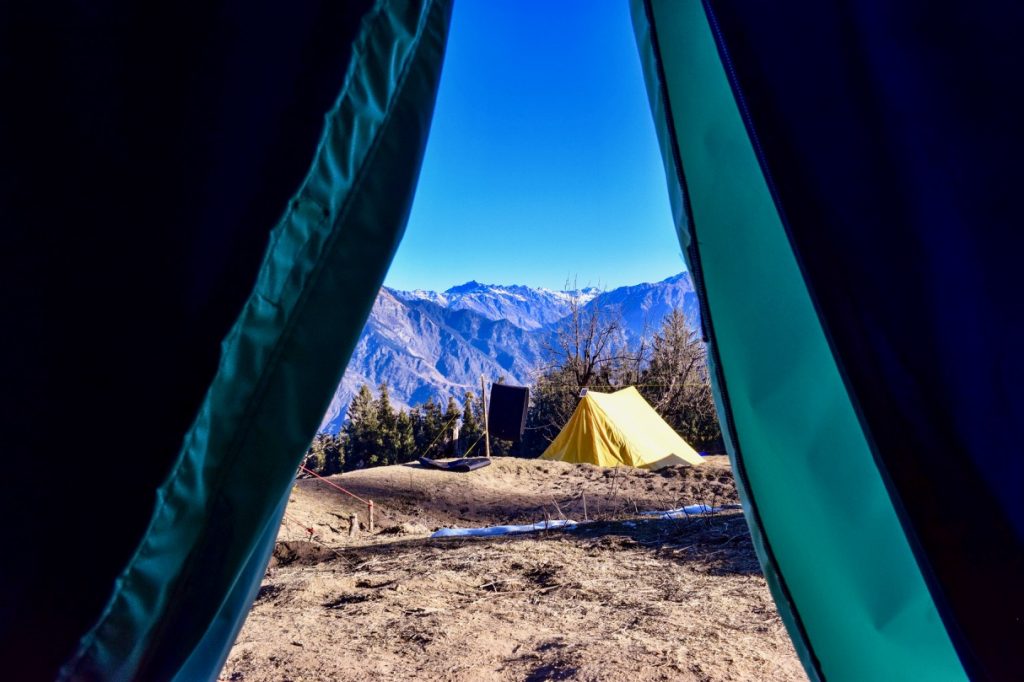
How to get there
Kedarnath is well connected with most of the important towns of Uttarakhand. The nearest road head to Kedarnath is about 18 KMs later, Gaurikund.

Jolly Grant Airport, Dehradun is the closest airport, at a distance of 238 KMs. The airport is well connected to Delhi with daily flights. Taxis are easily available from the airport to Gaurikund.
The nearest railway station to Kedarnath is Rishikesh, at a distance of 216 KMs before Kedarnath on NH58. Further, Gaurikund is well connected by motorable roads with Rishikesh. Taxis and buses are easily available to reach Gaurikund.
Prior to reaching Kedarnath, the last motorable point is Gaurikund. From there on out, you’ll be trekking for 16-odd-km. Gaurikund is connected with major destinations in North India. Buses and shared cabs are available from Haridwar, Rishikesh & Rudraprayag to Sonprayag, the last point until which private vehicles are allowed.
Buses to Rishikesh and Shrinagar are available from ISBT, Kashmiri Gate. From Sonprayag, there is a shared cab facility offered by the government, where the cab will drop you in Gaurikund for a fee.
Helicopter Options
You may even get a helicopter ride if you’re not into trekking (although I strongly recommend the trek!). The services are available from different helipads such as Guptkashi, Sersi, Phata etc.
What to do in Kedarnath
Given that Kedarnath is a religious destination, clearly the centermost attraction are places with mythological connotations.
Kedarnath Temple
Enveloped in the mighty Garhwal Himalayas, the Kedarnath Temple is one of the twelve Jyotirlingas of Lord Shiva. Dedicated to Lord Shiva, Kedarnath Temple is among the 275 temples of Paadal Petra Sthalams (the most powerful Shiva temples in the world) and is also the most important among the Panch Kedars.
With fresh air synonymous with the hills and stunning views that you have to earn – you will lose all sense of time here! For thousands of year, this place has been worshipped and the energy of the region is that of positivity, hope and beliefs for the future.
Inside the temple, you’ll be greeted with a small hall with images of Parvati as well as the Pandavas. The hall is decorated with statues of Krishna, Pandavas, Draupadi, Virbhadra and many other deities! There is a conical rock inside the temple which is worshipped as the Sadashiva (forever Shiv).
Made from grey stones which are interlocked with the use of iron clamps – the temple is truly striking in the backdrop of Himalayas.
Gandhi Sarovar
Gandhi Sarovar is a small crystal clear lake, also known as Chorabari Tal. This is so because it is situated on the mouth of Chorabari Bamak glacier. Gandhi Sarovar lies on the foot of Kedarnath and Kirthi Stambh peak at an astounding altitude of 3,900mts above sea level. The lake comes after completed further 4 KMs trek from Kedarnath Temple.
Kalimath is a religious place located on the banks of Saraswati river. Located at a height of 1800 mts, Kalimath is one of the 108 Shakti Peeths in India. Kalimath lies on lap of nature offering salubrious and divine environment. Goddess Kali Temple is located in Kalimath. Legends believe that after killing Raktbeej, Kali Goddess went underneath the ground at this place!
Bhairav Temple
Bhairavnath Temple or Bhairon Baba Mandir is situated south of the Kedarnath temple on the eastern hill of the lofty Himalayas of Uttarakhand. The temple is dedicated to Bhairav – the fierce manifestation of Lord Shiva associated with destruction and devastation. The temple offers some stunning views of the Himalayas and it is a beautiful portion of your journey to Kedarnath!

Gaurikund Temple
Gaurikund temple is a temple dedicated to Goddess Parvati. According to myths and legends, this is the place where Goddess Parvati did penance involving ascetic and yoga practices to win over Shiva’s heart. It is believed that Lord Shiva admitted his love for the Goddess here and they then married at Triyuginarayan temple.
Shankaracharya Samadhi
Adi Shankaracharya was a philosopher, credited with unifying and establishing the main thoughts in Hinduism. At the age 32, he decided to attain moksha at Kedarnath and merged under with the land near the Kedarnath Temple. The samadhi is situated right behind the temple.
What to do around Kedarnath
There is so much to explore around the Kedarnath Temple. So, remember to keep some time at hand to truly immerse yourself into the experience!
Vasuki Tal Lake
Vasuki Tal is a high glacial lake situated at an impressive altitude of 14,200 feet above sea level near Kedarnath Dham. One can spot Brahma Kamal and other Himalayan flowers blooming around the placid lake, making for some spectacular views.
Ideally, I would suggest you complete the route in the day time itself, and spend the night at Kedarnath! The trek distance from Kedarnath temple is 8 KMs, initial 3-4 KMs is easy before the ascend begins. The icy Vasuki Tal is just 900 meters downhill from Vasuki top.
Guptkashi is situated 47kms before the holy shrine of Lord Shiva, Kedarnath. It is located on the route to Kedarnath on a ridge on the west side of the Mandakini river valley at an elevation of 1,319mts above sea level.
Guptkashi is a religiously important town of Uttarakhand as it houses ancient temples like Vishwanath temple and Ardhnareshwar temple. A highly revered attraction, Manikarnika Kund is where two streams of the Ganga and Yamuna meet.
Kedarnatha Trek
Kedarnatha trek is in one of the most significantly religious areas, especially in the Hindu Mythology. The Temple of Lord Kedarnatha (Shivji), which sits at the base of the summit, has stood the test of time and is revered amongst spiritual believers.
Millions of pilgrims move mountains to offer their prayers and seek blessings of the Hindu Deity each year. The temple itself lies at the base of the Kedarnath Peak, facing the Kedar Parvat. A beginner level trek, Kedarnath is especially beautiful in the winter months.
One of the most remarkable crests in the Himalayan region, both nature lovers and ardent trekkers tend to enjoy the experience.
Char Dham Yatra
The Chota Char Dham Yatra of Uttarakhand is the four abodes of holy shrines – Badrinath , Kedarnath, Yamunotri, and Gangotri . All four of these temples are situated within the Garhwal region of Uttarakhand. The prominence of the Charm Dham Yatra is immense amongst Hindus.
Moreover, it is believed that every Hindu should do Char Dham Yatra at least once in their lifetime. The Great Reformer and Philosopher, Adi Shankaracharya, gathered together these Holy Pilgrimage places into a spiritual circuit around the 8th century.
Generation followed generations and hundreds of thousands of devotees have kept up the tradition of covering these pilgrimage spots every year. Thus, it is very common to complete the circuit in one religious pilgrimage!
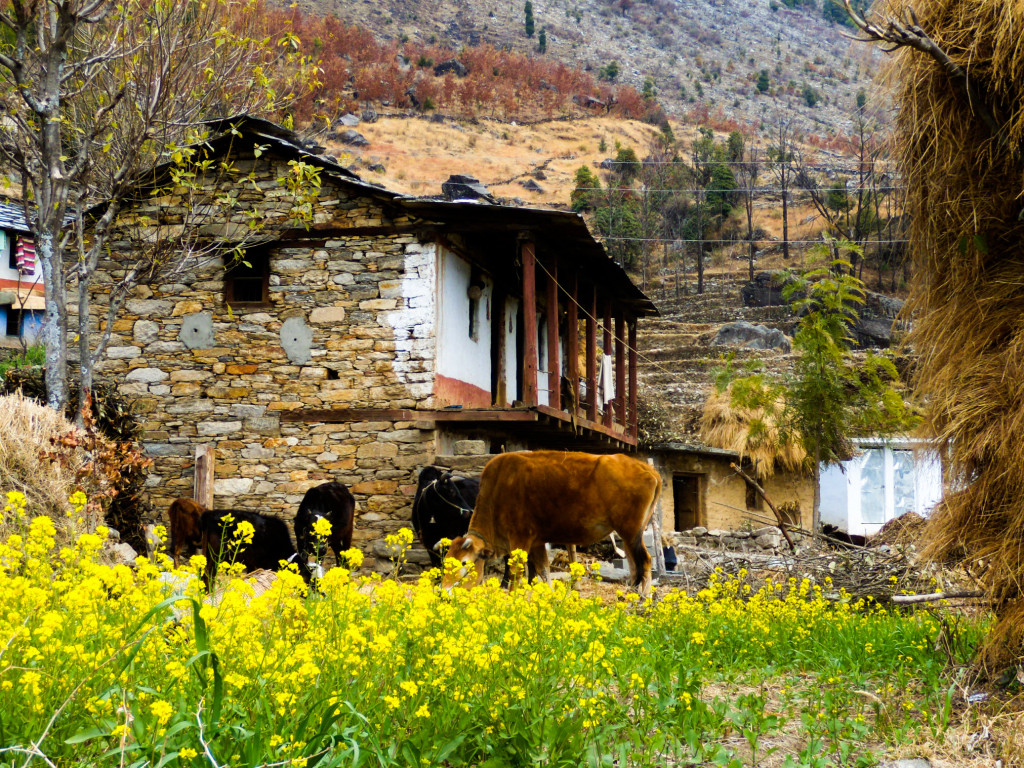
Best places to stay near Kedarnath
There is a huge government-run tented colony along with cottages as well as rooms run by GMVN. These are sufficient to home more than a thousand pilgrims and visitors. Also, there are hotels, guest houses, and Dharamshala as well.
A lot of folks have started taking the journey via helicopters and thus stay locations can be Phata, Rampur, Gaurikund, Sitapur etc.
Best places to eat
Unfortunately, the only option for decent food here is the food stalls and roadside dhabas. Food available is mostly north Indian cuisine. Of course, given the highly revered place in Hinduism that Kedarnath holds, it should come as no surprise that alcohol and non-vegetarian food is not served/ is prohibited.

Things to keep in mind
- As instructed by the Uttarakhand government, it is necessary for every traveler to do bio-metric registration. The facility is available online as well. Alternatively, you may also do the same at Sonprayag.
- You can easily find mules & porters to accompany you on your journey. Do remember to check the prices officially posted so as to avoid paying a larger sum
- Also, if you are hiring porters or mule owners – remember to check their official IDs
- It is always wise to avoid the hilly terrain in the monsoon season. Especially given the tragedy of 2013, and how badly Kedarnath was hit. If you are still heading there in the monsoon period – do check with officials and local authorities
- Photography is not allowed in the temple premises. Be mindful of the fact and abide by the rules of the temple authorities.
Tips when travelling to Kedarnath
- The trek is 16 KM long and will take you 6 hours, depending on your health
- Try to start your trek early in the morning to avoid the harshness of the afternoon sun
- Remember to eat a hearty (though not heavy) breakfast
- Drink water and stay hydrated. However, do remember to carry your own water bottles.
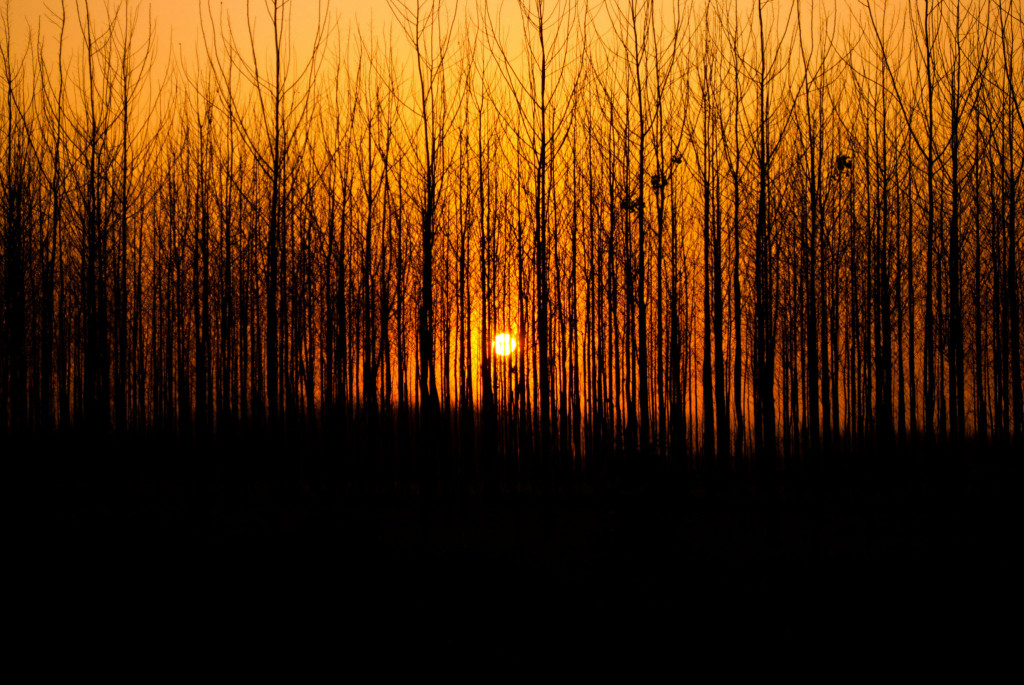
If connecting with nature and the Gods, rejuvenation and some adventure is on the cards for you on your next holiday – head on over to Kedarnath. This place will take you back to a time of simplicity and authenticity.
You will fall in love with the quaint life of the hills and revered by the sheer power of belief. If you have any questions regarding this beautiful wonderland – do comment below and I will be happy to answer any of your queries.
Happy travelling!
Shefali spends most of her time day dreaming about her next big vacation. A happy-go-lucky personality, she is an amalgamation of all the places she’s lived in and experienced! She is always confused as to where to call home, having lived in Chandigarh, Shimla, Dehradun, Mumbai, Hyderabad in India and Vancouver, Abbotsford in Canada. Her love for travel is only challenged by her love for reading and eating delicious food! In order to sustain her dreams, she brought out her inner geek, got an MBA and has a job in the corporate world crunching numbers. Do follow @notravelplans on Instagram for updates on her next great adventure.
Related Posts
Garhwal in uttarakhand – most common itinerary [day by day plans], harsil – gangotri trip | most common itineraries [day-by-day plans], mukteshwar in uttarakhand – the most complete travel guide.
Comments section gets closed in 90 days. To ask your travel questions, you can follow my YouTube Channel for a faster reply or for a much slower reply follow me on Instagram . :)
Hi Shefali, Your article about Kedarnath is really good and contains all the necessary details to plan a trip there. However, I had one query – is it a good idea to plan the trip in the 1st or 2nd week of July this year? Actually I am having some other schedule in May, June and in September and October 2021. So, thinking of going there in July 1st or 2nd week.
July shall be fine to visit Kedarnath, just keep a check on the weather and usually, it shall be OK to visit before mid of July
Type above and press Enter to search. Press Esc to cancel.
Privacy Overview
Ad blocker enabled.
- KEDARNATH TREK
Interesting fact about the kedarnath Trek
Brief description about the trek.
Kedarnath Temple, located in the Indian state of Uttarakhand, is a renowned Hindu pilgrimage site dedicated to Lord Shiva. The temple is situated at an elevation of approximately 3,583 meters (11,755 feet) above sea level in the Garhwal Himalayas, near the Mandakini River. The temple holds great religious significance and is one of the twelve Jyotirlingas (manifestations of Lord Shiva) in India. The trek to Kedarnath Temple is an adventurous and spiritual journey that attracts thousands of devotees and nature enthusiasts every year. The trekking route typically begins at Gaurikund, which is the base camp for the Kedarnath Yatra. Gaurikund is easily accessible by road and serves as the starting point for the pilgrimage. The trek from Gaurikund to Kedarnath is approximately 16 kilometers (10 miles) long and takes you through breathtaking landscapes, steep hills, and lush green forests. The trail passes through several picturesque villages like Rambara and Garurchatti, offering glimpses of local culture and traditional way of life. Along the way, you will also come across natural hot water springs known as "kunds," which are believed to have medicinal properties. The journey can be physically demanding, especially due to the altitude gain and steep sections, so it is important to be prepared and physically fit. The trek usually takes around 6 to 8 hours to complete, depending on your pace and the weather conditions. It is advisable to start early in the morning to avoid any potential difficulties or unfavorable weather. Upon reaching Kedarnath, you will be greeted by the majestic Kedarnath Temple, a stone structure believed to be over a thousand years old. The temple's architecture is exquisite, reflecting ancient Indian construction techniques. It is surrounded by snow-capped peaks, creating a serene and awe-inspiring atmosphere. After seeking blessings at the temple, you can spend some time exploring the area and admiring the natural beauty that surrounds it. The temple is also the starting point for several other treks, including the Vasuki Tal and Chorabari glaciers. It is important to note that due to the high altitude, weather conditions in the region can be unpredictable. It is advisable to check the weather forecast and carry appropriate clothing and gear, including warm clothes, rain gear, sturdy shoes, and a first aid kit. It is also recommended to travel in groups or hire a local guide for a safe and enjoyable experience. The Kedarnath Temple trek offers a unique blend of spirituality, adventure, and natural beauty. It is a journey that allows devotees and nature lovers to connect with the divine and experience the breathtaking Himalayan landscape.
DETAILED ITINERARY
Day 1 - rishikesh/haridwar to guptkashi.
- Start your journey early in the morning from Rishikesh or Haridwar, which are well-connected cities in Uttarakhand. - Travel by road to reach Guptkashi, the base camp for the Kedarnath trek. The distance is approximately 200 kilometers (124 miles) and takes around 7-8 hours by car or bus. - Enjoy the scenic drive as you pass through picturesque towns, rivers, and mountains. - Upon reaching Gaurikund, check into a guesthouse or hotel for an overnight stay.
Day 2 - Guptkashi to Kedarnath
Day 3 - kedarnath to guptkashi.
- Wake up early and witness the morning aarti (ritual) at the Kedarnath Temple. - After breakfast, begin the descent from Kedarnath to Gaurikund. - Trek back the same route, enjoying the natural beauty and serenity of the surroundings. - Arrive at Gaurikund and then proceed to Guptkashi. - Check into a hotel or guesthouse in Guptkashi for an overnight stay.
Day 4: Guptkashi to Rishikesh
- After breakfast, start your journey back to Rishikesh. -Travel by road, relishing the scenic vistas and the spiritual atmosphere of Uttarakhand. - As you traverse the winding roads, relish the scenic beauty of Uttarakhand's landscapes and the majestic Himalayas. - End of the Kedarnath Temple trek.
Kedarnath weather
Important note -:, inclusion/exclusion, cost inclusion.
- All breakfast, lunch and dinner meals during the trek. - All Government Taxes and Vat. - All guide and porter(s) accommodation, meals, drinks, insurance, salary, equipment, transportation, local tax during the trek. - Group medical supplies (first aid kit will be available). - All necessary Government required paperwork and National Park Entry Permits and TIMS Card, etc.
COST EXCLUSION
- Meals during Transportation. - All drinks – tea, coffee, other hot, water, soft drinks, alcoholic. - Your travel insurance. - Personal shopping, laundry etc. Personal trekking equipment - Tips for trekking staff and driver. Tipping is expected, but it is not mandatory - All other tour, sightseeing and other activities outside of the main trek.
PAYMENT POLICY
50 % advance and balance before 15 days of the tour.
CANCELLATION POLICY
- 50% refund if cancelled before 30 days of tour cost. - No refund if cancelled in 0 to 30 days of tour.
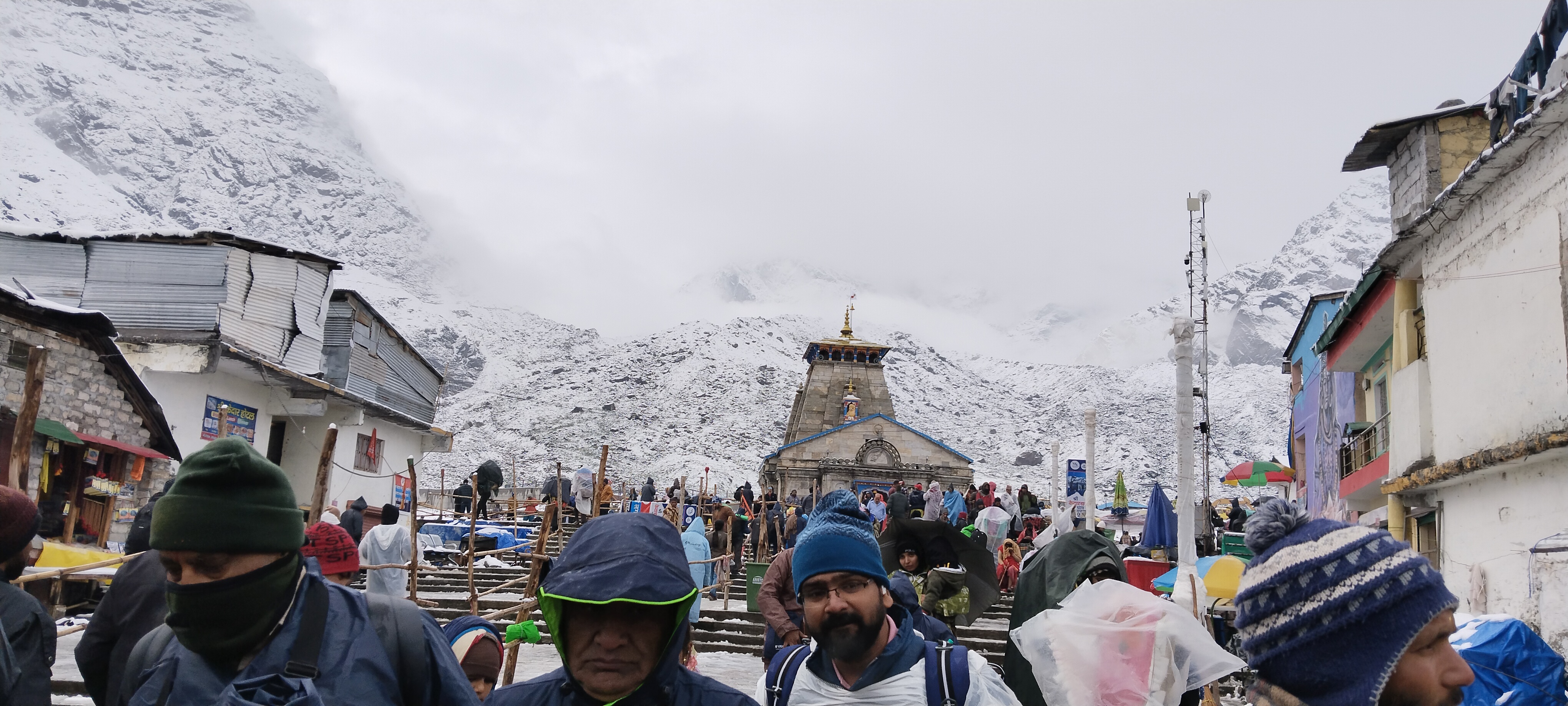
Mandatory Documentss
The original document of identity proof- driver’s license, Aadhar card, the passport will be fine. It is very important to have your identity proof with yourself while on a journey.
I hope this detailed itinerary and package inclusion information meet your requirements. If you have any more questions, feel free to ask!
Scenic views during the kedarnath trek.
During the Kedarnath trek, you will witness several scenic views that showcase the mesmerizing beauty of the Himalayas and the surrounding landscapes. Here are some of the notable scenic views you can expect during the trek:
- Mandakini River
- Bharatekuntha
- Kirti Stambh
- Kedarnath Peak
Each step of the Kedarnath trek unfolds stunning vistas, allowing you to connect with the raw beauty of nature. The combination of mountains, rivers, forests, and waterfalls creates an unforgettable experience that combines both physical and visual delights..
We use only trusted, verified content, so you can believe our every word.
Catherine Williams
Kedarnath Trek - Discovering its Mystique.
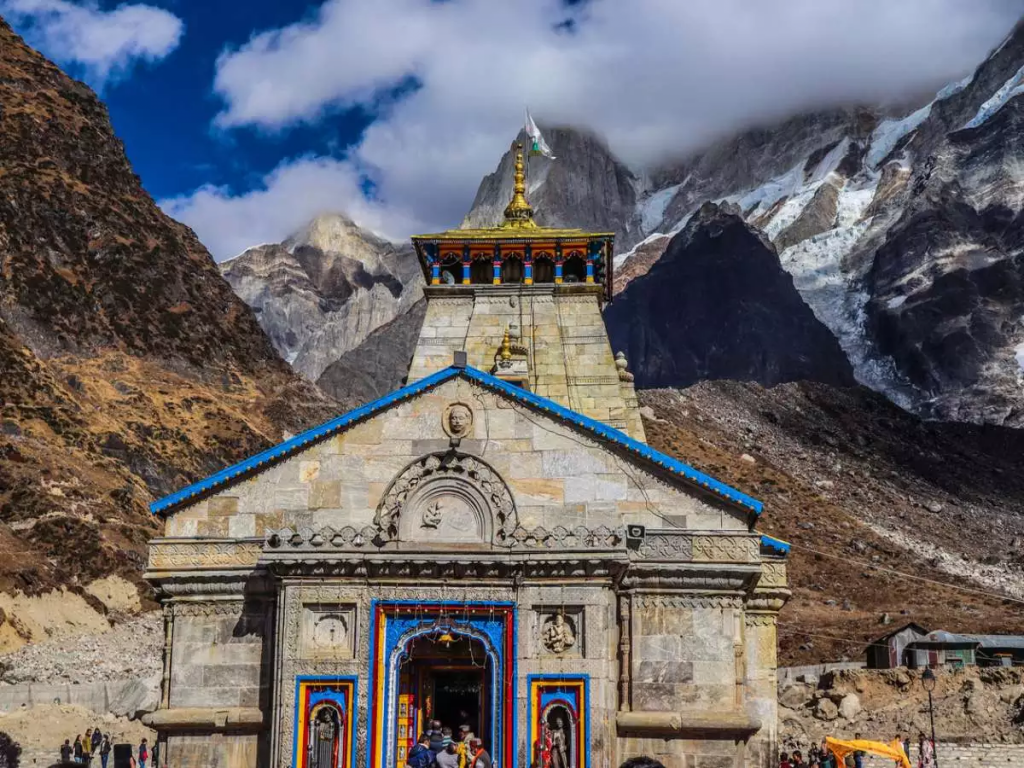
Introduction:
Kedarnath Trek – Nestled amidst the mighty Himalayas lies the sacred destination of Kedarnath, a revered pilgrimage site for Hindus and a trekker’s paradise. The Kedarnath Trek offers not only breathtaking views of nature but also a glimpse into the rich history and spirituality of the region.
History and Mythology: Kedarnath Temple
The history of Kedarnath is intertwined with Hindu mythology. Legend has it that after the great Mahabharata war, the Pandavas sought redemption for their sins of fratricide. Lord Shiva, unwilling to forgive them, took the form of a bull and fled, diving into the ground at Kedarnath. The hump remained visible, thus giving rise to the revered Jyotirlinga of Kedarnath.
The Trekking Experience: Kedarnath Trek
Embarking on the Kedarnath Trek is not just a physical journey but a spiritual odyssey. The trek typically starts from Gaurikund, where devotees take a dip in the hot springs before commencing their journey. The trail winds through picturesque landscapes, lush forests, and challenging terrains, offering a test of endurance and faith.
Attractions of Kedarnath / What to See in Kedarnath
Kedarnath Temple : This ancient Hindu temple dedicated to Lord Shiva is the main attraction of the town. It’s one of the twelve Jyotirlingas and holds immense religious significance for Hindus. The temple’s architecture, nestled amidst the Himalayas, is awe-inspiring. Chorabari (Gandhi Sarovar) : This glacial lake is located around 3 km from Kedarnath and is believed to be the place where Mahatma Gandhi’s ashes were immersed. The trek to Chorabari offers serene views of the surrounding mountains and glaciers. Bhairavnath Temple : Situated around 1 km away from Kedarnath Temple, this temple is dedicated to Bhairava, a fierce manifestation of Lord Shiva. It’s believed that visiting this temple is essential for a complete pilgrimage to Kedarnath. Vasuki Tal : A picturesque lake located at an altitude of around 4,150 meters above sea level, Vasuki Tal is surrounded by breathtaking Himalayan peaks. It’s a popular trekking destination, offering stunning views of the surrounding landscapes. Trijuginarayan Temple : Located around 5 km away from Kedarnath, this temple is believed to be the place where Lord Shiva and Goddess Parvati got married. The eternal flame burning at this temple is said to have witnessed their wedding. Gaurikund : Situated around 16 km from Kedarnath, Gaurikund is a small town known for its hot water springs. It’s also the starting point for the trek to Kedarnath Temple. Rambara : Located en route to Kedarnath Temple, Rambara is a scenic spot surrounded by lush greenery and towering mountains. It’s a popular camping site for trekkers and pilgrims..
Activities in Kedarnath
Spiritual exploration:.
- Visit Kedarnath Temple : Explore the ancient and revered Kedarnath Temple dedicated to Lord Shiva.
- Offer Prayers : Participate in religious rituals and offer prayers at various temples and sacred sites.
- Attend Aarti : Experience the divine atmosphere by attending the evening aarti (ritual of worship) at Kedarnath Temple.
Nature and Adventure:
- Trekking : Embark on treks to scenic spots like Vasuki Tal, Chorabari, and Gaurikund.
- Pilgrimage Trek : Undertake the pilgrimage trek from Gaurikund to Kedarnath Temple.
- Scenic Views : Enjoy panoramic views of the Himalayas and surrounding landscapes.
- Photography : Capture the breathtaking natural beauty of the region through photography.
Cultural Immersion:
- Explore Local Culture : Interact with locals and learn about their customs, traditions, and way of life.
- Visit Trijuginarayan Temple : Explore the historic Trijuginarayan Temple associated with the marriage of Lord Shiva and Goddess Parvati.
- Attend Festivals : If your visit coincides with local festivals, participate in the celebrations to experience the vibrant culture of the region.
Relaxation and Reflection:
- Meditation : Find peace and tranquility amidst the serene surroundings for meditation and introspection.
- Hot Springs : Relax and rejuvenate in the natural hot water springs of Gaurikund.
- Nature Walks : Take leisurely walks amidst the lush greenery and serene atmosphere for relaxation and reflection.
Adventure Sports (Depending on Availability):
- Helicopter Ride : Experience a thrilling helicopter ride offering aerial views of Kedarnath and the surrounding Himalayan peaks.
- Pony Rides : Enjoy pony rides for a unique perspective of the landscape, especially during the trek to Kedarnath Temple.
Wildlife and Nature Observation:
- Bird Watching : Explore the rich avifauna of the region through birdwatching expeditions.
- Flora and Fauna : Observe the diverse flora and fauna of the Himalayan ecosystem.
Environmental Conservation:
- Responsible Tourism : Practice responsible tourism by minimizing your environmental footprint and respecting the local ecosystem.
- Educational Tours : Participate in educational tours or workshops focused on environmental conservation and sustainability.
Inspire Tourist in Kedarnath
🌟 discover divine majesty in kedarnath 🌟.
Welcome to a land where spirituality gracefully intertwines with splendor, where ancient temples majestically stand tall amidst the towering Himalayan peaks, and where every step becomes a profound journey of self-discovery. Welcome to Kedarnath!
Embark on a Spiritual Odyssey :
Embark on a journey deep into the heart of Hindu spirituality as you gracefully visit the sacred Kedarnath Temple, a timeless symbol of devotion and faith. Let the echoes of hymns resonate within you and the soothing scent of incense gently guide you on a soul-stirring pilgrimage.
Embrace Nature’s Magnificence :
Immerse yourself in the breathtaking beauty of the Himalayas as you gracefully trek through pristine forests, marvel at cascading waterfalls, and deeply breathe in the crisp mountain air. From the tranquil shores of Vasuki Tal to the majestic vistas of Chorabari, every moment unfolds as a captivating brushstroke of Mother Nature’s masterpiece.
Experience Cultural Richness :
Immerse yourself deeply in the rich tapestry of Kedarnath’s culture and traditions. Explore the historic temples, witness the age-old rituals, and engage with the warm-hearted locals, whose hospitality knows no bounds. Let every encounter along the way be a joyous celebration of unity amidst diversity.
Renew Your Spirit :
Reconnect deeply with yourself amidst the serene surroundings of Kedarnath. Meditate in the tranquil meadows, soak in the healing waters of Gaurikund, and find solace in the comforting embrace of the mountains. In Kedarnath, every moment graciously extends an invitation to rediscover inner peace and serenity.
Create Unforgettable Memories :
Whether you’re a seeker of adventure or a seeker of the soul, Kedarnath graciously offers experiences that will linger with you forever. Capture the breathtaking sunsets that paint the sky in hues of gold, embark on thrilling treks that courageously test your limits, and forge bonds that beautifully transcend language and borders.
Come, Be Enchanted :
Allow Kedarnath to gracefully weave its magic upon you. Let its timeless allure gently awaken your spirit, ignite your senses, and tenderly leave an indelible imprint on your heart. In every whisper of the wind and every gentle rustle of the leaves, hear the resounding call of the mountains, warmly beckoning you to embark on a journey of a lifetime.
Kedarnath Awaits Your Presence!
SEASONS OF KEDARNATH:-
Kedarnath experiences distinct seasons throughout the year, each offering its own unique charm and opportunities for exploration. Here’s a glimpse into the different seasons of Kedarnath:
Spring (March to May) :
- As spring gracefully unfolds in Kedarnath, a sense of renewal permeates the air as the snow begins to melt, revealing the lush green meadows and vibrant blooming flowers. The weather during this season is pleasantly mild, making it ideal for trekking and engaging in various outdoor activities. Pilgrims can joyfully embark on their sacred journey to Kedarnath Temple amidst the vibrant colors of nature, further enriching their spiritual experience.
Summer (June to August) :
- During the summer months, Kedarnath welcomes visitors with mild temperatures during the day and pleasantly cool nights, creating an ideal atmosphere for exploration. It marks the peak pilgrimage season, with a significant influx of devotees making their way to the revered Kedarnath Temple. Amidst this bustling period, the surrounding Himalayan landscapes reveal their most picturesque vistas, enticing adventurers with abundant opportunities for trekking and sightseeing.
Monsoon (July to September) :
- During the monsoon season, Kedarnath experiences heavy rainfall, often resulting in landslides and disruptions in travel. Despite the challenges posed by the rain, the region’s lush greenery flourishes, imbuing the surroundings with a serene and refreshing atmosphere. Pilgrims are advised to exercise caution and stay updated on weather conditions before planning their visit during the monsoon.
Autumn (October to November) :
- As autumn gracefully unfolds in Kedarnath, it heralds a transitional period characterized by clear skies, pleasant temperatures, and breathtaking views of the surrounding Himalayas. Following the monsoon season, the crowds gradually thin out, offering travelers a more serene and peaceful experience amidst the majestic landscape. This season presents an excellent opportunity for trekking and engaging in various outdoor activities before the arrival of winter.
Winter (December to February) :
- As winter descends upon Kedarnath, it gracefully blankets the landscape in a layer of snow, transforming the region into a pristine winter wonderland. During this season, the Kedarnath Temple remains closed, safeguarded from the heavy snowfall and harsh weather conditions. However, adventurous travelers can still immerse themselves in the beauty of Kedarnath through activities like snow trekking and photography. Nevertheless, such endeavors demand careful planning and thorough preparation to ensure a safe and memorable experience amidst the snowy wilderness.
Each season in Kedarnath offers a unique perspective and presents travelers with diverse experiences, whether it’s the spiritual journey of pilgrimage, the thrill of adventure amidst nature, or the simple joy of witnessing the changing seasons in the lap of the Himalayas.
ENQUIRY NOW
- FEATURES OF KEDARNATH
Sacred Pilgrimage Site:
- Kedarnath is revered as one of the holiest pilgrimage sites in Hinduism, drawing devotees from around the world to pay homage to Lord Shiva.
Historic Temple:
- The ancient Kedarnath Temple, dating back over a thousand years, stands as a testament to architectural brilliance and spiritual devotion.
Breathtaking Location:
- Perched amidst the Garhwal Himalayas, Kedarnath offers awe-inspiring views of snow-capped peaks, verdant valleys, and pristine alpine meadows..
Challenging Trek:
- The journey to Kedarnath involves a challenging trek spanning approximately 16 kilometers, rewarding trekkers with adventure and spiritual fulfillment.
KEDARNATH– VITAL INFORMATIONS
- TEMP –May- June-20℃/Min- 5 ℃
- Best time to visit Chopta.-(May-Jun)/(Sep-Oct)
- Kedarnath Situated in – Ukhimath
- Recommended days in Chopta –4 D & 3N
- Nearest Railways Station from Kedarnath – Rishikesh
- Nearest Airport from Kedarnath- Jolly Grant
- Kedarnath is Famous for – the Shiva Temple, Snow-clad peaks, and Natural Beauty.
CHOPTA TRAVEL GUIDE
- Trekking in Kedarnath
- Camping in Kedarnath
- Kedarnath in Summer
- Kedarnath in Monsooon
- Kedarnath in Winter
- Adventure Activities in Kedarnath
- KedarnathFAQs
KEDARNATH TRAVEL TIPS
Kedarnath map direction tip.
- Before embarking on the journey to Kedarnath, ensure you have a reliable map or GPS navigation system. The trekking route is well-marked but can be challenging in certain sections, so having a map handy can help you stay on track and reach your destination safely.
Kedarnath Trek Tips
- Be prepared for the trek by wearing comfortable trekking shoes, carrying sufficient water and snacks, and dressing in layers to adapt to changing weather conditions. Start early in the day to avoid trekking during the hottest hours, and take regular breaks to rest and acclimatize to the altitude.
Kedarnath Tour Transport Tip
- The nearest major town to Kedarnath is Gaurikund, which is accessible by road from cities like Rishikesh and Haridwar. From Gaurikund, the trek to Kedarnath begins, and pony and palanquin services are available for those who prefer not to trek the entire distance.
Kedarnath ATM’s Tip
- There are limited ATM facilities in Gaurikund, so it’s advisable to carry sufficient cash with you for the duration of your stay and trek. It’s also recommended to inform your bank about your travel plans to ensure seamless transactions if using international cards..
Kedarnath Market Tip
- Gaurikund has a small market where you can purchase essential supplies like snacks, water, trekking gear, and religious offerings. However, the options may be limited, so it’s best to carry any specific items you may need during your trek.
- Best Hotel of Chopta – Hotel Gokuldham
KEDARNATH IMAGES | BEST TIME TO VISIT KEDARNATH | HOW TO REACH KEDARNATH | KEDARNATH ACTIVITIES | KEDARNATH TOURS | KEDARNATH WEATHER
.png?w=auto&h=400)
Kedarnath Trek
Kedarnath trek overview.
Kedarnath trek is a remote trek that starts at Gaurikund, which is the base camp of the trek. It is a moderate-level trek and can be embarked on by even novice trekkers without any prior experience. The Kedarnath trek distance is 16 km and you will need to trek for 5 to 6 hours to reach the Kedarnath base camp at an altitude of 3583 m. Trekkers who are not accustomed to long journeys and high altitudes may find it difficult to complete the trek. Hence reasonably good physical fitness is required for this trek.
Experience the incredible natural beauty as you journey from Rishikesh to Sonpragyag. The first base camp of the Kedarnath trekking is at Gaurikund, which offers a magnificent range of himalayan range which can be explored by a jeep or shuttle feeling spellbound looking at the surroundings.
The trek from Gaurikund will start the next day and for 5 to 6 hours you will be captivated with the beauty of the surrounding mountains, running streams and greenery. See the tips of the snow covered mountains which will become more and more visible with your ascend. Witness the peaceful energy as you get to see the famous Kedar Nath Temple as your top destination. Get blessings from one of the temples of the Chota Char Dham of Uttarakhand which is dedicated to Lord Shiva. There will be several points on the way where you will be able to make a stop including Jungle Chatti, Bheem Bali, Linchauli and finally Kedarnath Base camp.
Book Kedarnath Trek Package
You may also book.
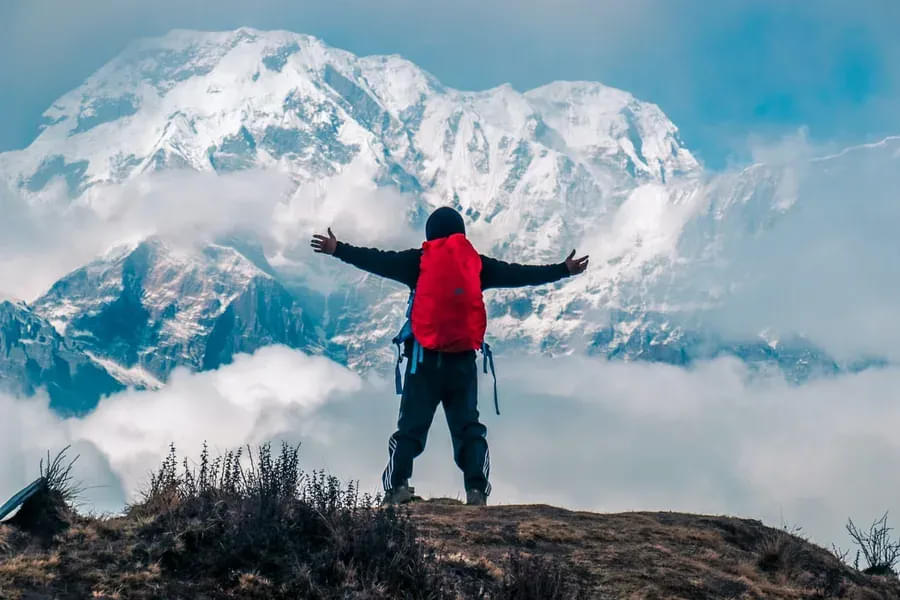
Quick Facts of Kedarnath Trek
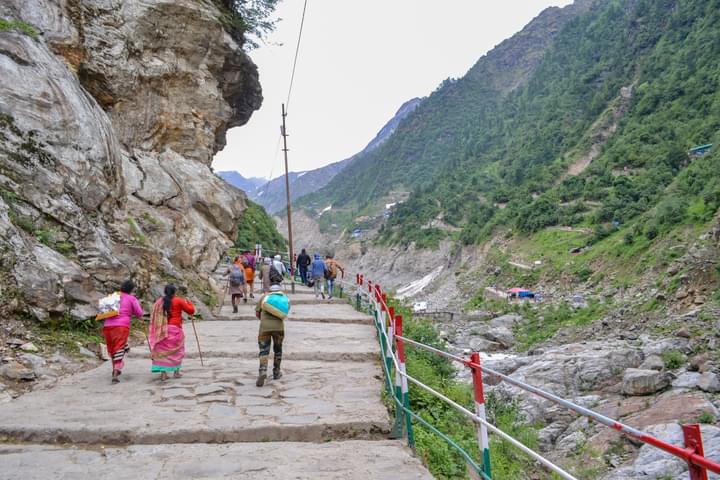
Kedarnath Trek Maximum Altitude: 3583 m
Grade: Moderate
Kedarnath Trek Duration: From Gaurikund to Kedarnath: 7 to 8 hours
Trekking distance: From Gaurikund to Kedarnath: 16 km
Trail type: Medium to steep
Railhead: Nearest Railway station is Rishikesh Railway station, 221 km from Kedarnath
Airport: Jolly Grant Airport, near Dehradun, about 239 km from Kedarnath.
Snow Season: November to April
Service from: Delhi
Base camp: Gaurikund
Best season: Summer (April to June)
Region: Garhwal Himalayan range near the Mandakini river, in the state of Uttarakhand, India.
Who can participate: Anyone who is physically fit can participate as there is no prior experience that is required for this trek.
Short Itinerary for Kedarnath Trek
Day 1: Arrival in Delhi
Day 2: Travel from Delhi to Haridwar (By Train - 217.6 km)
Day 3: Drive from Haridwar to Guptkashi (Altitude 1,319 m) (By Road - 203.5 km)
Day 4: Travel from Guptkashi (Altitude 1,319 m) to Gaurikund (Altitude 1982 m) and then Trek to Kedarnath (Altitude 3583 m) (By Road - 15.3 km & Trek - 14 km)
Day 5: Trek to Vasukital( Altitude 4,135 m) (Trek - 8 km) and Back to Kedarnath(Altitude 3583 m) (Trek - 8 km)
Day 6: Trek to Gaurikund (Altitude 3583 m) (Trek - 14 km) - Drive to Rudraprayag (Altitude 690 m) (Drive - 41.2 km)
Day 7: Drive back to Rishikesh (By Road - 141.7 km)
Day 8: Travel back to Delhi
Kedarnath Trek Detailed Itinerary
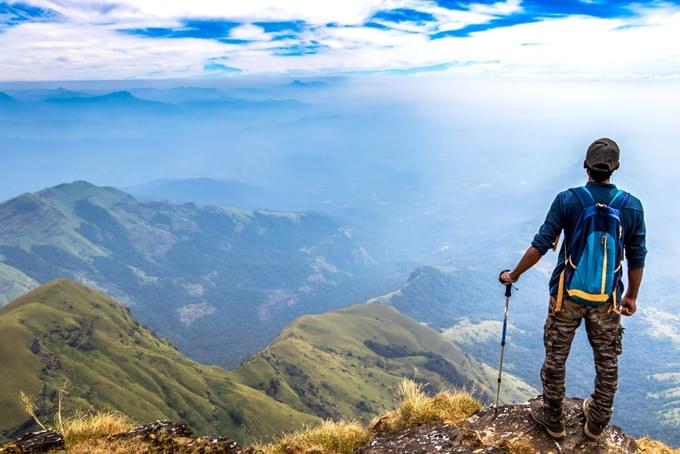
Arrival in Delhi
Your Kedarnath trek will start as soon as you arrive at Indira Gandhi International Airport in Delhi.
You will be transferred to your hotel in a spacious and comfortable vehicle.
Check in for the night and take a rest in the hotel after enjoying a delicious dinner.
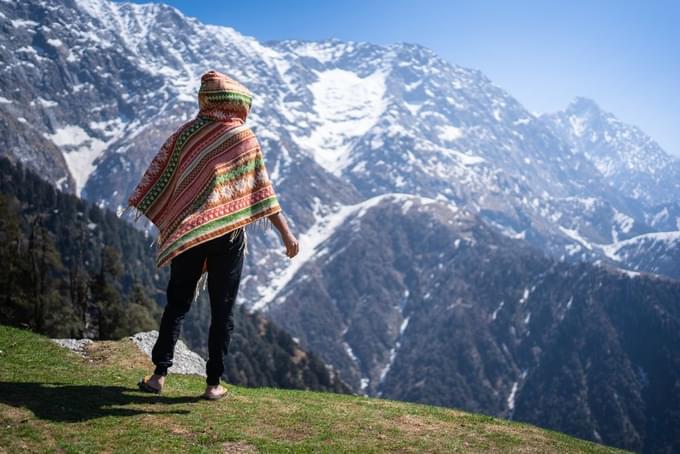
Travel from Delhi to Haridwar by train
Distance: 217.6 km
Duration: 6 hours and 20 minutes
On the second day of your Kedarnath trekking trip, you will need to wake up early in the morning and check out of your Delhi hotel after having a sumptuous breakfast.
You will be taken to the railway station in a comfortable vehicle and board the train for Haridwar.
Enjoy the journey to Haridwar for 6.5 hours and arrive at the Haridwar railway station.
You will find yourself heading towards your place of accommodation in a spacious and comfortable car.
Spend the evening exploring the local attractions of the town at a leisure pace on your own.
Return to the hotel to have a delicious dinner in the night.
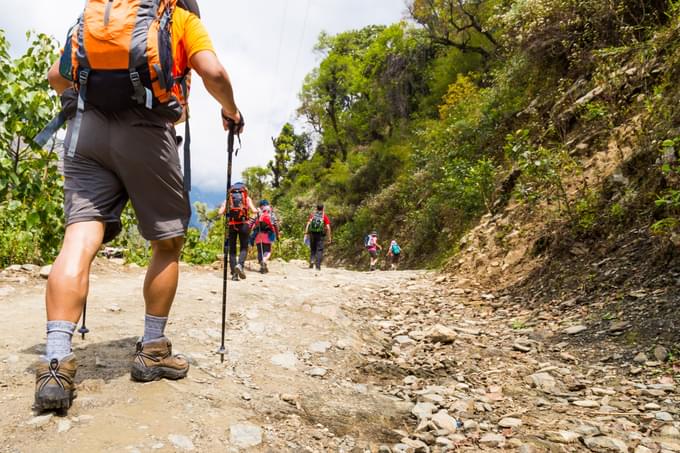
Drive from Haridwar to Guptkashi
Altitude: 1,319 m
Distance: 203.5 km
Start your day 3 with a hearty breakfast and then check out of your Haridwar hotel.
You will be proceeding towards Guptkashi by road. You will be traveling 203.5 km via National Highway 7.
Reach Guptkashi after 6 hours and 20 minutes and check-in your hotel.
Freshen up, spend some time exploring the city and then enjoy a scrumptious dinner, and rest overnight at your hotel.
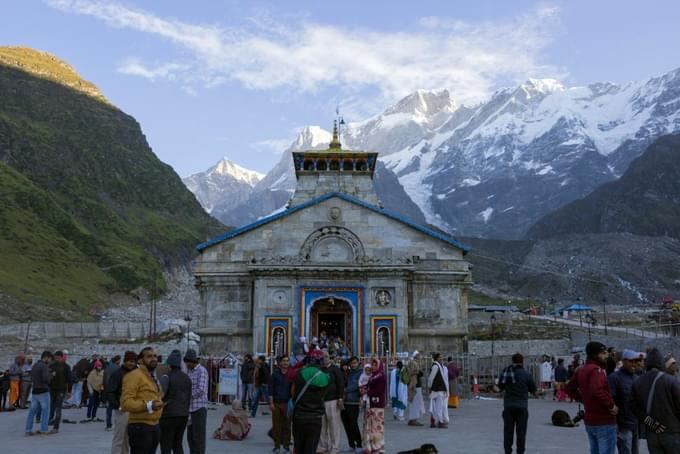
Travel from Guptkashi (Altitude 1,319 m) to Gaurikund (Altitude 1982 m) and then Trek to Kedarnath (Altitude 3583 m)
Altitude: 1,319 m to 1982 m to 3583 m
Distance: By Road - 15.3 km & Trek - 14 km
Duration: By Road - 1 hr 12 min & Trek - 6 hours
Start your morning with a delicious breakfast and feel energized to start the most important day of your trekking tour when you will finally trek to Kedarnath dham.
Check out of your hotel and proceed on your journey to the base camp of the Kedarnath trek, Gaurikund from where you will proceed to Kedarnath temple located at an altitude of 3583 m.
Ensure you start on time to reach there on time as trekkers are only allowed between 4:00 AM to 1:30 PM.
The Kedarnath trek distance is 16 km and will take you 5 to 6 hours to reach.
Carry your packed lunch and start your trek.
Your 1st stop will be Jungle Chatti at 4 km from Gaurikund which you will reach after trekking through the Rambara Bridge.
Take a break to enjoy the stunning view before you continue for another 3 km to reach Bheembali.
Your scenic journey to Bheembali will include a magnificent view of snow-covered mountains and temple walls.
Continue on Kedarnath trekking for 4 km more to reach Linchauli and take a break and enjoy the stunning mountain view.
Next, proceed towards Kedarnath base camp which is at a distance of 4 km from Linchauli and located at an altitude of 3583 m.
From this location, you will be able to watch the panoramic view of the valley, where you can enjoy the tranquil ambience of the place and explore the lush surroundings.
Reach Kedarnath and stay overnight at the hotel after a mouthwatering dinner.
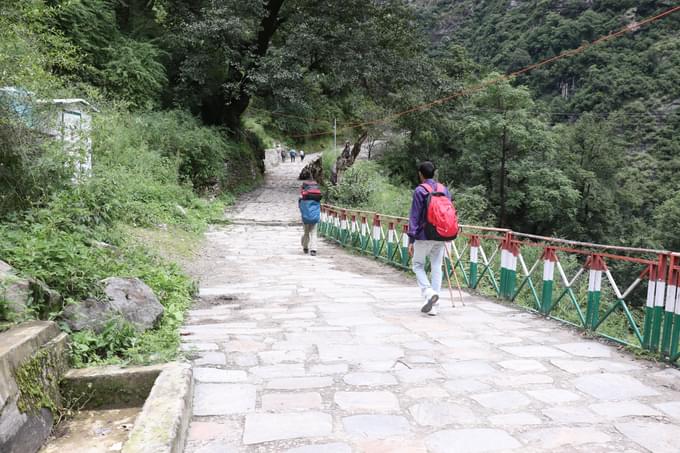
Trek to Vasukital( Altitude 4,135 m) (Trek - 8 km) and Back to Kedarnath(Altitude 3583 m) (Trek - 8 km)
Altitude: 3583 m to 4,135 m
Distance: 8 km
Duration: 5 -6 hours one way
Start your morning with the breathtaking view of the surrounding mountains and get ready for visiting one of the famous temples of India. Visit the temple to offer your prayers and receive Lord Kedarnath’s blessings.
Carry your packed lunch and start your picturesque trek to Vasuki Tal.
Reach Vasuki Tal and feel enchanted looking at the beauty of the pristine and explore the area to enjoy the natural splendors for a while.
Start your descent to Kedarnath in the evening and reach your hotel to enjoy a piping hot dinner and retire for the night.
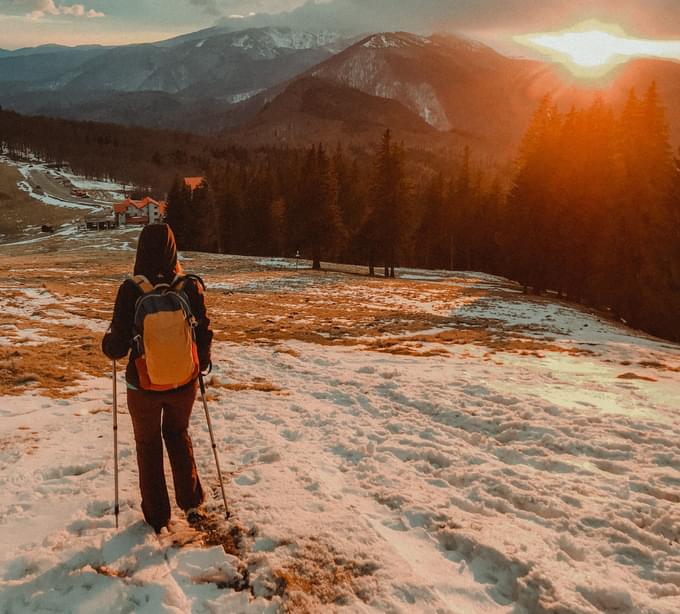
Trek to Gaurikund (Altitude 3583 m) (Trek - 14 km) - Drive to Rudraprayag (Altitude 690 m) (Drive - 41.2 km)
Altitude: 3583 m to 690 m
Distance: Trek - 14 km & By Road 41.2 km
Duration: Trek - 6 hours, Drive - 2 hr 46 min
Wake up to the scenic beauty and tranquil ambience of Kedarnath and enjoy a healthy breakfast at your hotel.
Start your descending trek to Gaurikund and carry a packed lunch with you.
Trekking for 6 hours to cover the distance of 14 kms down to reach Gaurikund.
Once you reach Gaurikund, you will start your journey to Rudrapayag by road. Reach Rudraprayag after travelling for 2 hr 46 minutes.
Reach your hotel, have a mouthwatering dinner and rest overnight.
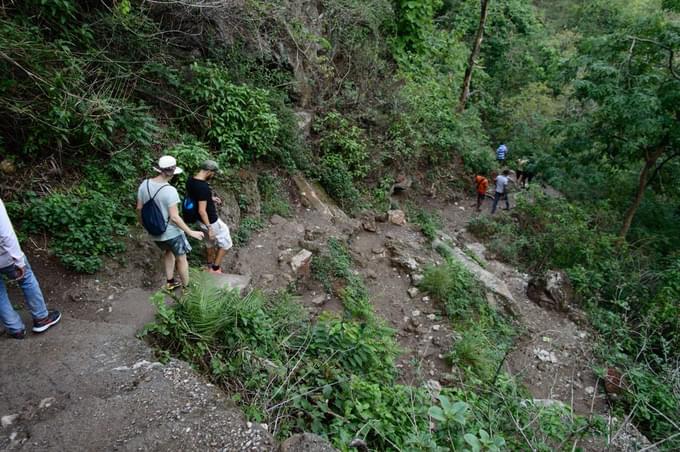
Drive back to Rishikesh (By Road - 141.7 km)
Distance: 141.7 km
Duration: 4 hr 10 min
Wake up in the morning and enjoy a flavourful breakfast at your hotel.Check out of your hotel and proceed on your journey to Rishikesh by road.
Reach the city of Rishikesh in about 4 hours and 10 minutes, travelling a distance of 141.7 km.
Reach Rishikesh, check-in your hotel and freshen up.
Enjoy a delicious hot dinner before you retire to rest overnight at your hotel.
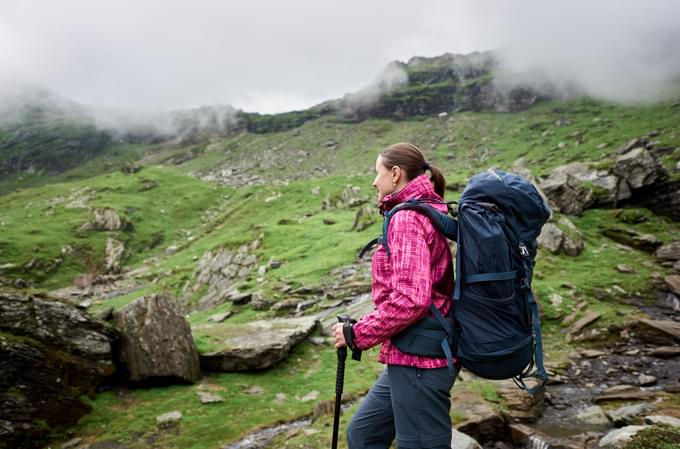
Travel back to Delhi
Distance: 268.1 km
Duration: 5 hr 7 min
Wake up on the last morning of your Kedarnath trek to the serene atmosphere of Rishikesh and enjoy a hearty breakfast at your hotel.
Check out of your hotel and proceed for a sightseeing tour of the Yoga Capital of India.
Complete sightseeing by evening and proceed towards the Haridwar railway station in a comfortable and spacious vehicle and leave for Delhi.
Your trekking trip comes to an end at Delhi railway station from where you will proceed on your onward journey back home with wonderful memories of the amazing places you have visited.
Things to Carry for Kedarnath Trek
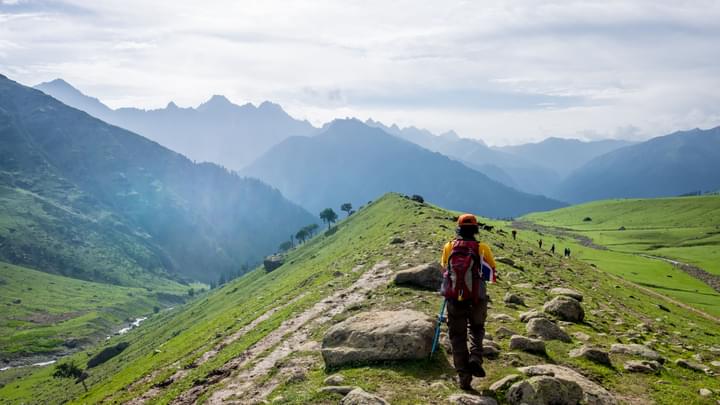
Mandatory Documents:
- Original as well as photocopy of any government photo identity card such as Driving License, Aadhar Card, Voters ID, etc.
- Passport and Visa need to be provided by International Travelers
- Medical Certificate (the first part needs to be filled by a registered Doctor and you will need to fill up the second part)
- Certificate of Declaration
- Trek Pants will be more comfortable during the trek than jeans or trousers.
- Jackets to protect you against chilly weather.
- Warm clothing such as fleece or woollen layers for nights.
- Thermals to keep you warm at night.
- T-shirts which are more comfortable than shirts and dry fast.
- Raincoat to keep you dry in case there is rain.
- Head cover such as a cap or balaclava to protect your head during the trek.
- Socks (woolen and regular)
- Do not carry too many clothes as you have to carry them during your trek.
Get yourself sturdy well-fitted trekking footwear so that your feet do not hurt during the trek.
Other Essentials:
- A strongly built 50 to 60 liters backpack with a good support is an absolute must for a trek. Ensure there is a rain cover as well.
- Personal toiletry items such as toothpaste, toothbrush, toilet paper, sanitiser etc. and must carry sunscreen to protect your skin.
- Personal medical kit with items such as prescribed medicines and common ones for altitude sickness, pain relief, headache, fever, stomach problem, motion sickness, allergies, diarrhea, etc. Also an antiseptic cream, a pain relief spray, bandage and cotton for cuts.
- Hiking pole for support during the trek.
- Water bottle to refill with water to hydrate yourself during the trek.
- Sunglasses for protecting the eyes.
- Woolen and waterproof gloves to protect your hands.
- Torch to use at night.
- Camera with rechargeable batteries to capture the scenic beauty.
Know Before You Go for Kedarnath Trek
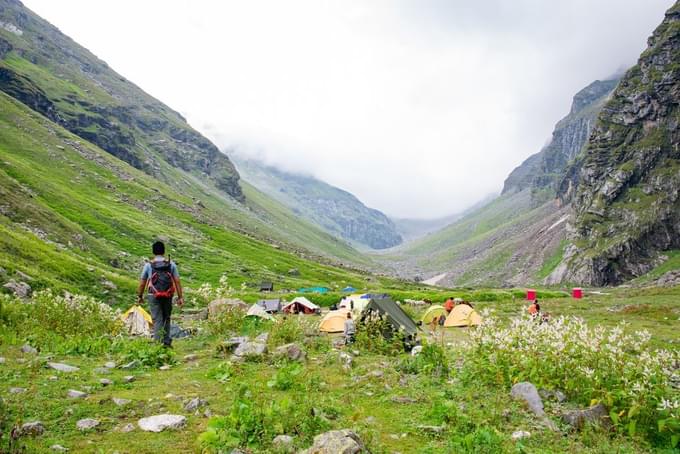
Get your medical checkup done to ensure fitness before you go on a trek.
People with heart, respiratory and blood pressure problems should not go trekking without a doctor’s advice. The trek is also not recommended for pregnant ladies.
You will need to abide by government rules and complete the trek within the stipulated time frame of 4 am to 1.30 pm.
Pay attention to your trek instructor and follow the traditional Kedarnath trek route.
If you are unable to complete the trek in a day, there are several places in between where accommodations are available.
Carry some light snacks such as dry fruits to keep you energized. You can also stop at the several food stalls and eateries on the way to get some food.
Wear clothes and shoes that are comfortable for trekking.
Carry a medical kit which may come in handy for sprains, cuts etc.
Be careful as you walk. Do not get distracted while walking, which might result in losing your foothold and spraining your legs.
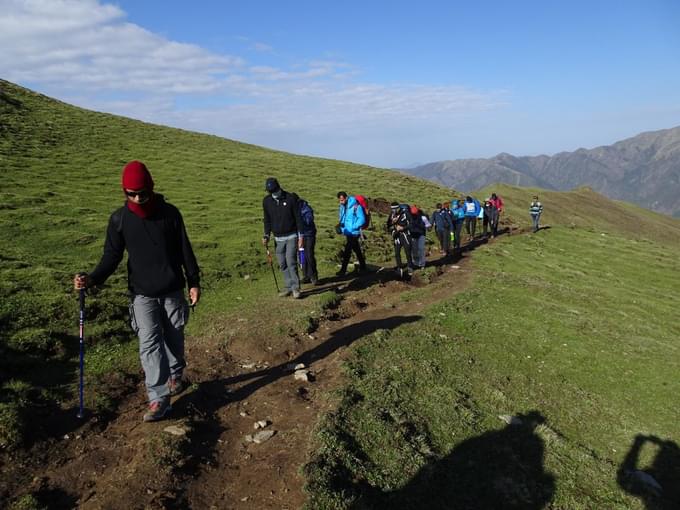
There is only one route which you will be taking when you go on your Kedarnath trek.
Base Camp: Gaurikund: You will be starting at the base camp at Gaurikund which is located 5 km from Sonprayag. Your vehicle will take you to Sonprayag and from there you have to travel by shuttle or jeep to reach Gaurikund.
First Stop: Jungle Chatti: Once you start from Gaurikund, you will need to trek through the Rambara Bridge for 4 km to reach Jungle Chatti.
Second Stop: Bheem Bali: The trek from Jungle Chatti to Bheem Bali is 3 kilometers and has a spectacular view of snow-capped mountains and temple walls. There are accommodations available here for those who want to take a break or stay the night.
Third Stop: Linchauli: Next is the 4 km trek from Bheem Bali to Linchauli. The trail has a stunning mountain view for you to enjoy. Linchauli also has accommodations for those who wish to stop and stay the night.
Fourth Stop: Kedarnath Base Camp: You will need to travel for 4 km from Linchauli to reach the base camp. You can opt to stop here for the night or proceed to reach the temple.
Final Destination: Kedarnath Temple: You will only need to travel for 1 km to reach the Kedarnath Temple, your final destination.
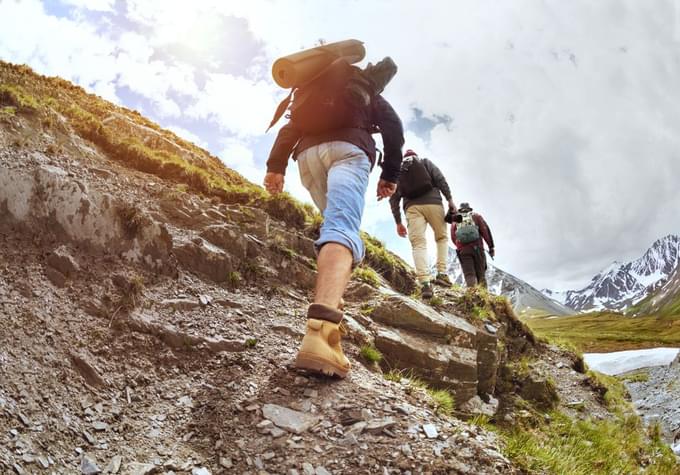
Summer (April to June): During this time, the weather is comparatively warm and there is no rain and snowfall. You will be able to enjoy trekking during these months as the temperature will be mild. Also, the weather is ideal for visiting the temple, sightseeing and indulging in activities. The temperature is around 17 degrees during these months.
Autumn (September to October): The weather during these months is favourable, making it ideal for trekking. You will be able to enjoy the scenic beauty of the surroundings with the clear sky while travelling during these months.
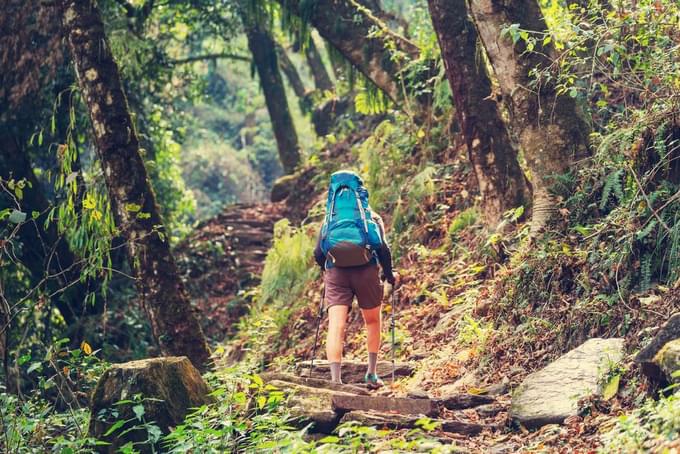
By Air: Rishikesh does not have an airport of its own but you can fly to its nearest airport, Jolly Grant Airport in Dehradun. The airport received daily flights from several major cities in India. You will need to travel for 35 km to reach Rishikesh from Dehradun. You can opt for a taxi or go for bus services available from Dehradun. The other alternative is to reach Delhi by flight and take a bus to reach Rishikesh.
By Road: Rishikesh is well connected with several cities and states by road by National Highway 58. You can get buses from Delhi, Haridwar, Dehradun and other places and reach one of the two bus stands of Rishikesh - the Main Bus Stand and the Yatra Bus Stand. Alternatively, you can also take a rented vehicle and travel by road. If you are traveling from Delhi, you can reach in 6 to 7 hours via Modinagar and Roorkee. Those traveling from Dehradun can also opt for a shared jeep.
By Train: Rishikesh has its own railway station but only few trains which run on a daily basis. Hence, it might be better to travel by train to Haridwar which is well connected with major cities of India. Once you reach Haridwar, you will need to travel for 25 km to reach Rishikesh by a bus or a taxi.
General Trivia About Kedarnath
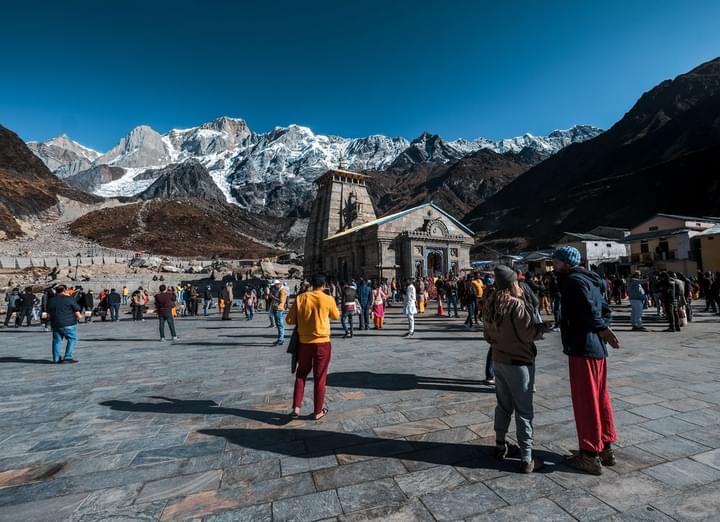
Kedarnath in local dialect means ‘lord of fields’, named after Kedar, the deity who is an incarnation of Lord Shiva who is considered to be the embodiment of all passions - love, fear, hatred, death and mysticism, expressed through his various forms.
Legend has it that Lord Shiva hid in a form of bull to avoid the Pandavas. One of the Pandavas, Bhima recognised him and tried to capture the bull from behind. But before Bhima could catch the bull, it disappeared, and later the hump of the bull appeared in Kedarnath and is worshiped since then.
Why to Go for Kedarnath Trek?
Going for the Kedarnath trek is one of the most popular and scenic treks in India, where you find beauty, peace, and amazing memories. It is a highly celebrated pilgrimage site and is one of the Chota Char Dham or Char Dham of Uttarakhand. The temple is located at an astonishing height of 3583 m and is very near to Chorabari Glacier, the birthplace of the Mandakini River. The whole area is covered with snow-capped mountains and is spectacular to look at. Once you start your journey from Rishikesh, you will be mesmerized by the stunning scenic view, first of the Ganges flowing along with you and then by the beauty of the famous Kedarnath Mountain. The trail is not too difficult, hence if you enjoy a good health condition, you can go for this trek, even if you are a novice.
FAQs of Kedarnath Trek
How difficult is the kedarnath trek.
Being at an elevation of 3583 m, Kedarnath trek may prove to be a moderate-level trek, which is strenuous for those trekkers who are beginners. Hence, it is strongly advised that they go for a medical fitness test to ensure that they are physically fit. They should also learn about altitude sickness and inform their trekking guides as soon as any symptom is noticed. People with heart, respiratory and blood pressure problems should not go trekking without a doctor’s advice. The trek is also not recommended for pregnant ladies. Those who feel that they will not be able to continue the trek for 5-6 hours may take a break at Bheembali or Linchauli and stay overnight and continue the journey the next day.
Is the Kedarnath trek safe?
Yes, the Kedarnath trek is very safe and reliable, in spite of being located at a high altitude. The government has taken initiative to build new trails and better safety protocols to ensure safety for all trekkers.
Can the Kedarnath trek be completed in one day?
Yes, it is possible to complete the trekking in one day. The trekking trail from Gaurikund to Kedarnath camp is 16 km and it takes 5 to 6 hours to reach there. If you start early in the day, it is possible to complete the trek in a single day. However, the Kedarnath trek is also adventurous and strenuous, so you will need to plan the trip as per your ability.
Can we do the Kedarnath trek at night?
No, as per Government norms, you can only do the Kedarnath Trek between 4 am till 1:30 pm. This timing has been set keeping in mind the safety of the travelers. So if you start late and cannot complete the trek by 1:30, you can make a stopover at Jungle Chatti, Bheem Bali or Linchauli and start your journey the next morning.
What clothing should I wear for the Kedarnath trek?
It is preferable to wear clothes which are comfortable. The best is to wear trek pants, t-shirts and a jacket. You must carry woolens as it will be chilly once you reach the top. Wear a head cover such as a cap to cover your head. Wear a sunglass for eye protection and wear sturdy well-fitted trekking footwear so that your feet do not hurt during the trek.
Where should I stay while trekking in Kedarnath?
There are several hotels and guest houses at Sonprayag as well as Gaurikund where you can stay before or after your trek. Guest Houses and cottages are also available at Kedarnath Base Camp for you to stay in once you reach the final destination. You can also stay at guest houses and dormitories near the temple as well. If you need to stop during your journey from Gaurikund to Kedarnath Base Camp, you can stay at accommodations available at Jungle Chatti, Bheem Bali or Linchauli.
What are the common mistakes that you need to avoid while trekking?
Do not carry too much weight.
Do not hike too fast or slow.
Do not wear clothes which can make you uncomfortable.
Do not go on the trek without consulting a doctor to ensure fitness.
Do I need to register with the Uttarakhand Government before going for the Kedarnath trek?
Yes, you will need to register with the Uttarakhand Government before going for the Kedarnath trek. You can either register online beforehand or register at Sonprayag before your trek.
Treks in Himachal
Treks in uttarakhand, weekend treks in india, treks in ladakh & kashmir, treks in nepal, treks in sikkim.
.png?w=auto&h=400)
The content and images used on this site are copyright protected and copyrights vests with the respective owners.
© 2024 www.heyhimalayas.com All rights reserved.

Kedarnath Trek and Yatra – Where, What & How? All the information you need
Treks & hikes , Uttarakhand
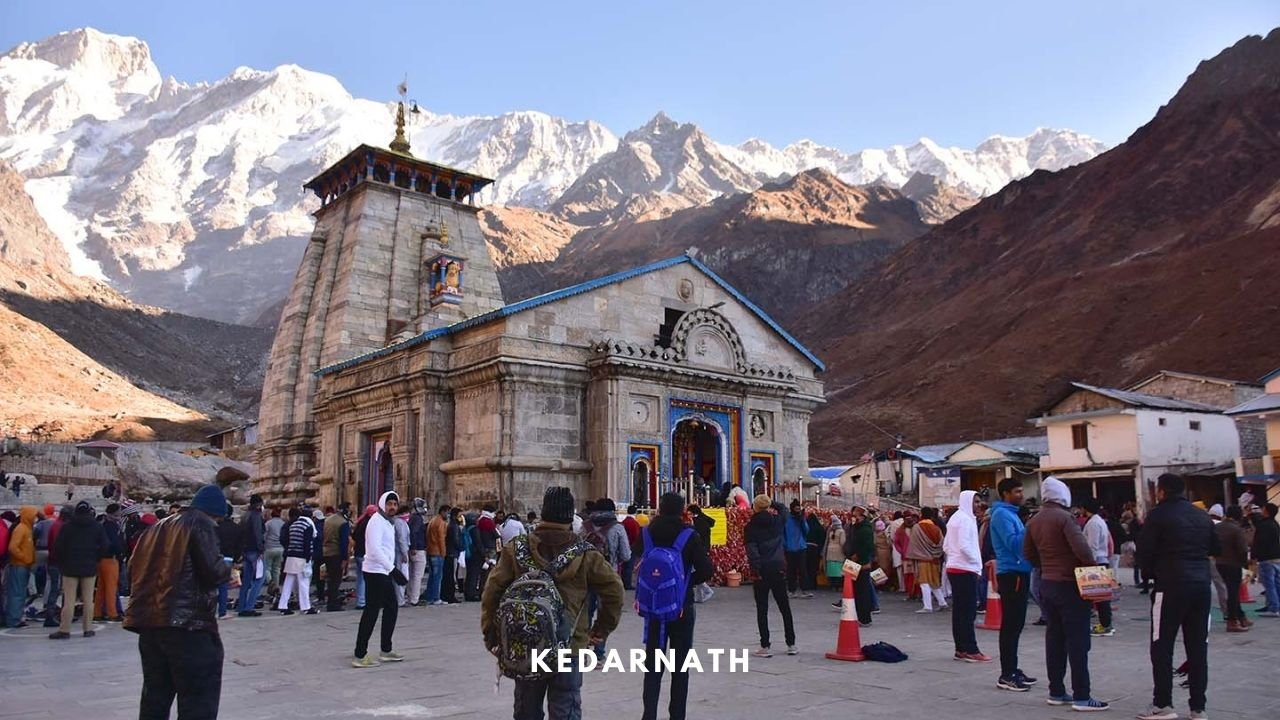
Last Updated on: May 20, 2023
About this Blog: Kedarnath Yatra is one of the most spiritual pilgrimages in India. Kedarnath, the abode of Lord Shiva attracts thousands of devotees within a span of 6 months when the shrine remains open. Kedarnath is a part of the sacred Char Dhams (4 pilgrimages) as well as a part of the Panch Kedars . This blog is about our experience of the Kedarnath Trek done in the month of October. Read on to know more about Kedarnath Yatra, how to reach and where to stay and other related information.
Kedarnath is not just a place of pilgrimage for me. The place has much more significance. It was the first place that I had ever travelled with my family. I do hear every now and then that I had been a very difficult 2-year-old during that time who gave a tough time to my parents. Well, what else to expect from a toddler! Now after almost three decades, I was again ready for Kedarnath Yatra again with Agni in tow. Only this time, we decided to go on foot from Gaurikund and I was quite excited about the Kedarnath trek.
This trip was going to be a special one, not for a singular reason. To be honest, I was way too excited to visit a place that has such nostalgic memories for me. The moment we told our families about this trip, my father started telling me stories about “that” Kedarnath Yatra that happened almost 30 years ago. By stories, he meant all the embarrassing episodes of a two and a half-year-old on a trip with the family. It seemed he divulged all my idiotic secrets to my husband, who of course, did not forget to tease me later.
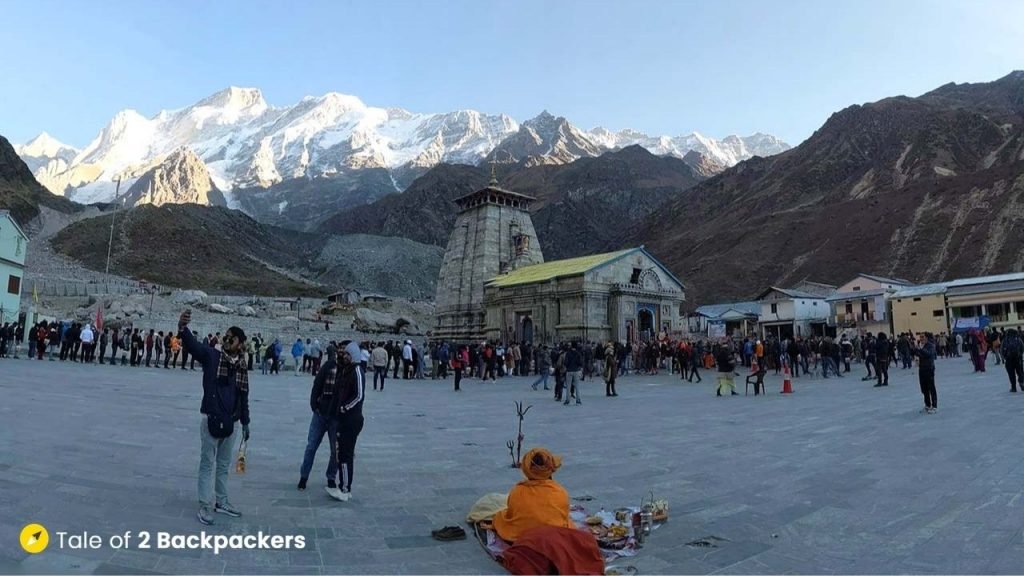
My uncle was quite excited to know we were visiting Kedarnath and Badrinath. He recalled all the special places and even told me to take pictures in the same pose as we had done previously. So much for changes! Overall, going to Kedarnath was exciting not only for us, but also for my family.
For Agni and me, Kedarnath trek was important because we were again trekking the Himalayan trails after almost 2 years. All these years, we had done a few short treks in the Western Ghats and the David Scott Trail in Meghalaya. We thought Kedarnath trek might be the catalyst that would overcome the drought in our trekking trips. After all, it was after Amarnath Yatra that we had fallen for trekking! So enough of my ramblings, let us start with all the information you wanted to know about Kedarnath Yatra, Kedarnath Temple and of course our amazing experience there.
Where is Kedarnath located?
Kedarnath Dham is a part of the Char Dhams Yatra (4 religious places) that also includes Gangotri, Yamunotri and Badrinath. Located in the Rudraprayag district of Garhwal region in Uttarakhand, the Kedarnath temple is located in the Kedar valley below the Chorabari glacier, which is the source of the river Mandakini.
Kedarnath – History, Legend and Stories
It is usually an obsession with me to find out about the past of any place that we visit, especially if the place happens to be a historical and religious place. For temples in India have numerous stories hidden in them. I did the same for Kedarnath.
It is believed that the Kedarnath shrine was buried under the snow for almost 400 years!
Like others, Kedarnath also has its fair share of mythologies and legends. There are various versions on the origin of the Kedarnath Temple. While there are claims that the temple was resurrected and built by the great Hindu seer Adi Shankaracharya in the 8th century while others claim that it was built by the Hindu King Raja Bhoj of Malwa in the 2nd century AD. Well, as I said before, there are numerous versions.
Kedarnath finds mention in the great Hindu epic Mahabharata and this is where the legend of Panch kedar comes in. Did I mention before that Kedarnath is also one of the five (Panch) Kedars, the five holy places of Lord Shiva.
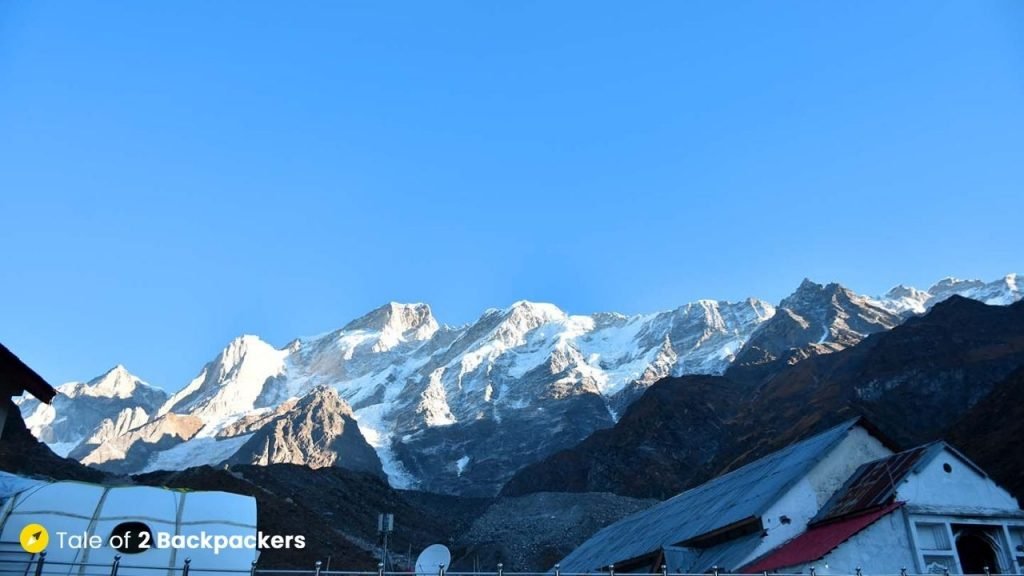
In the epic battle of Kurukshetra where the brothers fought against each other, the Pandavas defeated and killed their cousin brothers Kauravas. The Pandavas killed their own in the battle and were inflicted by self-remorse and guilt. They decided to ask for forgiveness from Lord Shiva, the master of the Universe. With this thought in mind, the Pandavas decided to go to Kashi to ask for forgiveness from God. Lord Shiva, on the other hand, was not too keen on forgiving the Pandavas for their carnage. He left his abode at Kashi and hid as a bull at Guptkashi. Bhima, the strongest of the Pandavas, however, was able to find Lord Shiva in the form of a bull. The bull again escaped and later rematerialized at five places and these 5 places came to be known as the Panch (five) Kedars.
Different parts of the bull materialized at different locations – the hump at Kedarnath, the arms at Tungnath , the navel and stomach at Madmaheshwar, the face at Rudranath and the hairs at Kalpeshwar. It is believed that the Pandavas had built temples at all the five locations and were freed of their sins. It is also believed that the front portion of the bull fell at Pashupatinath in Nepal. The Pandavas built temples at all five locations. It is believed that the Pandavas performed Yagna at Kedarnath before they left for Mahaprasthana (renouncing the world to attain salvation). Incidentally, the Mahaprasthana started from Mana village near Badrinath. That story is for some other time.
There is another story where Nara-Narayan, a Hindu deity worshipped Lord Shiva and Goddess Parvati. He prayed to the Lord and asked him to stay at Kedarnath for the wellbeing of the human beings. Lord Shiva granted him his request and thus Kedarnath became the abode of Lord Shiva.
The Floods of 2013
Kedarnath is also now known for the devastating floods that occurred in the Garhwal region of Uttarakhand in 2013. Surprisingly the Kedarnath Temple was one of the few structures that remained unscathed during the floods.
If the mythology is to be believed, then the temple was perhaps built almost 3000 years ago. However, there are inscriptions of the wall of the temple that dates towards a period in between 650 – 850 AD. How the temple withstood the ravages of the flood has been an area of interest for researchers. The reason is apparently related to the glaciers of the region and the lichens grown there.
Ravinder Kumar Chaujar, a retired professor from Wadia Institute of Himalayan Geology, Dehradun, studied lichens growing on the rocks of Chorabari’s moraines to determine the geological history of the place. Professor Chaujar found that the temple had remained submerged in ice or in the glacier for at least 400 years. This was perhaps one of the reasons for the resilience of the temple. It remained unharmed in the 2013 floods and will perhaps survive further such episodes of flooding.
Kedarnath Trek – Our Experience
As I have mentioned before that we decided to go on foot all the way to Kedarnath from the base point at Gaurikund. The journey started from Haridwar. Local buses from Haridwar to Guptkashi were very few because of the post-pandemic situation. So we rented a car for 5 days for a trip to Kedarnath and Badrinath.
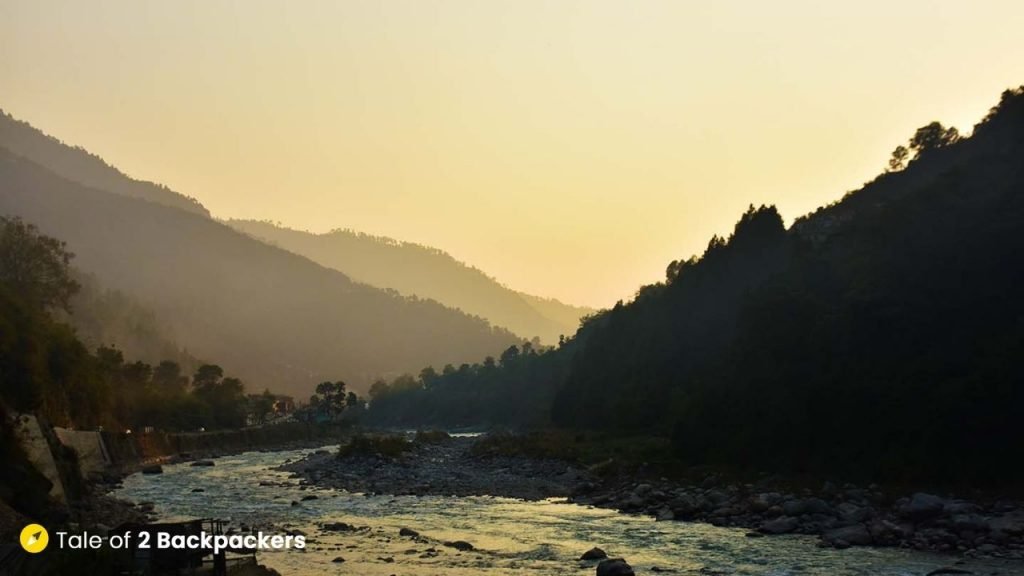
We started early in the morning from Kedarnath and passed through the winding mountain roads. We had been to these parts a few times, but the scenery never failed to enchant me. The meeting of Mandakini and Alaknanda Rivers at Rudraprayag still makes us wistful of the unadulterated beauty of the mountain rivers.
The Mandakini River was our constant companion throughout the road to Kedarnath. We reached Guptkashi at around 3 PM and then decided to travel to Sonprayag. There are a number of hotels at Guptkashi and is one of the places to stay for the night if you reach late.
We reached Sonprayag soon and found a hotel to stay for the night. We found a number of hotels at Sonprayag well but the majority of them were closed. It seemed this season the number of pilgrims were lesser than previous years, the reason being obvious.
Earlier, Sonprayag was the starting point of Kedarnath Yatra. But now, a motorable road upto Gaurikund has been built and the 5 km distance from Sonprayag to Gaurikund can be travelled by a shared jeep.
We started quite early in the morning. Once we were at Sonprayag, we headed towards the Yatra Registration Counter. To conduct the Chardham Yatra in a controlled manner after the flash floods of 2013, the number of Yatris (pilgrims) visiting the Kedarnath shrine is regulated. Yatra registration can be done online and you get an e-pass. You can do it yourself or ask your agent to do it for you. There is also a counter for getting the Yatra e-pass at Sonprayag. A man was sitting with a laptop and was making the Yatra e-pass for a fee of Rs.50/-.
We had our Yatra e-pass with us and went to the Registration Counter directly. They recorded the e-pass number, did thermal screening and we were given the permission to start our Yatra. Every year, the pilgrims get a physical pass as well. We did not get it this year, perhaps because of the lesser number of pilgrims.
Sonprayag – Gaurikund
As soon as we got ourselves registered for Kedarnath Yatra, we walked towards the jeeps standing for taking the yatris to Gaurikund. We got our seats in the jeep and were soon at Gaurikund. The jeep fare was Rs30 per head.
The Kedarnath trek route starts from Gaurikund and concludes at Kedarnath covering a distance of 16km. The trekking route had changed and rebuilt after the flash floods of 2013. The old trekking route has now given way to a better and wider trekking trail.
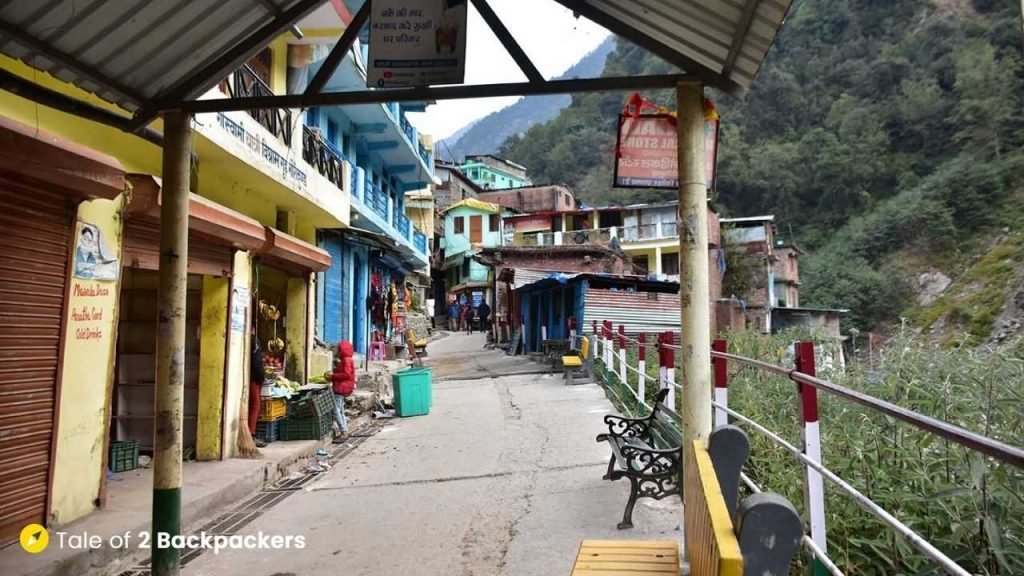
Kedarnath Trek Starts
The trek starts at Gaurikund. “Kund” literally means a reservoir and Gaurikund has a hot water spring where the pilgrims usually have a bath before embarking on the Yatra. The hot spring no longer exists after the floods of 2013. Now, there is a huge enclosure where pilgrims can take a bath.
Gaurikund is also known for the Gauri Temple dedicated to Goddess Parvati. Close to the Gauri Temple is the Uma Maheswar Temple where Lord Shiva is worshipped in the form of a rock.
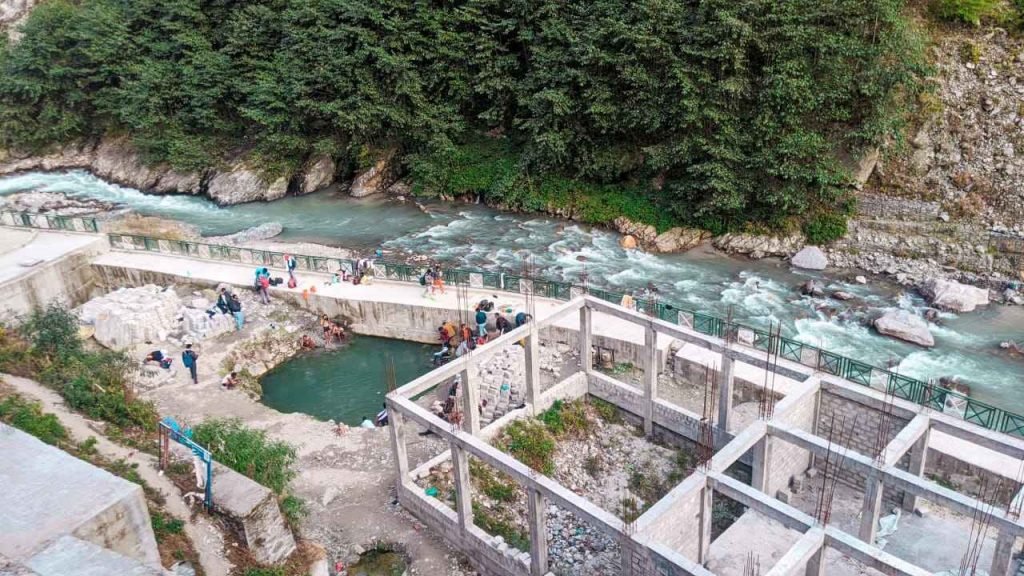
Gaurikund is congested and there are a number of shops catering to all the needs of the travellers. There are a number of accommodation facilities as well at Gaurikund.
We started from Gaurikund at around 8 AM. The Mandakini River was gushing down with beauty and spirit. As much as I wanted to stay there and admire the sprightly river, we had to start our trek towards Kedarnath Temple.
About half a kilometer from the starting gate, is a booking office for horses, mules and palkis and Pitthus . Pitthus are basically men carrying the pilgrims on their back. Usually very old and young pilgrims take the service of Pitthus . There is a fixed rate for mules and Pitthus . You can book them from here. However, you will find mules almost entirely through the trail.
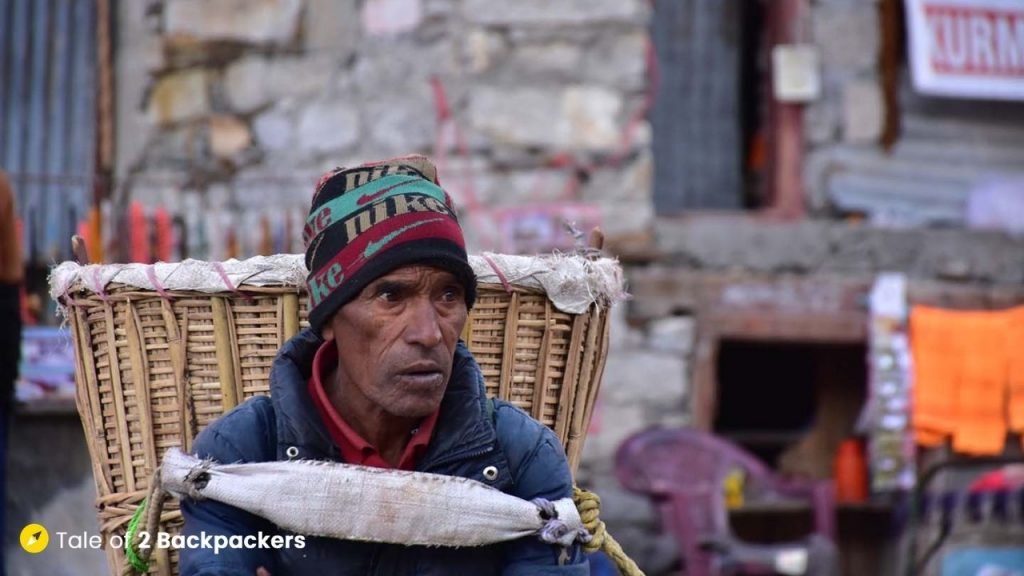
After a kilometer of trekking comes the Horse Point (Ghoda Pul) or the place from where you can get on your horses or mules to carry your journey. The horses are allowed from this point only. Upto this place, the trail is quite crowded with horses, mules and their owners. And don’t you forget, they will constantly ask you to get a mule for the journey! I had been told at least 15 times that I should take a horse to Kedarnath.
We trekked along the well-made trail. As usual, very soon we were quite tired and panting. Our legs were screaming for respite. Well, this is what happens if you are out of any fitness regime and had not trekked for almost a year! Nevertheless, we continued to trek. Though I must admit that there were a couple of moments when I felt that I should have hired a mule.

The next significant stop on the trail is the Bheembali. The trekking route bifurcates at Bheembali – one for the trekkers and the other specially designated for horses and mules. Both the trails finally meet after Rambara.
Rambara was once one of the biggest settlements in the Kedarnath trek route. The floods of 2013 had completely wiped off the settlement. What remains now is the debris of the old trekking route which was pointed to us by a local shopkeeper. It is also here that we see the Mandakini River flowing down with force through the gorges.
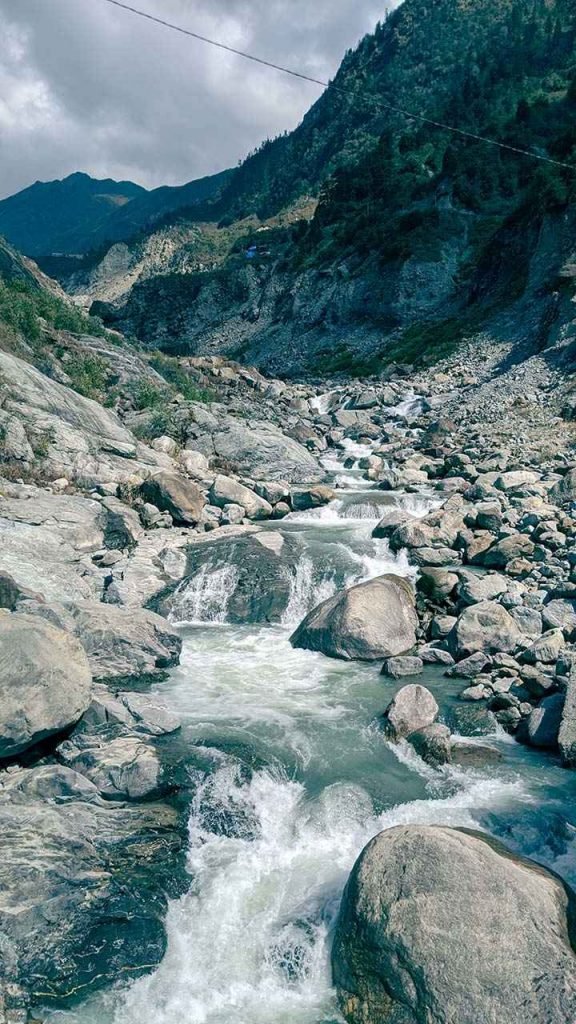
The older route to Kedarnath was through the left of Mandakini River and that route is now completely destroyed. The new route has now been constructed at the right side of the river. A few more minutes of trekking and we reached Chhoti Lincholi. It was almost 12.30 PM at that time and we decided to take a lunch break there. This place can be roughly said to be the midpoint of the trail.
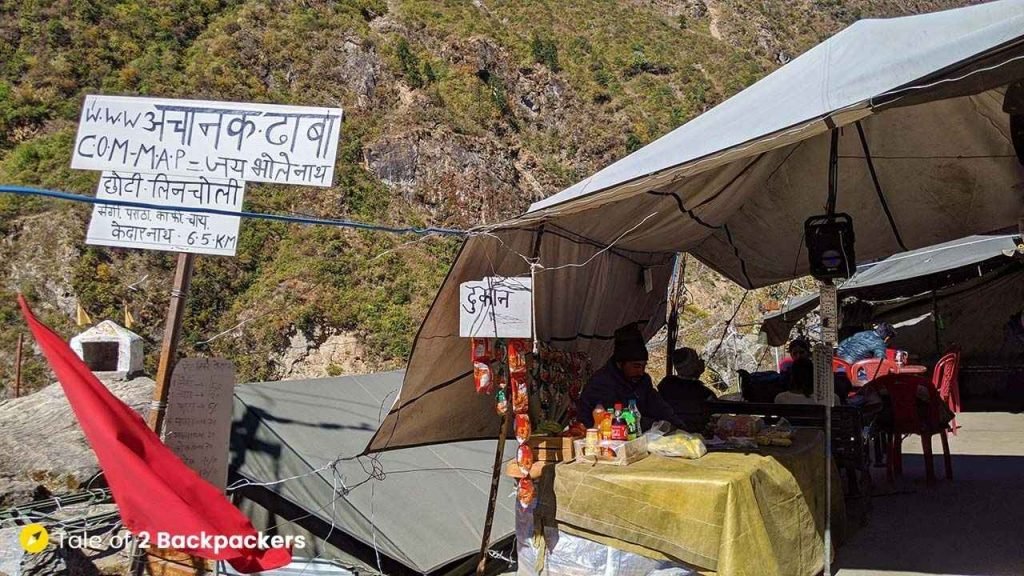
We had a good lunch of alu paratha at Chhoti Lincholi and were quite ready for our next stretch of the trek. And it was then, something sort of a miracle happened. It started snowing! Well, not exactly all the big snowfall, but we could see the snowflakes on the tents and on us.
To be honest, it was a bright and sunny day when we started. The snowfall made all the people quite happy and a group started singing a local song. We were told that it was the second snow of the season and all the locals were quite happy to see the snow. We enjoyed the snowfall for almost half an hour after which it stopped.
The snowfall might have had us gushing like diehard romantics, but it definitely made the trail a bit difficult for us. We were already late for more than an hour and the weather became chilly. It was a lazy start after lunch and snowfall and gradually we trekked our way towards Kedarnath.
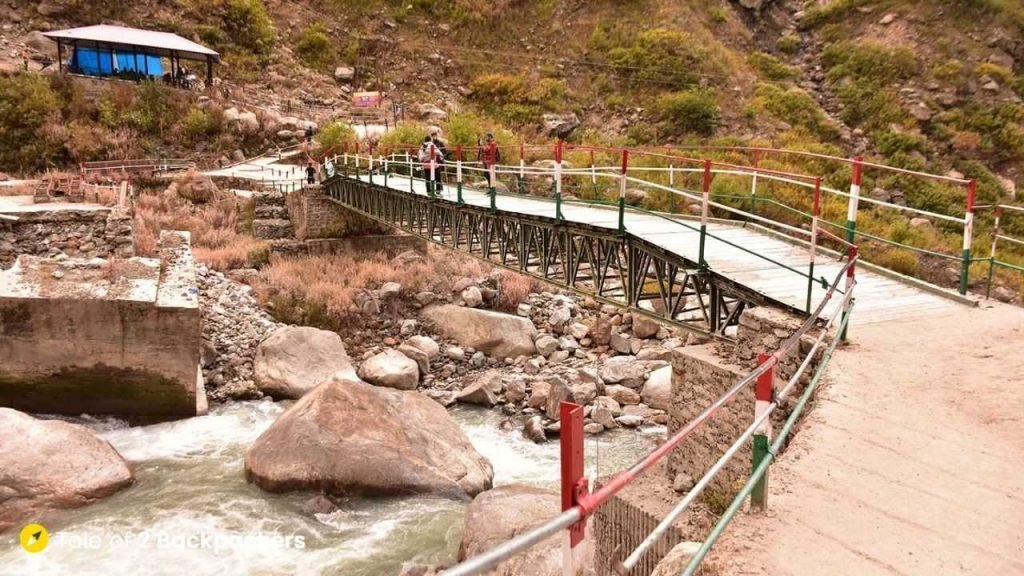
Finally, we reached Lincholi. There are a few accommodation options at Lincholi. You can stay here for the night. Kedarnath is about 6 km from Lincholi. As much as we were tempted to stop at Lincholi, we decided to trek all the way to Kedarnath. After trekking for another hour, we reached Kedarnath Base Camp.
There is a GMVN Guest house and cottages at Kedarnath base Camp. Kedarnath shrine is another 500 m from here. There is also a check post here where they check the registration slips. They only ask for the e-pass numbers and really do not check any slips. We trekked towards the shrine and finally we reached there at around 4PM. Once we reached Kedarnath, we tried to look for a place to stay. There are a number of places to stay near the shrine, mostly dormitories. We finally chose to stay at Bikaner House just behind the Kedarnath Temple.
We were quite in time for the evening Aarti at the Kedarnath Temple. The Aarti starts at 5.30 PM. After watching the Aarti, we went to our guest house, had our dinner and simply snuggled into our sleeping bags.
Kedarnath Temple – the end of the trek
We awoke early the next morning and went to visit the Kedarnath Temple. This time we saw the temple in all its glory. The main temple of the Kedarnath remained unscathed in the floods of 2013.
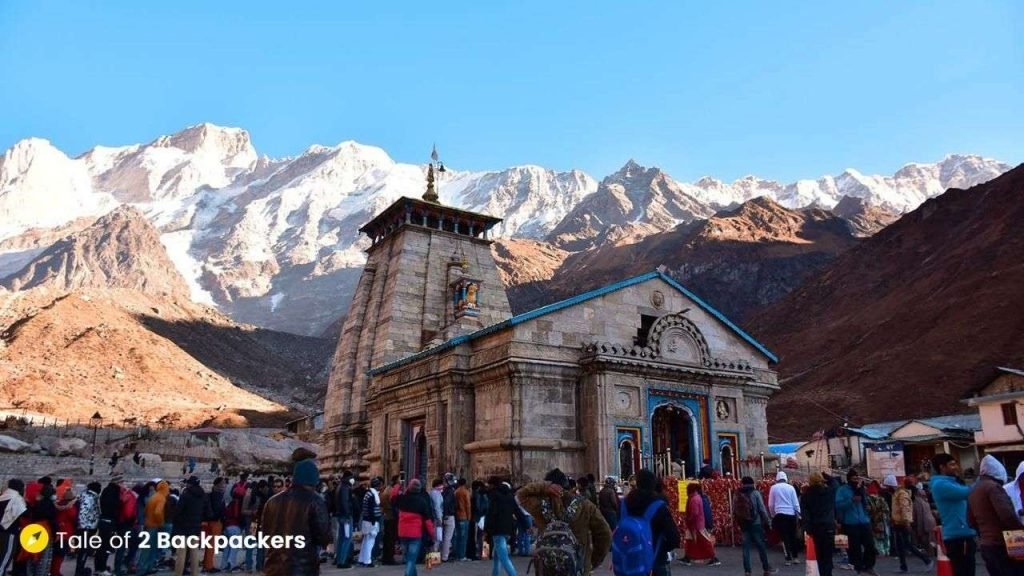
The interior of the temple is a bit dark. There are statues of the five Pandava brothers and Draupadi, their consort. Inside the main hall, there is a conical shaped stone that is said to be the hump of the bull that Lord Shiva transformed into (remember the story I mentioned before). There are statues of Lord Shiva and a few other deities inside the main hall as well.
We offered our prayers in the temple and then roamed around the place for some time. I had a few old pictures when I had visited Kedarnath Temple almost 3 decades back. I tried to connect the places with that of those pictures. Obviously, the place had changed, but the temple had remained intact.
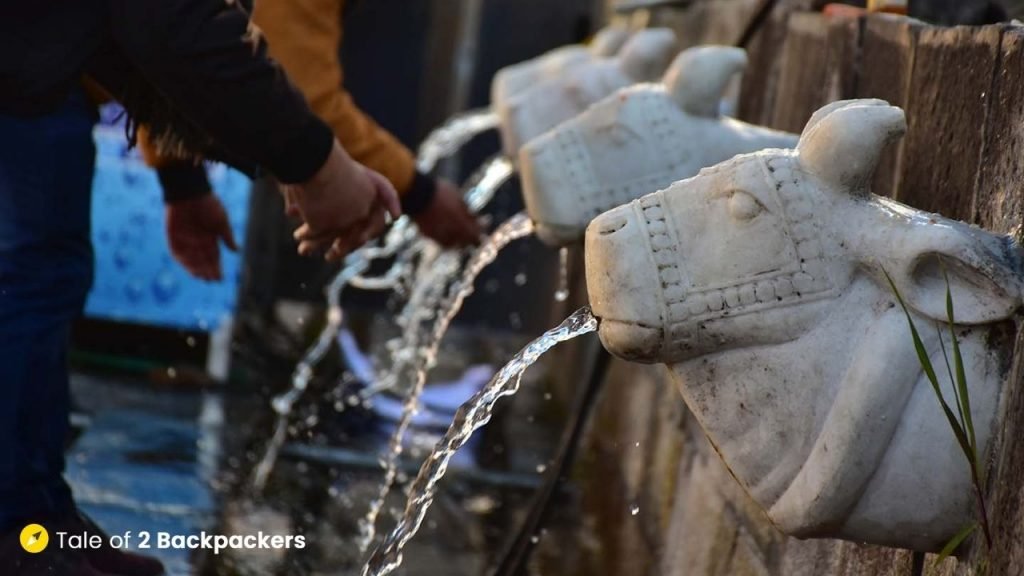
Outside the temple, there is a statue of Nandi, the bull facing the temple. The entire place looks quite beautiful with the snow-covered Kedarnath peak (6940 m or 22,769 ft), the Kedar Dome (6,831 m 22,411 ft) and other peaks surrounding the temple on three sides.
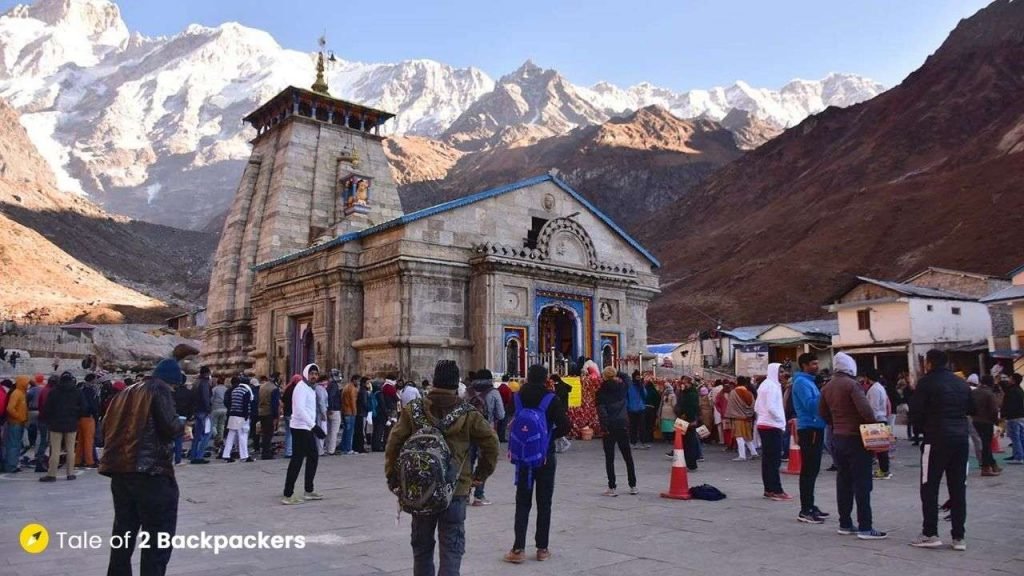
Just behind the temple is a huge rock known as the Shri Divya Bheem Shila. It is believed that this stone had protected the temple from the waters of the flood in 2013. When the waters of Gandhi Sarovar carried large chunks of moraines and stones, this huge stone boulder tumbled down and anchored just behind the temple. This rock then diverted the flow of water to the sides and the temple remained intact.
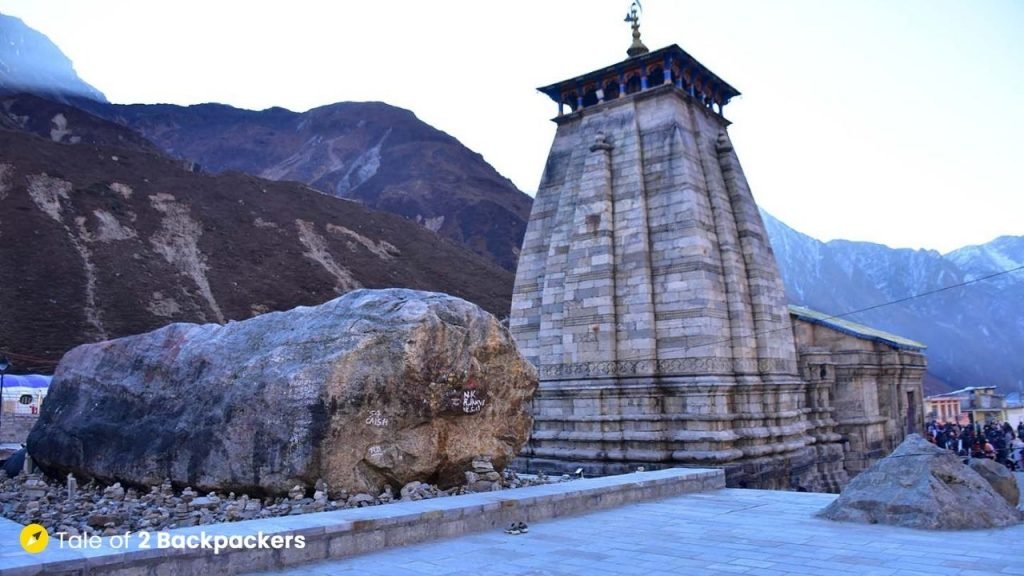
You will invariably feel calmness at this place. All around the temple, you will see many ash-smeared saints and sadhus sitting with a trident (Trishul). They seem to be in a world of their own. It is quite interesting to see these sadhus all around the temple, sometimes singing while at other times having a pot of marijuana.
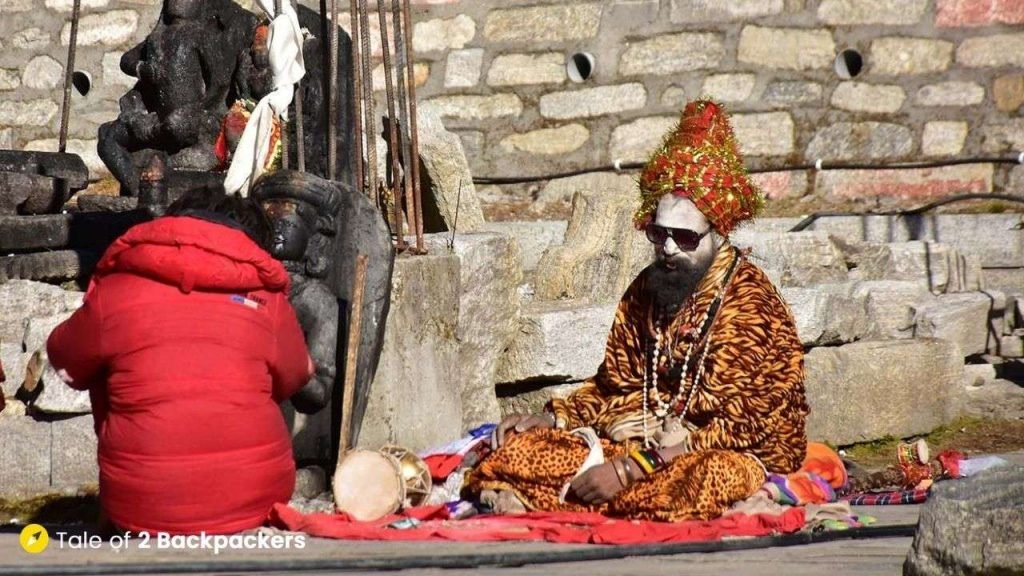
After spending some time around the Kedarnath Temple, we started our return journey towards Gaurikund at around 8.30 AM. We descended to Gaurikund after taking occasional breaks and reached there by 2 PM. Our car had been waiting for us at Gaurikund. We continued our journey towards Guptkashi and decided to stop there for the night before continuing our journey towards Badrinath. Our visit to Badrinath remains for the next story.
Kedarnath Temple Timings:
The temple remains open from 4 AM to 9 PM everyday.
All that you need to know about Kedarnath Trek and Yatra
How to Reach Kedarnath?
Jolly Grant Airport near Dehradun is the nearest airport and is located about 235 km from Kedarnath. Taxis are available from the airport to Sonprayag.
The nearest railway station to Kedarnath is Haridwar or Rishikesh. From Haridwar and rishikesh, you will get direct buses to Guptkashi and Sonprayag. But these buses are few in number. You can check online bus sites to see the time of the buses. Buses to Guptkashi, Karnaprayag, Gopeshwar are now available from Delhi (ISBT) as well.
You can also hire a car to reach Guptkashi or Sonprayag. However, it is better to book a car for both Kedarnath and Badrinath or the entire Char Dham Package. The cars charge a lot more if you only ask them to drop at Sonprayag.
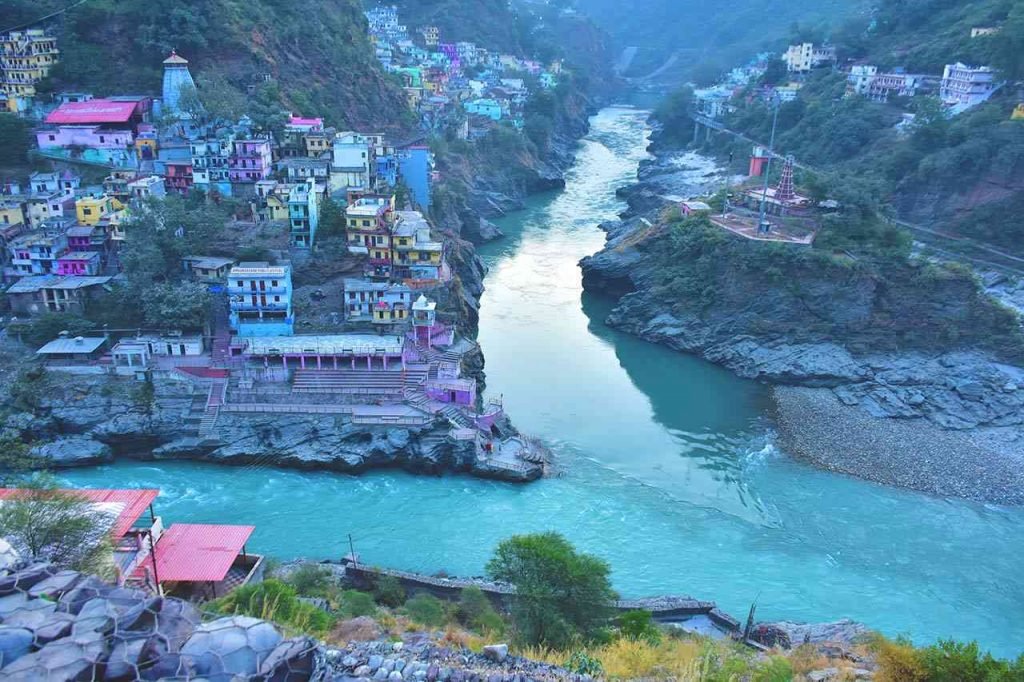
We had hired a car for 5 days to visit Kedarnath and Badrinath and it cost us about INR 11,000 for the 5 days (which I do consider to be cheap). We also stopped at Tungnath and Chopta on the way from Kedarnath to Badrinath.
If you are driving by your own car, you can follow the route:
Haridwar – Rishikesh – Pipalkoti – Devprayag – Srinagar – Rudraprayag – Agastamuni – Guptkashi – Phata – Sonprayag
Sonprayag has a huge parking space where you can keep your car for the night. The Registration centre for the yatra is just a few metres ahead of the parking space.
The distance between Sonprayag and Gaurikund is about 5 km. You can start the trek from Sonprayag or else take the shared jeeps to Gaurikund. The jeep fare is INR 30 per head. The stretch of road from Sonprayag to Gaurikund is quite bumpy and rough.
Gaurikund serves as the base camp for the Kedarnath trek.
From Gaurikund, you can either trek or ride horses/mules to Kedarnath.
Kedarnath on foot (Kedarnath Trek)
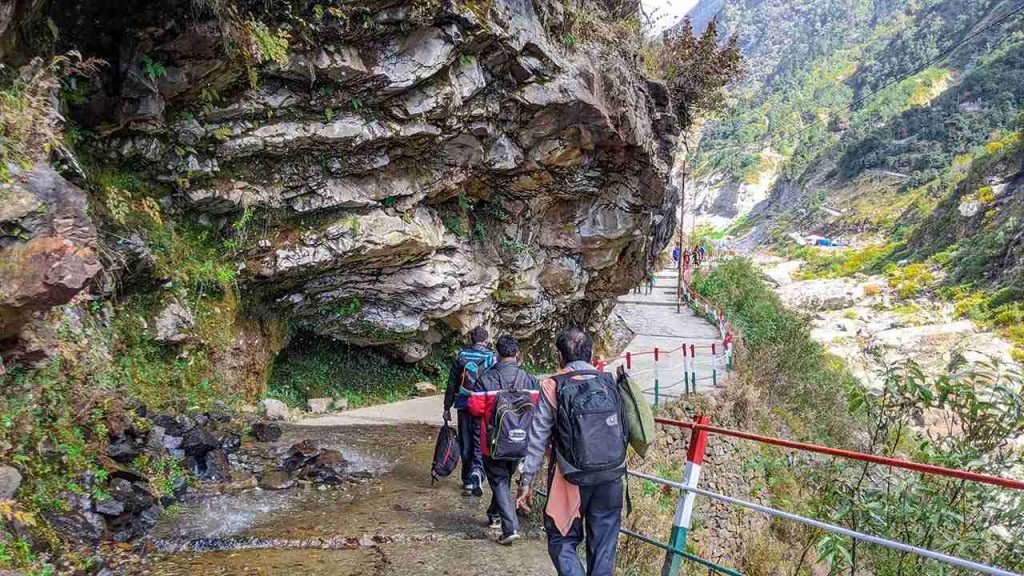
The total trekking distance from Gaurikund to Kedarnath Temple is about 16-17 km.
Kedarnath Trek Route
- Gaurikund – Jungle Chatti (4 km)
- Jungle Chatti – Bheembali (3 km)
- Bheembali – Lincholi (4 km)
- Lincholi – Kedarnath base camp (4 km)
- Kedarnath base camp – Kedarnath temple (1 km)
The entire trail can be covered in a single day on foot. There are a few accommodation facilities in the middle.
Kedarnath by Horses/ Mules and Pitthus
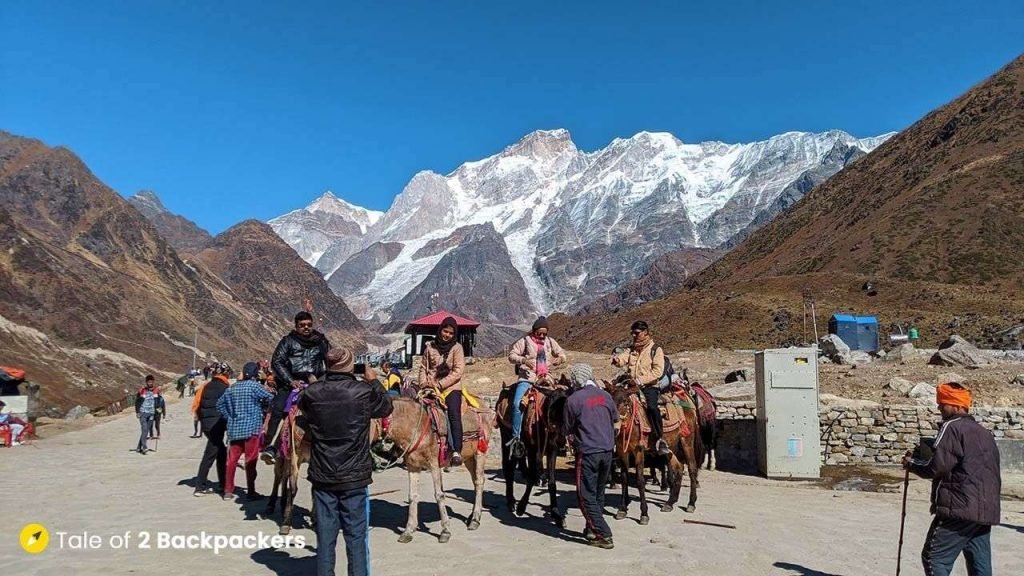
Horses, palkis , kandis and Pitthus are available from Gaurikund to Kedarnath. There is a booking office just before the starting point of the trek from where you can get them. There is a fixed rate for horses and mules. The rate for pitthus and kandis vary with weight. While you will get them easily at Gaurikund, you will also get them on the way.
Tip on riding horses/mules: Bend forward while climbing upward and bend backward while climbing down and hold the saddle tightly.
Kedarnath by Helicopter
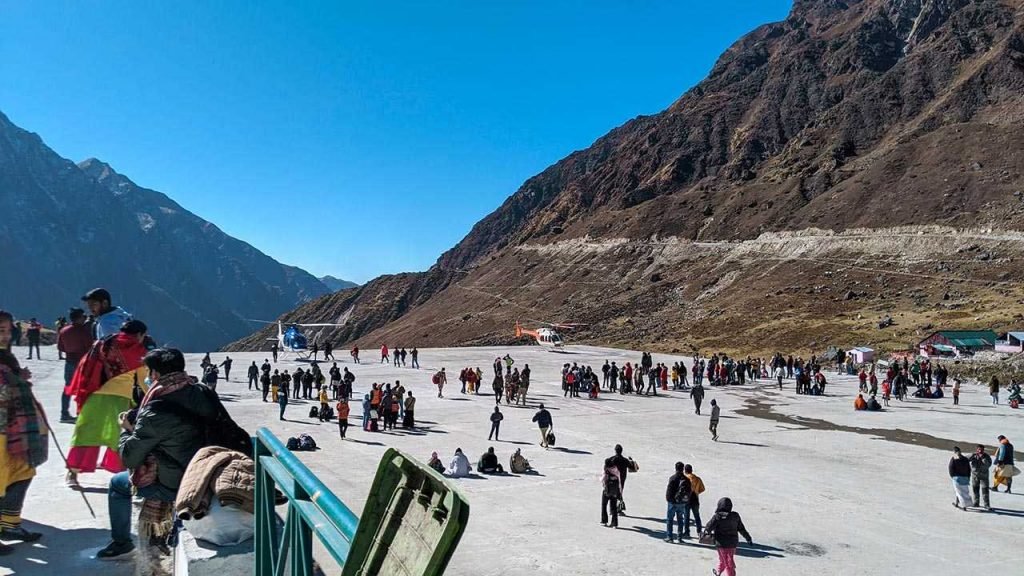
These days many people travel to Kedarnath by helicopter as well. The helipad is at Phata located between Guptkashi and Sonprayag. We found a couple of different operators providing helicopter services to Kedarnath. While Phata is the main place from where you can get helicopter rides, other helipads are found at Sersi and Sitapur. The helicopter would take you to Kedarnath Base Camp, about 1 km from the Kedarnath Temple. This distance has to be covered by foot. Even horses are not allowed beyond a certain point.
Things to remember for Helicopter ride to Kedarnath
- The helipads are at Phata, Sersi and Sitapur.
- Only 2 kg of luggage is allowed per person.
- Additional charges are levied if you weigh more than 80 kg and above 120 kg, 2 seats need to be booked.
- The price of the tickets depends on the helipad you are flying from. Usually a round trip cost somewhere between INR 5000 to 7000.
- If you get the round trip ticket for the same day, then they usually allot 2 hours to visit the temple and come back to the helipad.
- It takes roughly around 10 minutes to fly to Kedarnath Base Helipad and from there it is an easy trek of 15-20 minutes to the Kedarnath Temple.
- Helicopter services might stop at any time due to bad weather conditions.
Where to stay at Kedarnath?
There are plenty of hotels and guest houses at Sonprayag as well as Gaurikund. GMVN Guest Houses are also available and you can book them online.
GMVN Guest House and cottages are also available at Kedarnath Base Camp. There are a number of guest houses and dormitories available near the temple as well. We stayed at Bikaner Bhawan just behind the temple.
Accommodation options are also available on the way to Kedarnath. GMVN Guest Houses are available at Jungle Chatti, Bheemabali and Lincholi. Online booking is available at these guest houses and I would recommend you to book them beforehand if you opt to stay in between.
We stayed at Bikaner Bhawan in a double-bed room which cost INR 2000. Hot water is also available and a bucket would cost you around INR 60 – 70.
The rates of the guesthouses and hotels near the Kedarnath temple can change randomly. We would recommend you to book your stay beforehand if you are visiting with family.
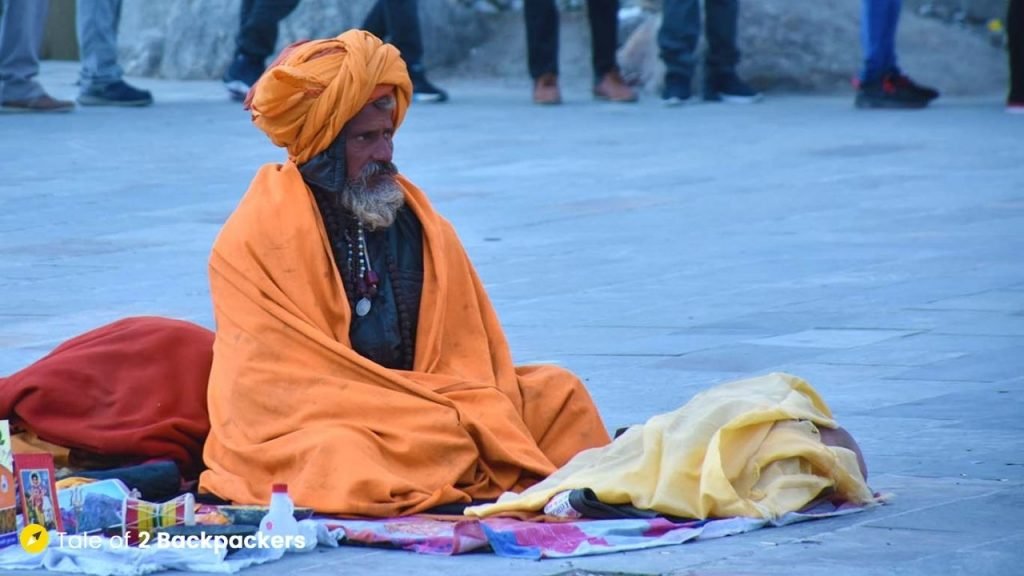
Medical facilities on Kedarnath Trek
Medical centres and facilities are available throughout the way. You can find them in between Jungle Chatti, Bheemabali and Lincholi.
Food, Drinks, Shops and Restaurants on Kedarnath Trek
Most of the hotels, guest houses and GMVN Guest Houses provide food at reasonable prices. The food available is vegetarian and quite tasty. There are many shops available all through the trek route selling Maggi, parathas, snacks and hot beverages. You will definitely not go hungry on your trek to Kedarnath.
Toilet Facilities on Kedarnath Trek
Make-shift toilet tents are available on the way at various places in the trekking route.
Is there Mobile and Internet Service at Kedarnath?
Mobile services are available at Gaurikund till Lincholi. However, it is a bit rough at Kedarnath. We found Jio and Airtel services at Kedarnath while there was no mobile service for Vodafone.
Free wifi is available at the main areas like Jungle Chatti, Bheemabali, Lincholi and Kedarnath. However, do not rely much on the free wifi services. We did not get any during our stay at Kedarnath.
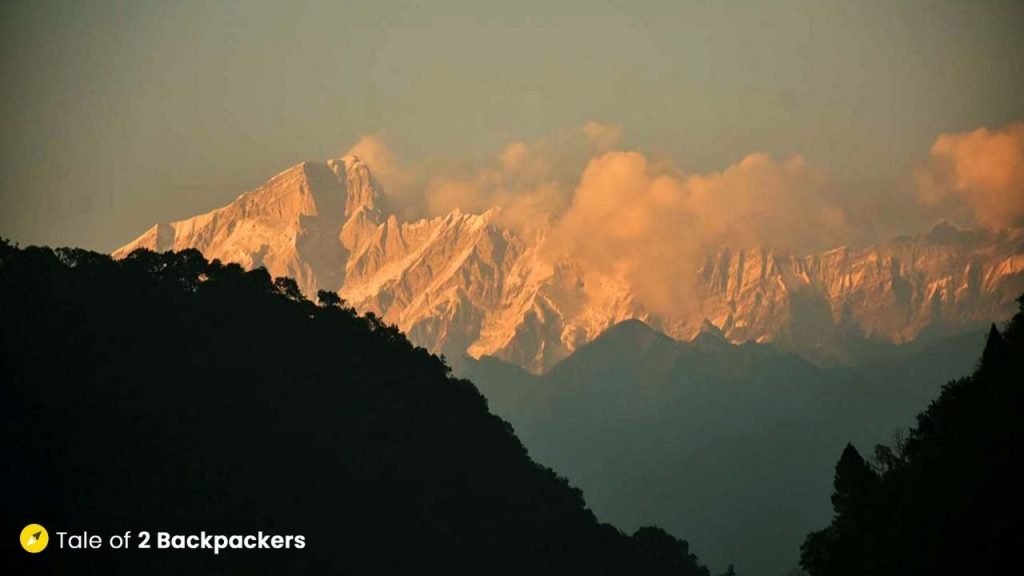
When is the best time to visit Kedarnath Temple ?
Kedarnath is a part of the Char Dham Yatra. The temple opens on the auspicious day of Akshay Tritiya (usually falls in April or May) and closes on the day of Bhai Dooj (falls in October or November). Kedarnath Dham can only be visited during this time.
Kedarnath is located at an altitude of 3553 m and remains cold most of the time. The weather is quite unpredictable in the mountains. Usually May to June and October to November is a good time for Kedarnath Trek. July to September are the monsoon months and there are chances for landslides during this time.
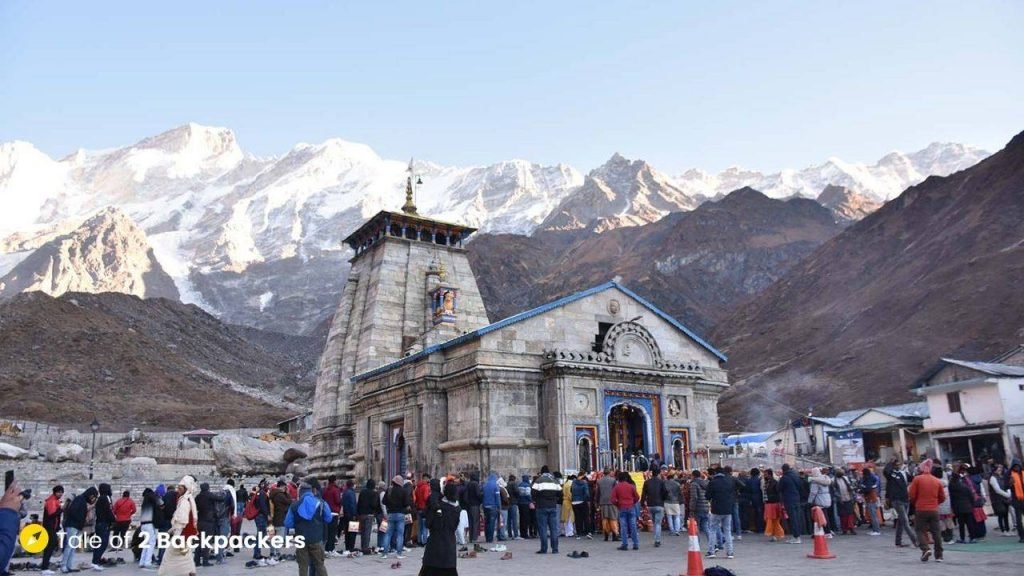
Places around the Kedarnath Temple
Bhaironath Temple
This temple is located at a very short distance from the Kedarnath Temple. It is believed that Bhaironath guards the Kedarnath Temple by keeping the evil at bay.
Shankaracharya Samadhi
This is the resting place of Adi Shankaracharya and is located near the Kedarnath Temple.
Gandhi Sarovar
About 3 km from Kedarnath Temple lies the Gandhi Sarovar that is fed by the Chorabari Glacier. If you wish to trek there, start early in the morning. The weather can change quite abruptly.
Vasuki Tal is located about 8 km from Kedarnath Temple. The trekking trail is quite steep and should be done with the help of guides. The Vasuki Taal offers a great view of the Chaukhamba ranges.
Rudra Meditation Cave
This is an interesting place. Located about 1.5 km from the temple, there is an underground cave available for meditation and isolation. The caves have a window that provides a direct view of the Kedarnath Temple. You can book the cave for yourself for the purpose of meditation for a maximum of 3 days. Obviously, only one person can stay inside the cave. The cave has all living facilities like water, electricity, heater, attached toilet and a phone to call the authorities in case of emergency.
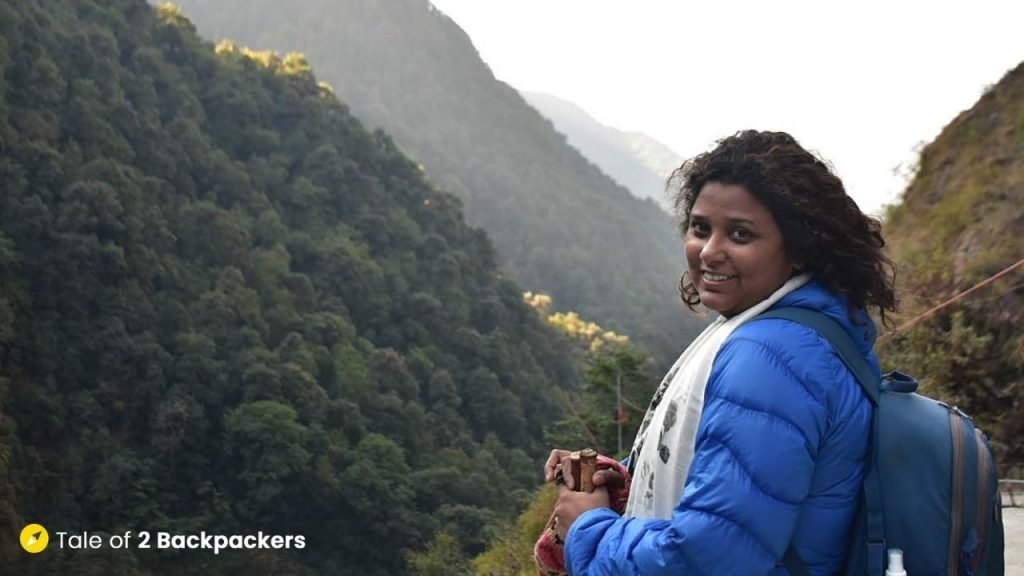
Some interesting Facts about the Kedarnath Temple
- It is believed that the Kedarnath Temple is eternally protected and cannot be harmed.
- Bhaironath Ji is the protector of the Kedarnath Temple and is known as the Kshetrapal. He is the fiery avatar of Lord Shiva and is known for devastation and destruction.
- Kedarnath is one of the 12 Jyotirlings of Lord Shiva. It is infact, the highest of all the Jyotirlings in India.
- After Bhai Dooj, when the temple is closed, the main deity is brought down to Ukhimath.
- The head priest of the Kedarnath Temple belongs to the Veerashaiva community of Karnataka and is known as Rawal. However, the head priest or Rawal does not conduct the ritual inside the temple. He only gives instructions to his assistants. The deity is transferred to Ukhimath during the winter. The puja is performed in Kannada language.
- The temple is said to have been buried under ice for almost 400 years.
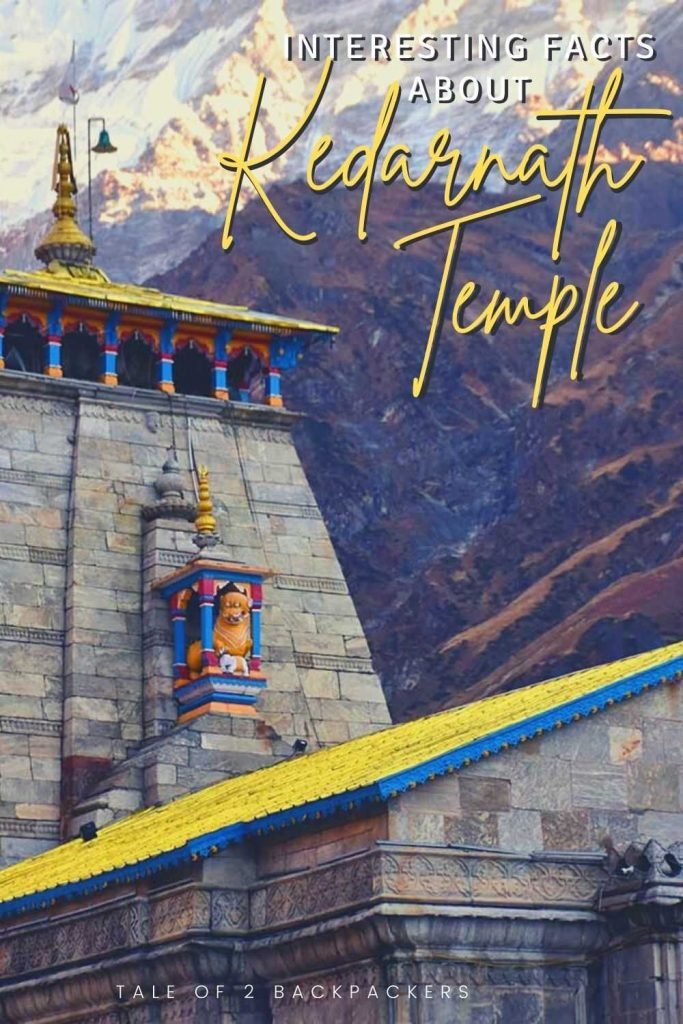
Have you visited Kedarnath? Please let us know your thoughts on this famous pilgrimage. If you liked this post and found it helpful, please share it with your family, friends and neighbours!
Pin it for a later read!
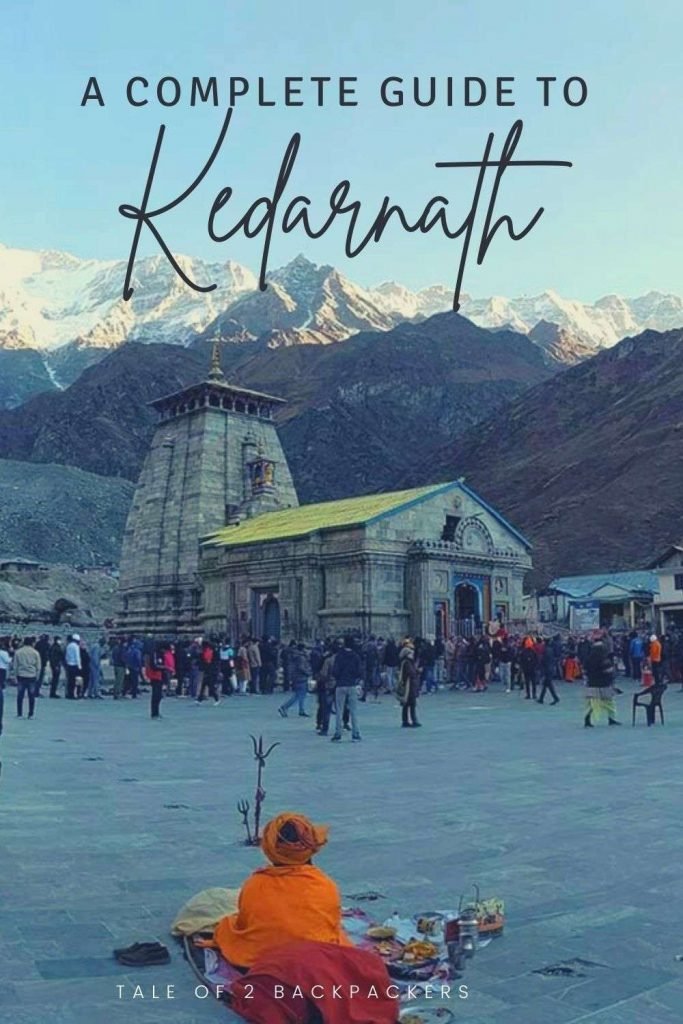
Agni Amrita
Related posts.
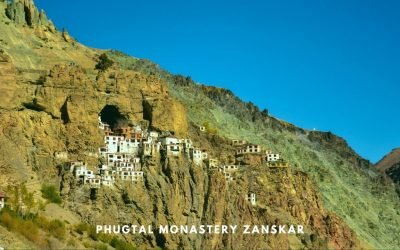
Phugtal Monastery Trek – Guide to the Cave Monastery of Zanskar

DUMAIL TREK KASHMIR – An easy hike from Naranag
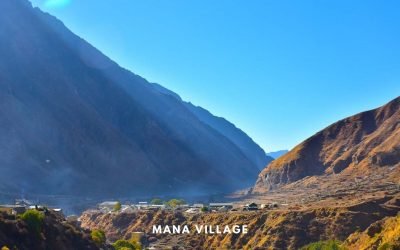
Trip to Mana Village – the Last Village of India
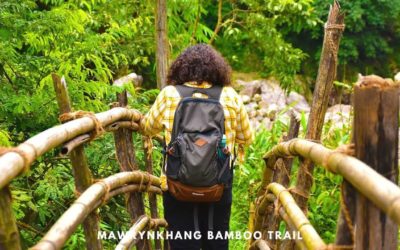
Mawryngkhang Trek (Bamboo Trail) Meghalaya – Guide to The Scariest Trek
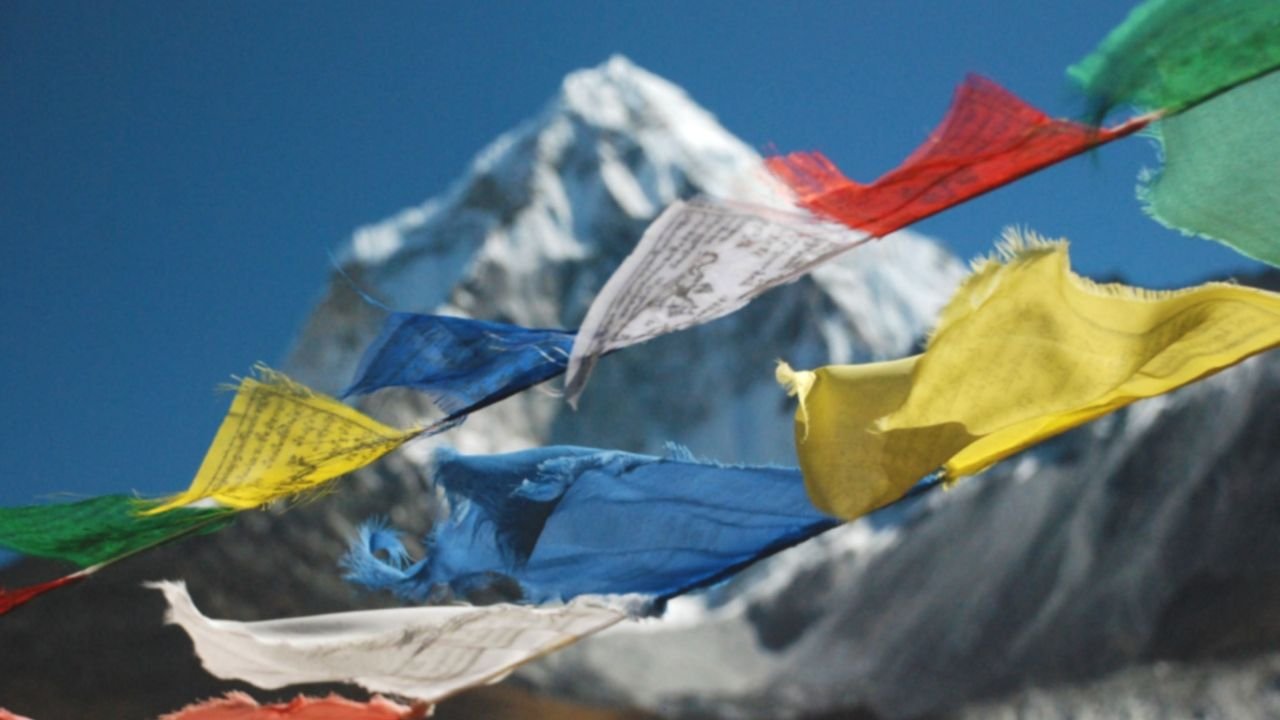
Trekking in Nepal: 15 Best Treks and all that you want to know
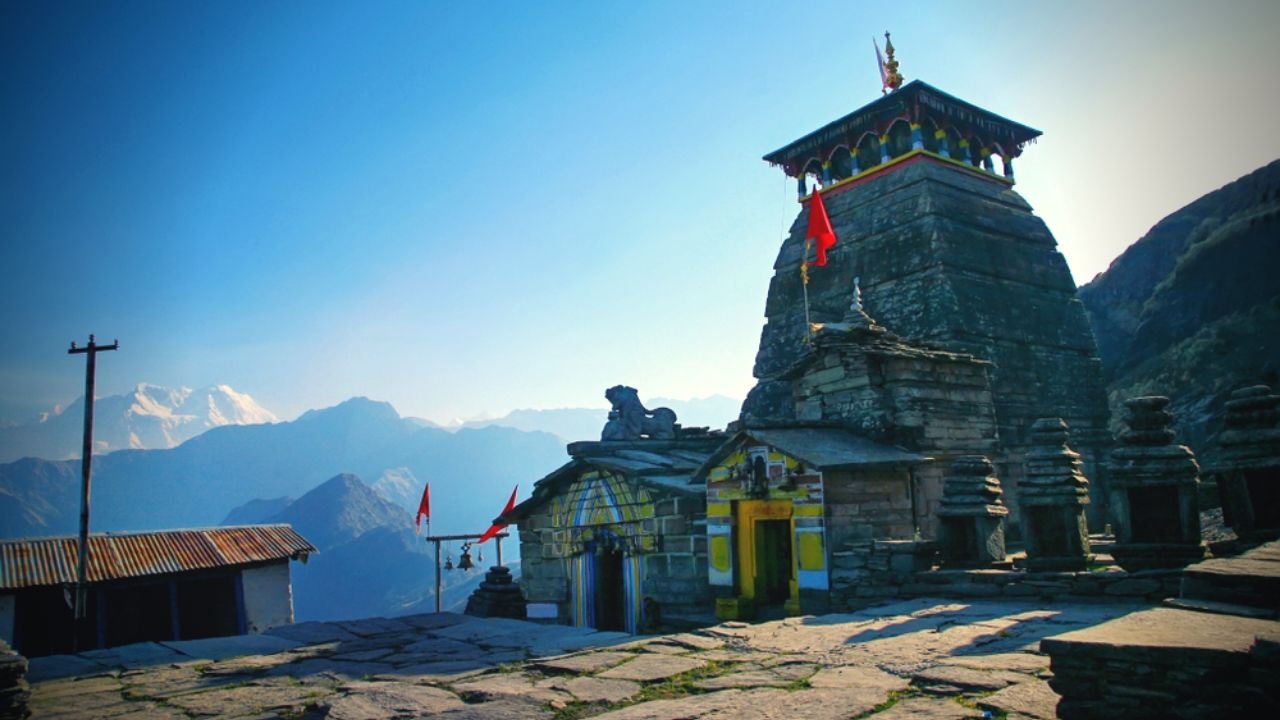
Tungnath Deoriatal Chandrashila Trek Itinerary and details (FAQs answered)
56 comments.
Beautiful content and very informative 🙂 Har har mahadev 🙏🏼
Thank you so much!
Hi, beautiful article, wish had come across your article before, just couple of days back we trekked to kedarnath, myself 55 yrs old and my husband 58 yrs. It was dream come true for me at this age, can you with your rich experience share how to treat aching legs after trek. We use coconut oil, is there any other thing which can be of help. Thankyou. God bless both of you
Hello Ma’am! We are so glad to hear that you had trekked to Kedarnath. Time and again it os proved that age is just a number! As for treating aching legs, we recommend to apply ice pack on the aching area. It will help a lot. Also keep your legs elevated for few minutes every day. Hope this helps!
Very comprehensive and informative! I think these tips and advice are much helpful. Good you explained everything in detail it has been a great help.
A captivating tale of the Kedarnath trek! The personal experiences you share make it feel like we’re trekking right alongside you. The spiritual and natural beauty of the region shines through your words. Thanks for taking us on this unforgettable adventure through your storytelling – it’s both inspiring and informative
Thank you so much for your kind words.
Hi. Its very interesting to hear from you. Congratulation for the trek. Now I booked at gourikund . Can you provide any information the proceedings before start trek from Gourikund. Thanks again.
Thank you so much for your comment. Have a great trip and let us know how it went.
thank you for such a nice, elaborate and interesting blog!! while we have been aspiring to visit Kedarnath and badrinath much in recent times, i was actually looking for a visitor’s experience and just came across yours… thank you once again.
Thank you poorna for the kind words.
Thankyou for the amazing informative content on kedarnath yatra. Everybody needs this informative content keep sharing.
Wonderfully done article..Pretty complete. I am planning to do the Kedar trek with kids 7&12 and planning to rent a car.
You have mentioned you rented a car for 5 days. Does it come with a driver or you drive on your own. Any preferred rental companies for Car?
We had rented a car with driver. We got the car from a rental service at Haridwar. It was near Haridwar Railway Station. Have a wonderful trip to Kedarnath.
Hi… felt like a movie … scenes passes thru my imaginative mind! Clear cut, lively explanation. I am visiting kedar, badri and tungnath this June. Plz help me with a trustable travel agency or travel agents number. We are from bangalore and will come thru flight. Thanks a lot I. Advance. I am inspired to write a page later.. ( in my son’s notebook.. not here 😉 ) ha ha. Will be waiting for the reply
Thank you for a very informative write up. One question, how long did it take you to trek back to Gaurikund? You mentioned you reached at 12.30, but not state the start time. Did you have time to look around in the morning before starting the trek back?
Hello Sharmila! Thank you for reading our blog! And thank you also for pointing out the time. We had reached Gaurikund by 2PM and not 12PM. It was typo error. Now we have corrected it. We had started around 8.30AM after attending the morning aarti and just roaming around the place.
Woooow so nicely explain every minute details. This will help us a lot for sure for our planning.
Nice Blog…. This is really amazing. Great information about Kedarnath trek.
It’s amazing blog and very informative about Kedarnath trek….. This blog will very helpfull for newbies.
Amazing Blog… many things to learn. thanks for sharing.
Good Luck for the upcoming update.This article is really very interesting.
One of my biggest dreams is to go to Kedarnath and in this blog, I got all the information for my next trip. And all the images are extremely beautiful. Thank you so much for sharing all this wonderful info with us.
Thank you so much Shivani! We are so glad you liked our blog.
Hi, How can we book hotels near the temple in Kedarnath? You mentioned that it’s better if done ahead of the travel?
Can it be done online?
There are a few websites from where you can find out the contact numbers of the hotels near Kedarnath Temple. But I doubt whether it can be done online. There are also a number of travel agents in Haridwar and Rishikesh from where you can get your stay. Thank you for stopping by our blog. Keep reading!
this is a great read, very engaging and informative. I have a quick question regarding the stay at Kedarnath, you mentioned your stay at Bikaner house, is there any way to pre-book it?
Thank you so much for the comment. I think the stay at Bikaner House can be pre-booked. Please try calling +91-8191900012.
Amazing Blog, Thank for sharing this wonderful website with us.
I felt as if I were doing the trek with you as I read this. Beautifully covered with useful tips within. I have been meaning to get here and now am even more tempted. Loved your pics of the Sonprayag and the various trekking spots. The history and legends around this place really make it special. I knew the bit about Mahabharat and Shankracharya but did not know about how it was discovered
Thank you so much, Ami!
I’m hoping to go on Kedarnath Yatra after a couple of years. Good to know that they trek is about 16-17km and can be done in a day and there are also some accommodations on the way. Hahaha, it is funny and awesome that you visited Kedarnath as a kid and now your dad managed to give all the embarassing details to Agni. Now that I travel with my toddler, I have quite a bit of such funny and embarassing moments. Hoping to pass it on to her partner in future… Am I evil? Hahaha..
I bet you are! Just imagine my embarrassment when my dad gave all my secrets to my hubby. And he teases me with those till date!
Oh my God! I am bookmarking this post. Kedarnath has been on the top of my list. I want to hike and visit this amazing place, especially to hike. And also take my mother as she loves these kinds of religious places even though I would send her to the temple by other means and not by hiking. Thanks for this post, I will try to visit it as soon as the pandemic is over.
Thank you, Raksha! I am sure you will love Kedarnath.
What a great travel story and also a guide for those who want to do this trek. The views are absolutely breathtaking! And I love all those hidden little stories you mentioned. This trip also get a very personal feeling as other family members told you all those stories. The temples are all beautiful.
Thank you so much, Paula!
So interesting to read about the Kedarnath Yatra pilgrimage. And great to return to a trek that brings back special family memories. I can certainly see why the scenery along the river way to the start of your trek intrigued you. It looks like an interesting trek up to the Kedarnath Temple. Even if there was snow along the way. I might want to visit by helicopter and see those amazing views from above.
Helicopter ride is a good way to reach the place for those who cannot hike. Thank you Linda for the lovely comment!
What a fantastic experience! You provided so much information about Kedarnath, I feel like I could go and have a good idea of what to expect. I think the Kedarnath Trek sounds fascinating, although it must have been tiring the cultural experience and natural views must have been worth it.
Thank you Chloe! Kedarnath trek is quite an experience.
This is a great comprehensive guide! We have never heard of Kedarnath Yatra, but it looks like an interesting place to discover. Spiritual, historic and hiking all in one trip? That sounds like our kind of thing. We’ll definitely include this in our India itinerary when it’s safe to travel.
Wow just look at those mountains. I would love to do this hike and when I visit India I need a long time to see the beautiful places in this country. This looks like a great 2 day and worth it and the views must be amazing during the whole trek. I hope I get to visit one day as it looks amazing.
That I totally agree to. You will need a lot of time to explore India! Thank you for the lovely comment!
I never heard of the Kedarnath and after this in-depth description and experience, I would love to do a trek here. I love a hike with beautiful mountains and culture combined and this has it. The backdrop to the temple is truly amazing and I would just go to the temple just to see that. A lot of information here to consider as well, so I have bookmarked this page as I hope to do some hiking in India once Covid clears off. This part of the world has been on my list for a long time.
Thank you Danik! Kedarnath is one of the spiritual places in India and is absolutely gorgeous.
This is by far the most amazing blog I found on Kedarnath yatra. All the information is quite helpful. I almost felt that I am right there with you on the trek.Thanks for writing.
Thank you so much, for your kind words.
Descriptive blog about Kedarnath, valuable info shared for first-time travelers. Trekking in Kedarnath is an exciting and adventurous journey where you can avail all the accommodation as well as camping facilities with an awestruck top view from hills. Worth visiting along the trails to experience the local life.
Submit a Comment Cancel reply
Your email address will not be published. Required fields are marked *
Submit Comment
This site uses Akismet to reduce spam. Learn how your comment data is processed .
Pin It on Pinterest
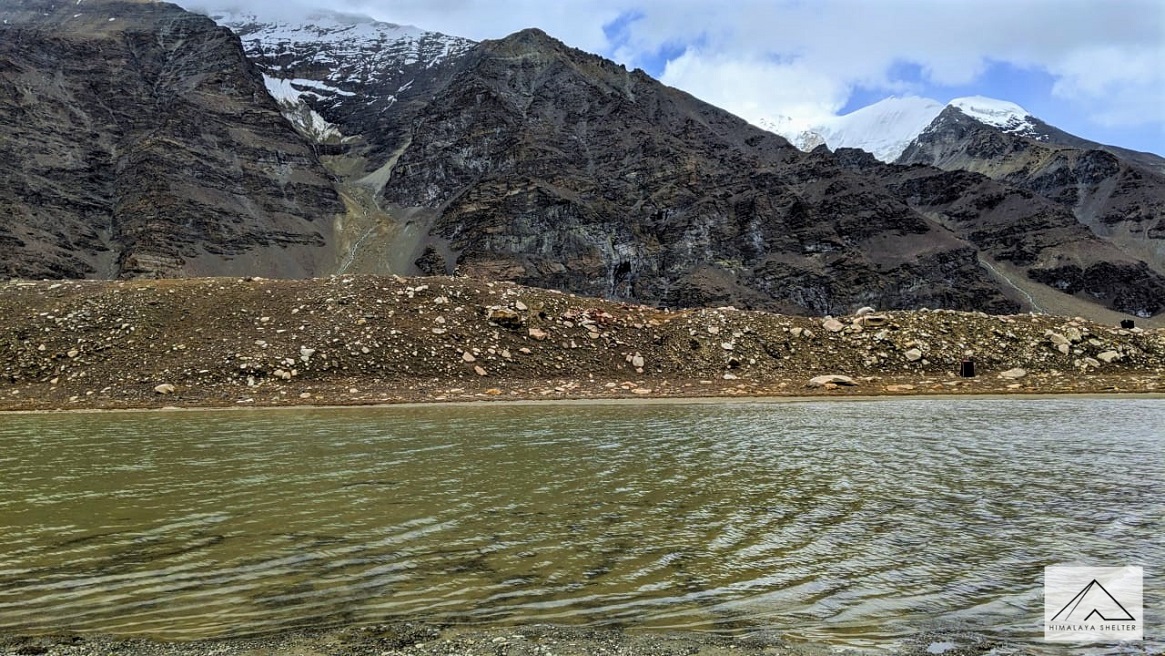
Vasuki Tal – Kedarnath Trek
Vasuki tal with kedarnath yatra, best spiritual treks in uttarakhand, vasuki tal – kedarnath trek via mayali pass, masar tal – painya tal and khatling glacier, day 1 drive from dehradun to ghuttu.
Drive: 188 km, 8-9 hrs
Accommodation: Guest House/Hotel
Meals: Dinner
We all embark on this adventure to attempt Vasuki Tal Trek as soon as everyone has reported. Today’s drive takes you across the tributaries like Rispana River, Song River, Chandrabhaga, Bhagirathi, and Bhilagna Rivers. Each of these rivers offers surreal sights of the valleys carved by them. However, Tehri Dam, located on the Bhagirathi River, is usually the star of this route. The green, calm waters of the dam would accompany you for almost about 5-6 kilometers on your left. After Crossing the Zero Bridge, we would leave Bhagirathi behind and follow the course of the Bhilagna River all the way to Ghuttu Village.
Small towns and villages like Talai, Bagar, Chamba, Tehri, and Ghansali are perched along the mountain roads. You may choose to withdraw cash or complete any last-minute shopping during the small breaks on this journey.
Our destination is a rural site in Ghuttu Village which is located across the Bhilagna River. This would be our base camp from where we shall start Vasuki Tal Trek. Relieve all the tiredness of the journey by soaking in the serenity of this village.
Day 2 Trek from Ghuttu to Dhu Panda
Trek: 13 km, 7-9 hrs
Accommodation: Camping (Alpine Tents)
Meals: Breakfast + Lunch + Evening Snacks + Dinner
The cacophony of the chirping birds in the village would announce the morning in this village. It is a long yet easy leisure trek to Dhu Panda. You shall be crossing remote Garhwali villages and some hillside plantations. The mild ascent on this day prepares you for the more strenuous climbs ahead. It is of utmost importance to start mildly for longer trekking journeys like this. Almost throughout the trek, you may relish the view of Rhododendron forests till your eyes can see.
Day 3 Trek from Dhupanda to Panwali Bugyal
Trek: 6 km, 3-5 hrs
Bugyals are the unique beauties that Uttarakhand is blessed with. Panwali Bugyal is one of such less-explored gems of the Northern Garhwal Himalayas. It offers much more than just a trekking experience. It is a high-altitude landscape of rolling meadows at 3963 metres. The trek till here is moderately difficult but the view compensates for every single effort of reaching here. It is not even an exaggeration to call Panwali Kantha an amphitheater. Many people opt for the Panwali Kantha Trek for mesmerizing views.
It offers a 360-degree view of the major ranges like Kedar, Gangotri, Yamnotri, and Badri. The prominent peaks that you can spot are Kedar Dome, Thalaysagar, Kirti Stambh, Chaukhambha, Meru, and Nilkanth. The spring season covers the meadows with colorful flowers like poppies, daisies, primulas, anemones, and of course, rhododendrons of all varieties. It feels nothing less than a green canvas of grass painted with purple, pink, red, and yellow dancing flowers. Many of these flowers, bushes, and plants have herbal cures. Don’t be surprised to find local Vaidyas and saints plucking some of these plants to survive the tough year ahead. Most trekkers often choose Panwali Bugyal for the spectacular sunset that makes everything sparkle bright-golden.
On the other hand, winters paint all the peaks and meadows snowy white. If you love wildlife, prepare yourself to spot some rare musk dears and wild animals like Bharal, bears, weasels, and Ghoral.
Day 4 Trek from Panwali Bugyal to Talli
Trek: 8 km, 4-6 hrs
For today’s trek, we shall descend towards Gangi village. The trail is well carved. You may want to be extra careful if it has rained. We shall be crossing open trails that offer a view of the widening valley down below. Some stretches also pass through dense vegetation and tall pine trees. This is an apt trail to hear and spot the local birds of the region. Gurgling waters of small streams running down the hills add to the music of the forest. Talli would be our campsite for today amidst the abundance of nature.
Day 5 Trek from Talli to Gangi
Trek: 8 km, 6-7 hrs
This day involves a reasonable amount of ascent to reach Gangi Village located at an altitude of 2,465 metres. You will initially trek through a stretch of a dense forest crossing small streams. After about 3-4 hours, the plantations and the remote Garhwali villages start to appear. Walking along the village canals and water channels amidst the swaying fields of potatoes, rajma, and other grains is exhilarating. During the early summers, these fields are full of fragrant flowers. Finally, after a short climb, we reach a village where time stands still. Gangi Village shall be our rest point for 2 nights.
Day 6 Gangi (Day for rest and leisure)
After the challenging treks of the past few days, it is extremely important to rejuvenate your body. It is crucial to restore energy for more challenging trekking in the coming days. Gangi is a village untouched by modernization. It is a sleepy hamlet with a mere population of around 300+ humans. Age-old tiny wooden temples, overlooked by giant mountains sprinkled with snow, are the main attractions here. Terraced fields and the wafting fragrance of flowers become your leisure-time buddies. Enjoy this village while chatting with the elderly of the village. They have hundreds of tales to tell you about Devbhoomi Uttarakhand. Alternatively, you may chase the hopping sunbirds and squeaking magpies on the outskirts of the village.
Day 7 Trek from Gangi to Kharsali via Biroda
Trek: 11 km, 6-7 hrs
After a rest day at Gangi, we shall descend down to their winter settlement, Deokhri Channi. Further ahead, the path passes through a dense forest. The mix of mild ascents and descents enables you to enjoy the calls of Himalayan birds. To your delight, you may be able to spot Himalayan Monal, Warbler, Coppersmith Barbet, Blue Magpie, and a variety of Parakeet species.
The gurgling sound of the beautiful Kalyani stream would suggest the vicinity of today’s destination. Refill the bottle here or relax for a while in its refreshing waters. After crossing the stream, we reach the diversion. From here, the left trail stretches to Sahastra tal. It is an idyllic location that hides this isolated lake of Uttarakhand. If time permits, we may pay a quick visit to this lake. Otherwise, we must follow the right trail. The dense forest opens on your way to vast meandering meadows. This is Biroda Bugyal. Enjoy the stunning paradise created by wavy hills and evergreen conifers. 3-4 kilometres ahead of this bugyal lies our campsite for the day. Soak in the immaculate charm of mother nature here. In the evening, savour the spectacular colours of sunset. Prepare for the next morning and sleep cozily while listening to the music of the rustling leaves.
Day 8 Trek from Kharsali to TambaKund
Trek: 8 km, 7-9 hrs
After a scrumptious breakfast, we start hiking along the trail carved beyond the village. The trail is relatively flat till the river bank. It passes through the rolling meadows in the beginning. After that, we start the ascent to a barren mountain patch devoid of vegetation. The view of the snow-capped mountains would accompany you throughout the day. Small snow-fed streams keep crossing your path. Don’t forget to spot the distant waterfalls tumbling down the Bhilangana Range.
Finally, after 8 hours of moderately difficult climb, we reach a serene spot at Tambakund. Tambakund is a small pond that can be considered the source of Bhilangana River. Relax in the evening, relish a hot dinner and prepare for tomorrow’s trek. Khatling Glacier, that feeds the river, is just 3 kilometres from this campsite. We shall spend the night under the stars at Tambakund.
Day 9 Trek from Tamba Kund to Tambakund via Khatling
Trek: 3 km, 4-5 hrs
Today, we proceed for a mildly strenuous trek to Khatling glacier located at an altitude of 3415 metres. It is the birthplace of the Bhilangana River that nurtures the human settlements in almost half of the Northern Garhwal Region. Khatling Glacier is one of the largest glaciers in the Himalayas. From Tambakunda, the trail starts over the wooden bridge across the river. The trail traverses through the grassy meadows of Chowki. It is frequented by shepherds who come here to feed their herds of sheep. The valley is dotted by flowering plants including that of Brahma Kamal during its blooming season. You might spot certain wild moths and butterflies along this route. It may take around 2 or more days to explore the glacier entirely. We shall aim for the ‘Zero Point’ at this glacier. It is an enchanting viewpoint in the lap of this giant icy glacier. After having enjoyed the beauty of this place for some time, we shall proceed to trace the path back to Tambakund.
Note: You shall not carry all your luggage today and have a relaxed climb by just carrying the essentials.
Day 10 Trek from Tambakund to Masar Tal
Trek: 7 km, 8-10 hrs
We start today’s trek early. Eat well to energize yourself for the steep ascent of the day. From Tamabakund, via Chowki, we keep climbing throughout the day. Post-lunch, you would see the Khatling glacier and milky-white waters of the Doodhganga River below you. The shining waters of Bhimtal Lake can also be seen down below.
Masar Lake is a small pond tucked amidst the painting-like backdrop of the lofty mountains of the Kedar Range. The picturesque woodlands and carpeted green meadows enhance the beauty of this lake. The cherry on the top is the wild flower blooming in this bugyal during monsoon. If luck favors, this campsite near the lake is perfect for star-trail photography or Milky Way spotting on a clear night.
Day 11 Trek from Masar Tal to Painya Tal
Trek: 8 km, 8-12 hrs
Usually, trekkers opt for a long tiring trail from Masar Tal to directly Vasuki Tal. However, our itinerary of Vasuki Tal – Kedarnath Trek allows you to enjoy the best of this trail at your pace. Today, the strenuous climb continues amidst snow-clad and brown mountains. You may want to capture this unusual shading of the mountains giving them an appearance of Vanilla-chocolate ice-cream. The trail is flanked by huge boulders and rare vegetation. After a few hours of trekking, we reach the windy Mayali Pass across Mayali glacier. Painya Tal and Teental can be reached only after this tricky climb. The soul-captivating scenery at Painya Tal would make all the mind-numbing efforts worth it. Relieve all your tiredness and re-energise yourself by resting at the bank of Painya Tal. Alternatively, you may take a short hike to Teen tal. The whole trek to Painya Tal passes through Kedar Wildlife Sanctuary. You may be able to spot bears, snow-leopards, jackals, wild boar and other high-altitude reptiles.
Day 12 Trek from Painya Tal to Vasuki Tal
Trek: 6 km, 5-6 hrs
The most-awaited day is here. Today, we shall aim to reach the legendary Vasuki Tal perched in the lap of Mt. Vasuki. The peak gets its name from its serpentine shape and the folklore. According to the legends, Vasuki Nag would often sit here and let the Devtas use its tail to churn out the elixir of immortality from the oceans. This lake is the source of the River Vasuki Ganga which further merges with Mandakini at Sonprayag.
Tre trek is no cakewalk though the distance is just 6 kilometers. The ascents and descents on this day may tire you but the unraveling vistas fuel your soul with divine energy. Merely after 5-6 hours, the ultimate destination is unveiled in front of you.
Take a hot cup of tea, walk to the lake, and sit there for the entire evening. The musical movement of the lake creates a shaky reflection of the snowy mountains. The clear sights of the holy peaks of Sumeru, Meru, Manda, and Chaukhambha from the base of Vasuki Tal is sheerly soul-stirring. At night, don’t forget to be flabbergasted at the lake reflecting the magical sky crammed with twinkling stars.
Day 13 Trek from Vasuki Tal to Kedarnath
Trek: 6 km, 4-6 hrs
Accommodation: Camping (Alpine Tents) / Guest House
The route from Vasuki Tal to Kedarnath is a complete descent. Nonetheless, there is no dearth of adventure on this route. Once you bid adieu to the pristine sight of Vasuki Lake, the real challenge begins. It is the time to hold your breath to cross the two glaciers namely, Chaturangi Glacier and Vasuki Glacier. The precarious narrow trail requires the trekkers to take every step vigilantly. Apart from this little adventure, the rest of the trail demands careful descent. It is crucial to not hurt your ankles or knees owing to immense pressure. Thus, the trekkers are advised to follow the guides’ instructions.
Post this thrilling day, a divine sight of the Kedarnath Jyotirlinga awaits you. After reaching the lodge, freshen up to visit the temple. The black-stone structure sings the glory of devotion and art of ancient India. Kedarnath Temple, located at an altitude of 3,583 metres, is believed to have been built by Pandavas. The legend of the Temple is closely related to the Panch Kedar Legend. During the repentance period, post-Mahabharat, Pandavas were seeking Lord Shiva. After hiding for days at Guptkashi, Shiva was finally spotted by Bhima in the form of a bull. However, before they could reach the Bull, it disappeared. It then reappeared at different places in the valley which are now known as Panch Kedars. Kedarnath is the first of these five temples. The hump of the bull appeared here and the lord is worshipped here in the same form.
Do not miss the sunset at this divine site. The Kedar Dome is tinted with the hues of saffron and then pink as the Sun God prepares to set. This holy view accompanied by the vibrating sound of temple bells creates meditative vibes in the atmosphere.
Day 14 Trek from Kedarnath to Rudraprayag via Gaurikund
Trek: 14 km, 6-7 hrs
Get up early in the morning and devour the beauty that surrounds you. The awe-inspiring sight of Sumeru, Kedarnath Peak, and Kedar Dome is the most divine thing in the Himalayas. Experience the morning vibes of this most-visited pilgrim of Uttarakhand.
Post-breakfast, trace down the path, along the course of river Mandakini that flows on your right. After many days, you would finally hear the chirping of birds, tinkling bells of the ponies, and chanting of the pilgrims heading for Kedarnath temple. This narrow valley created by Mandakini is fed by a number of waterfalls along the route. The flock of birds bathing in the waterfalls can be seen only on this trail. Crossing the rainbows on your way is also a unique phenomenon on this trek.
By noon we reach the base at Gaurikund and board the vehicle for the return journey. A motorable road from Gaurikund via Guptkashi takes us to Rudraprayag. One of the holy Panch Prayags, Rudraprayag, has numerous legends to tell. The name of this Prayag is attributed to the Rudra form of Shiva. He is said to have performed tandav at this Prayag. Apart from the mythological mentions, Rudraprayag was widely popular among wildlife lovers. The town has now modernized way too much with the ever-expanding construction sites. However, once upon a time, the wild tigers from the Kedar and Tungnath Forest range roamed till Rudraprayag. One such man-eating wild tiger mentioned by Jim Corbett resided right here at Rudraprayag.
Day 15 Drive from Rudraprayag to Dehradun via Rishikesh
Meals: Breakfast
Post-breakfast board the vehicle and reach back to Dehradun/Rishikesh/Haridwar by evening and depart with the fond memories of the Vasuki Tal – Kedarnath trek etched in your heart.
Day 2 How difficult is the trek & what are the challenges?
What is the best time to do the trek and how is the weather, what are the top highlights of the trek.
- Transport support from Dehradun to Dehradun
- Pick-up location: Prince Chowk, near Dehradun Railway Station Pick-up Time: Around 7:30 am
- All vegetarian meals starting from dinner on day 1 to breakfast on the last day
- Professional Guide, Cook and Support staff
- First-Aid kit with Oximeter and Portable Oxygen Cylinder
- Kitchen tents, common tents, toilet tents with portable toilet seats
- Rent for camping equipment like Clean sleeping bags and foam mattresses, Good quality ‘A’ shaped or dome tents, Camping stools, Table and Crampons and gaiters if required
- Forest entry charges for Indian nationals (Additional charges will be applicable for international tourists)
- Porter and mule support to carry camping equipment and personal luggage
- Accommodation throughout the trek on a triple-sharing basis
- Guesthouse accommodation on the first and second last day on a triple-sharing basis
- All applicable taxes
- Your designated hotels may not reopen by the time you reach there. While we are making alternate arrangements, do understand that things may not be as “tip-top” as our designated hotels.
- The gurudwara, Hemkund Sahib may not be open. While we are trying to take permission to go to Hemkund Sahib, if it does not happen, then do understand that the pandemic has put restrictions beyond our control.
- Personal expenses like tips, personal medicines, phone calls etc.
- Any transport support during the trek apart from what is included above
- Any cost or services not mentioned in the Inclusions
- Accommodation in Dehradun
- Adventure Insurance
- Cost arising due to unforeseen incidents like bad weather, medical evacuation, roadblocks etc
- Porter and mule support to carry personal Luggage can be arranged at an additional cost of INR 350 per bag per day (weighing up to 12 kg)
- Please carry a lunch box for packed lunch/breakfast to avoid using polythenes and Aluminium foils. Keeping the Himalayas clean is our own responsibility. Reduce the use of Plastic when you are in the abode of the Sacred Himalaya. 🌱
Upcoming Treks
- 17-07-2021 to 23-07-2021 open
- 17-07-2021 to 23-07-2021 close
Send Request
Your query has been successfully registered. we will contact you within 24 hours., something went wrong.try after sometime..

IMAGES
VIDEO
COMMENTS
Kedarnath Trek Distance and Time. The distance of the Kedarnath Trek is around 16 km (one way) from Gaurikund to Kedarnath Temple. The trek can be completed in a minimum of 2 days, with a one-night halt at Kedarnath, or it can be completed in a single day by experienced trekkers. ... Up-Down Daily Timings by the Temple Authority. Last Timing ...
Normally, Pilgrims have to start trek before 1:30 pm from Gaurikund to Kedarnath. No pilgrims will be permitted to trek after the last minute. Also pilgrims coming down from Kedarnath have to leave before 05:00 pm. The decision is taken for the safety of pilgrims. Note : The timings for Kedarnath Trek changes as per weather conditions. DM ...
Day 1: Departure from Delhi, reaching Gaurikund by evening for an overnight stay. Day 2: Trek from Gaurikund to Kedarnath, visiting the temple and exploring the surroundings before retiring for the night. Day 3: Return trek from Kedarnath to Gaurikund, followed by the journey back to Delhi.
The Kedarnath trek from Gaurikund starts at 4 am early in the morning and goes on till 1:30 pm in the afternoon and these timings are fixed since Kedarnath Dham is located inside the Kedarnath wildlife sanctuary and this is the reason why pilgrims are not allowed to trek any time after this. After the said time no pilgrims are allowed to leave.
Morning Departures, Afternoon Cutoffs. Pilgrims embarking on the sacred journey must heed the call of dawn, commencing their trek from Gaurikund to Kedarnath before the clock strikes 1:30 pm. This time window ensures ample daylight for progress while mitigating the risks associated with traversing mountainous paths after dusk.
Itinerary. Day 1: Rishikesh to Guptkashi. Drive Distance: 183 km. Drive Time: 7-8 hours. Altitude: 4,500 ft. Your spiritual journey commences as our team picks you up from Rishikesh, a vibrant city that sets the stage for this remarkable adventure.
The ideal time for the Kedarnath Trek is during the months of May to June and September to October. The weather during these periods is relatively mild, offering clear skies and pleasant temperatures. ... When considering the Kedarnath Trek, the choice between embarking solo or joining a group trek comes down to personal preferences and desired ...
Introduction. Kedarnath, a sacred Hindu temple nestled in the lap of the Himalayas, is not only a spiritual haven but also a trekker's paradise.The journey to this revered shrine is a test of both physical endurance and spiritual devotion. In this article, we will delve into the optimal time for the Kedarnath trek and provide valuable insights for a memorable pilgrimage.
We have listed them down for you! •Get your medical checkup done before the trek. You are advised not to trek if you have blood pressure problems and respiratory disorders. •Try to complete the trek between the stipulated time frame of 4 am to 1.30 pm according to the government rules.
The Kedarnath Trek is a moderate to difficult 18-kilometer trek that necessitates a reasonable level of physical fitness. Ideally, you should be starting the trek at around 4:30 a.m. so you can finish it by 2pm. Since Kedarnath is located within the Kedarnath Wildlife Sanctuary, visitors are not authorised to visit at any time.
Kedarnath (3,553 metres, approximately) is a Hindu temple dedicated to Lord Shiva located in the Rudraprayag district of Uttarakhand. It lies just below the base of the mighty Kedarnath peak (6,940 metres), and is the First Kedar to be visited in case you are staying true to the sequence of the Panch Kedar circuit.
The Kedarnath Trek is a 18km medium to steep trek which requires a good level of physical fitness. Before going for the trek every pilgrim has to get themselves checked that whether they are capable of trekking or not. Timings of Kedarnath Trek from Gaurikund commences from 04:00AM in the morning till 01:30PM.
Kedarnath Trekking Time. The trek to Kedarnath begins from 4 AM, early in the morning and continues till 1:30 PM in the afternoon. ... Remember not to carry heavy baggage during the trek because it may slow down your trekking pace. Follow the complete trek guide to Kedarnath to avail a smooth and flexible Kedarnath trek with Shrine Yatra.
Day (13°C to 18° C) Night (0°C to 7°C) Altitude: 3583 m. Trek Weather. Winters are covered with snow summits and peaks whereas summers experience higher temperatures. Best Time: April, May, June, September, October, and post monsoon season, which occurs after and before the temple gates open and close. Trek Level:
The best time for the Kedarnath trek is from May to June and September to Oct/Nov (till Diwali). During May and June, the weather is pleasant, and the snow starts to melt, making the trekking trail more accessible. ... Is it possible to trek up and down the same day (during May-June) if your fitness is good. Means you start early in the morning ...
Ideally, I would suggest you complete the route in the day time itself, and spend the night at Kedarnath! The trek distance from Kedarnath temple is 8 KMs, initial 3-4 KMs is easy before the ascend begins. ... Deity each year. The temple itself lies at the base of the Kedarnath Peak, facing the Kedar Parvat. A beginner level trek, Kedarnath is ...
Reminder, start your Kedarnath hike early in the morning as you can hike between 4:00 am and 1:30 pm and no later. That is because Kedarnath Dham is located within the wildlife sanctuary and pilgrims cannot walk outside of this time period. Also Read: Complete Guide to Majestic Mountain Kedarkantha trek- Ngtraveller.
The trek to Kedarnath Temple is an adventurous and spiritual journey that attracts thousands of devotees and nature enthusiasts every year. The trekking route typically begins at Gaurikund, which is the base camp for the Kedarnath Yatra. ... you can spend some time exploring the area and admiring the natural beauty that surrounds it. The temple ...
The trek to Chorabari offers serene views of the surrounding mountains and glaciers. Bhairavnath Temple: Situated around 1 km away from Kedarnath Temple, this temple is dedicated to Bhairava, a fierce manifestation of Lord Shiva. It's believed that visiting this temple is essential for a complete pilgrimage to Kedarnath.
Travel from Guptkashi (Altitude 1,319 m) to Gaurikund (Altitude 1982 m) and then Trek to Kedarnath (Altitude 3583 m) Altitude: 1,319 m to 1982 m to 3583 m Distance: By Road - 15.3 km & Trek - 14 km Duration: By Road - 1 hr 12 min & Trek - 6 hours Start your morning with a delicious breakfast and feel energized to start the most important day of your trekking tour when you will finally trek to ...
Kedarnath is one of the 12 Jyotirlings of Lord Shiva. It is infact, the highest of all the Jyotirlings in India. After Bhai Dooj, when the temple is closed, the main deity is brought down to Ukhimath. The head priest of the Kedarnath Temple belongs to the Veerashaiva community of Karnataka and is known as Rawal.
It is a medium to steep trek. There are fixed timings for the trek; 4 am to 1.30 pm, to coincide with the time slots of the sanctuary. The 800-m uphill trek from Kedarnath to Bhairavnath Temple or Bhairon Baba Mandir also falls on this route and offers magnificent views of the Kedarnath Temple and the verdant Kedarnath Valley.
Vasuki Tal - Kedarnath Trek Via Mayali Pass, Masar Tal - Painya Tal and Khatling Glacier. Vasuki Tal, at an altitude of 4800 meters, has been a cynosure of trekkers eyes since the time immemorial. The divine lake even lured the Devtas and celestial nymphs who came here to procure the magical waters. The lake is cocooned amidst the rugged ...